Masai Mara National Reserve, Kenya
Alison and I were very fortunate to recently spend three days in the Masai Mara National Reserve in the southwest of Kenya. The trip was through the auspices of Adventures Abroad, the Canadian company we often travel with, and their Kenyan based provider Discover Safaris. There were only five of us all told and we had a fantastic guide in Richard Warukira.
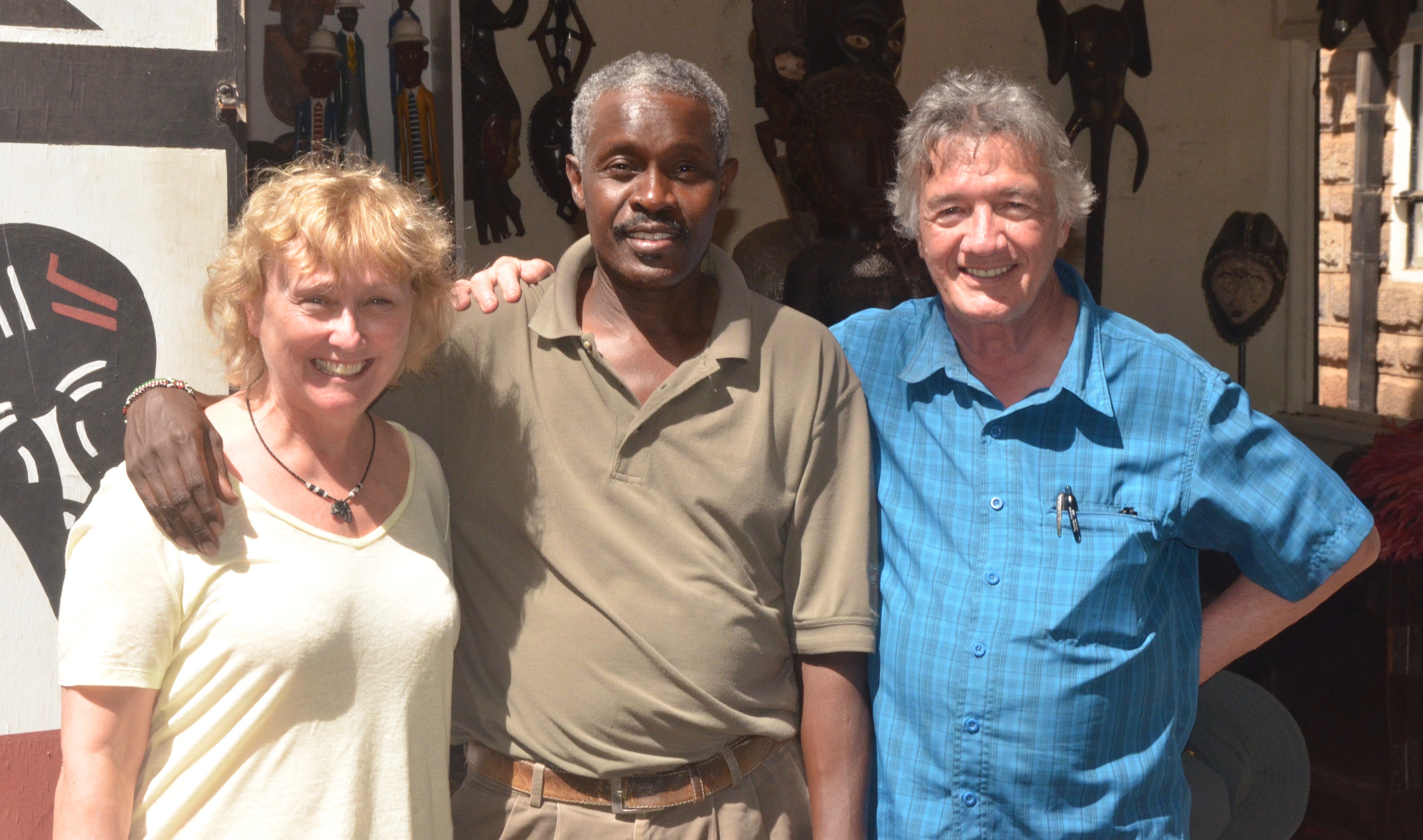
The accommodations were in Fig Tree Camp right on the banks of the Talek River. We had three game rides, a balloon ride and a visit to a Masai village. It was three days in paradise and literally a once in a lifetime experience – won’t you join us and I’ll describe how you too can enjoy the Masai Mara.
What is the Masai Mara
The Masai Mara (or Maasai Mara as it sometimes is written) is basically the northern extension of the world famous Serengeti which lies primarily in Tanzania. The word Serengeti is Masai for ‘endless plains’ and that is exactly what it is, the true African savannah that hosts the world’s largest remaining herds of wildlife. When people think of going on safari they usually have a picture in their mind’s eye of something resembling this vast expanse dotted with acacia trees. The Masai Mara portion of the Serengeti is transected by the Mara and Talek Rivers which are important obstacles points on the annual wildebeest/zebra migration that takes places annually. It is on the Mara River that the most tumultuous and dangerous crossings take place. The one that most people are familiar with through videos like the one below.
We did not plan our trip to coincide with the migrations for a couple of reasons – the prices are much higher then and so are the tourist numbers. I’m one of those travellers who shy away from peak seasons and I’m not quite sure I’d want to watch young wildebeests being swept away by the current and drowned or taken by massive Nile crocodiles. Seeing a couple of hundred wildebeests in one spot rather than thousands is satisfying enough. As it turns out we saw just about every creature you would want to see ‘on safari’ and without the crowds. Sure, there were other people on game drives, but not so many that it detracted from the experience of seeing animals truly in the wild. The fact is that the wildebeests and zebras, along with gazelles are pretty well permanently on the move in the Serengeti, largely dependent on the rains, which can be unpredictable. You could find yourself booking an expensive ‘migration’ package and find the animals have not yet arrived or have already passed through.
Fig Tree Camp
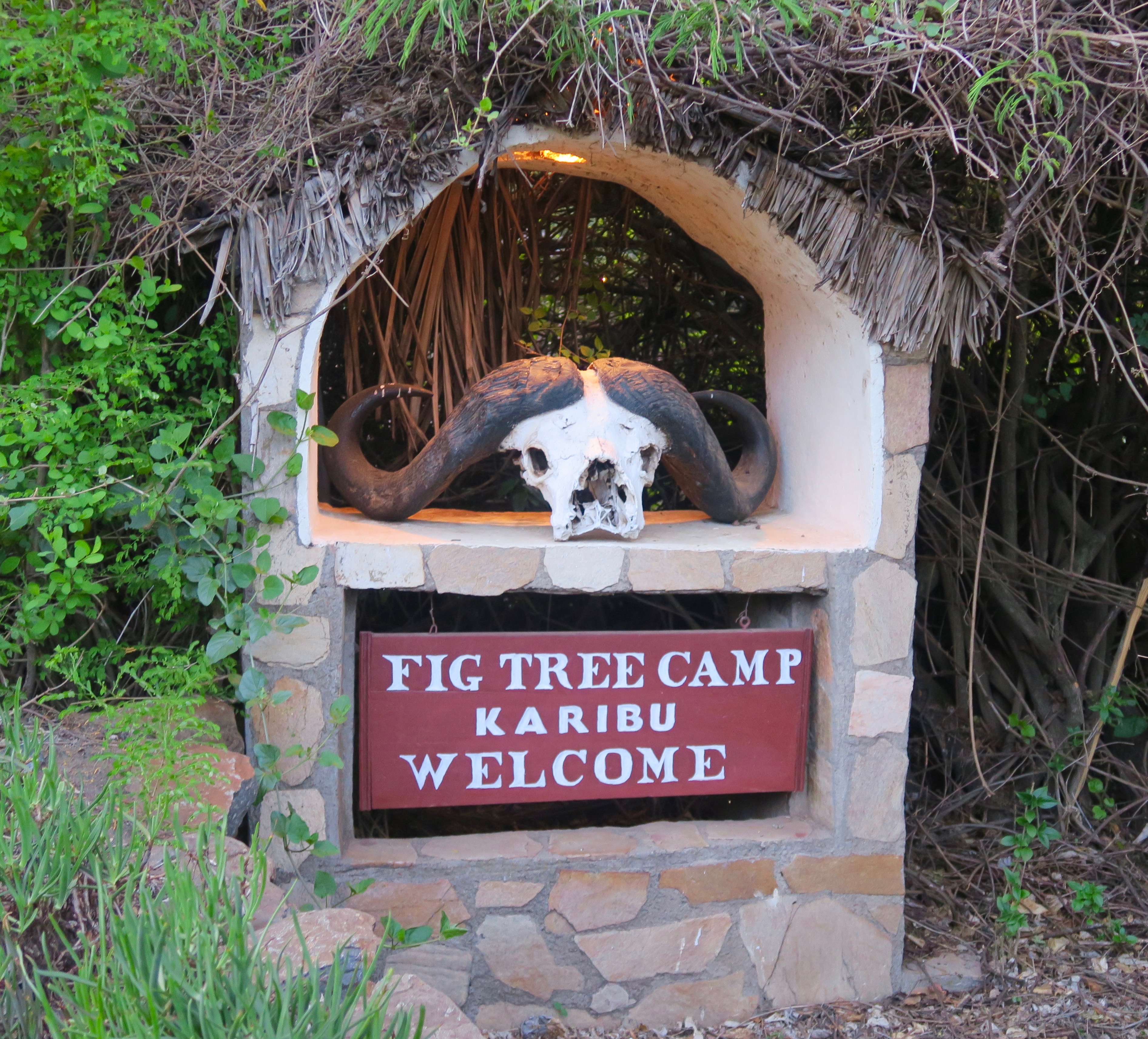
In a couple of previous posts I’ve written that we really did not know what to expect in the way of accommodations on this Kenyan trip. However, by the time we arrived at Fig Tree Camp I knew from our experiences at Sweetwaters in Ol Pejeta and Sarova Lion Hill Lodge in Lake Nakuru, that Adventures Abroad would have a top flight choice in Masai Mara, and they did.
Fig Tree Camp is operated by Mada Hotels, which specializes in game camps in Kenya, Tanzania and Uganda. It sits on a bend in the Talek River with the vehicles parked on one side and the camp itself on the other side of a pedestrian bridge.
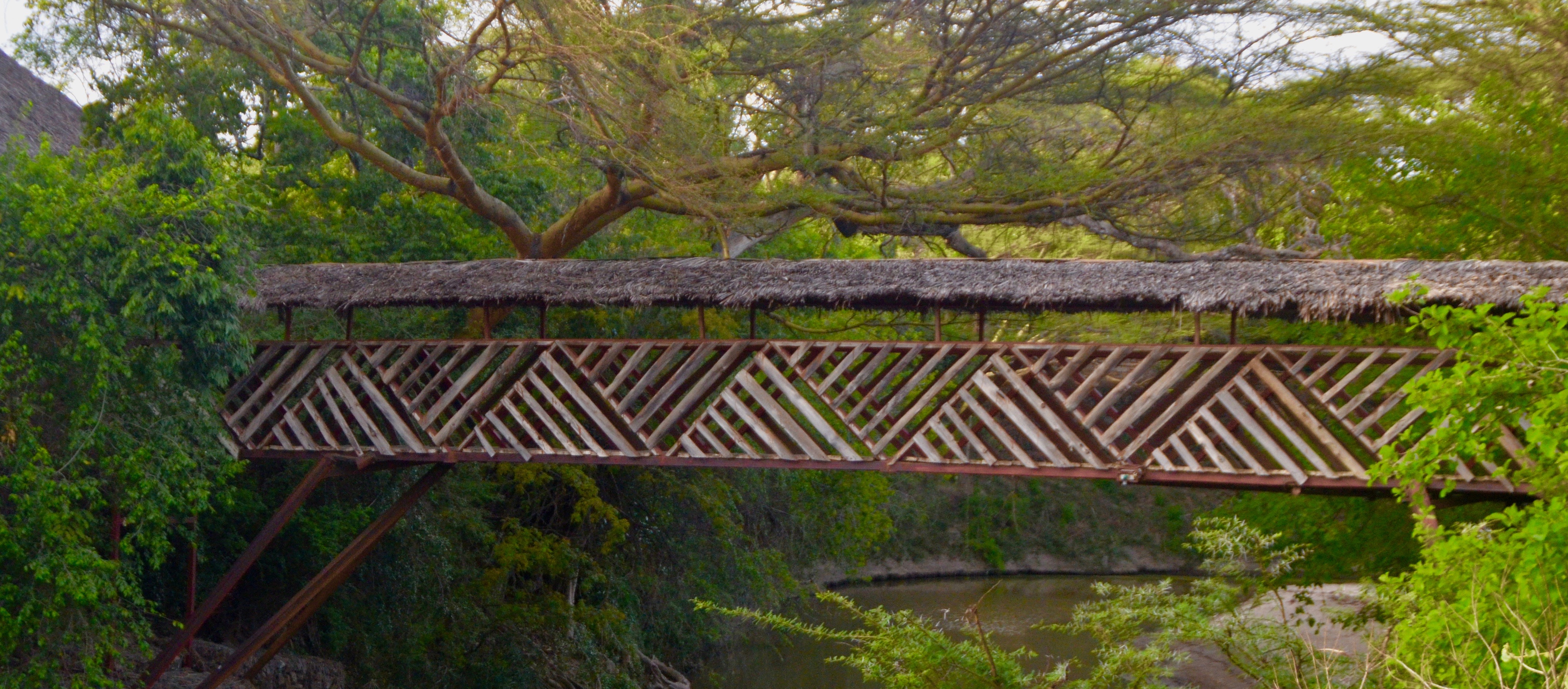
We were here in the dry season so that was not a lot of water below.
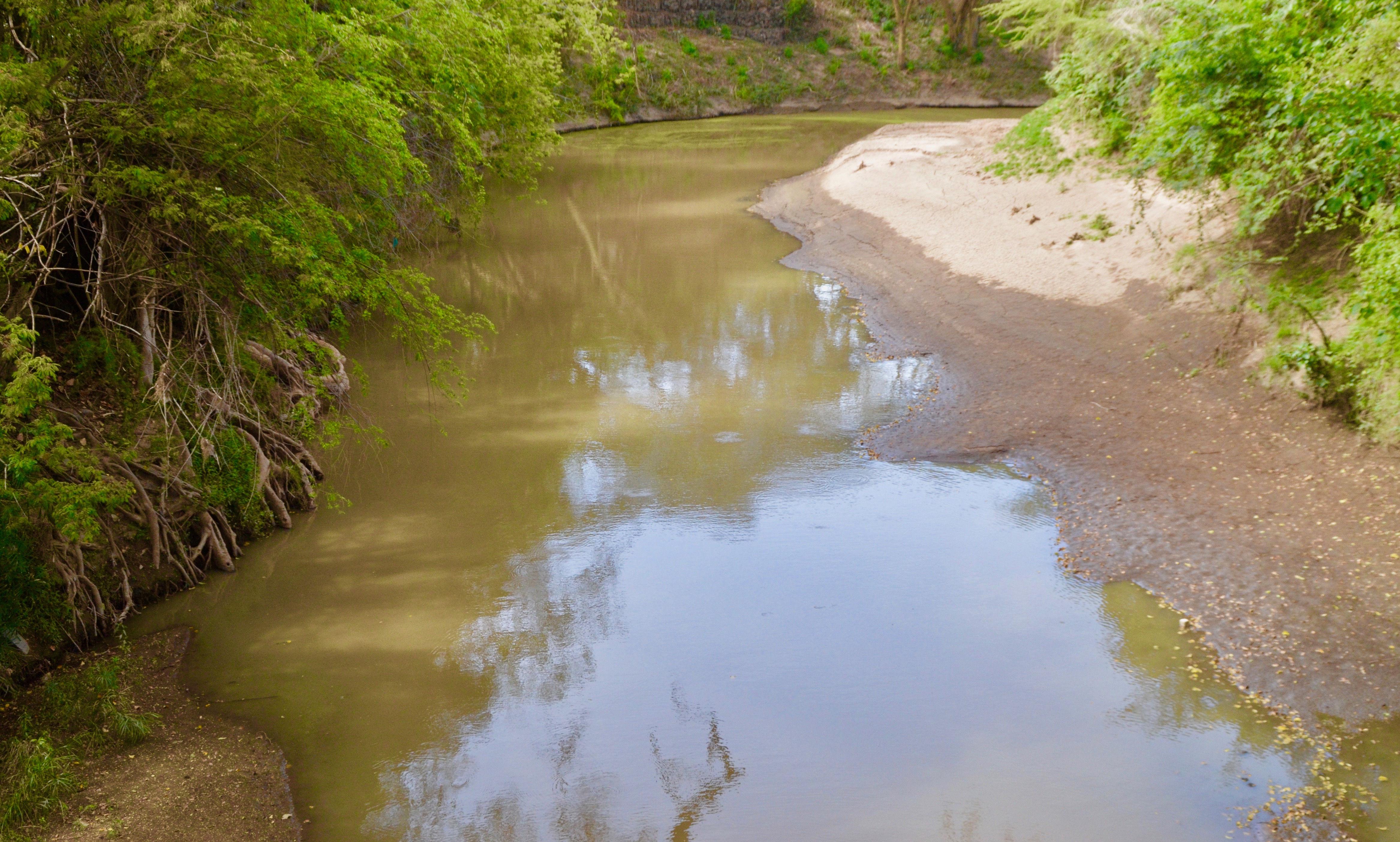
However, there was enough to keep this guy happy.
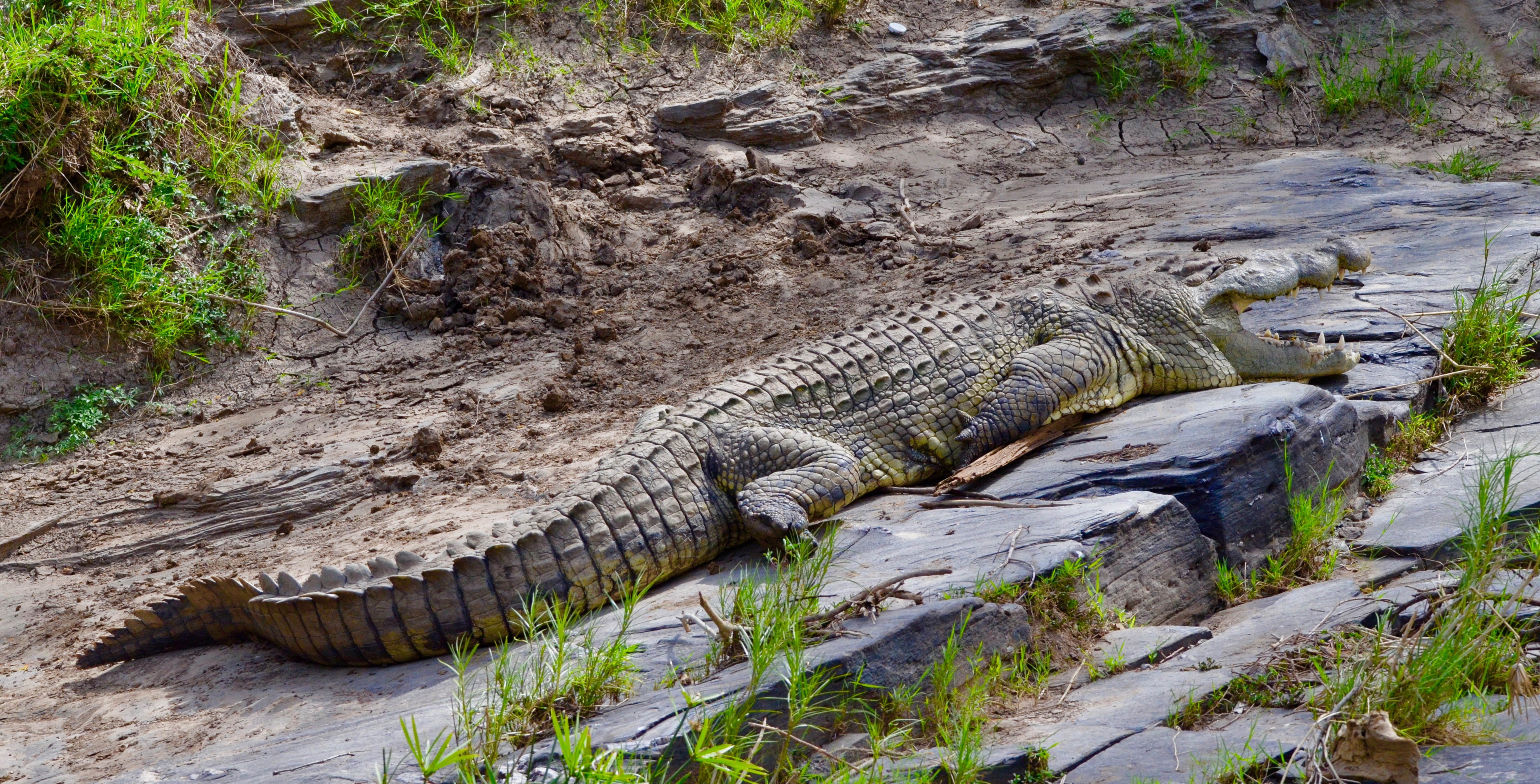
This is by far the largest crocodilian I have ever seen, dwarfing even the largest American alligators. He was there faithfully each day sunning himself on the shoreline, perhaps dreaming of the return of the wildebeests. Look at that smile.
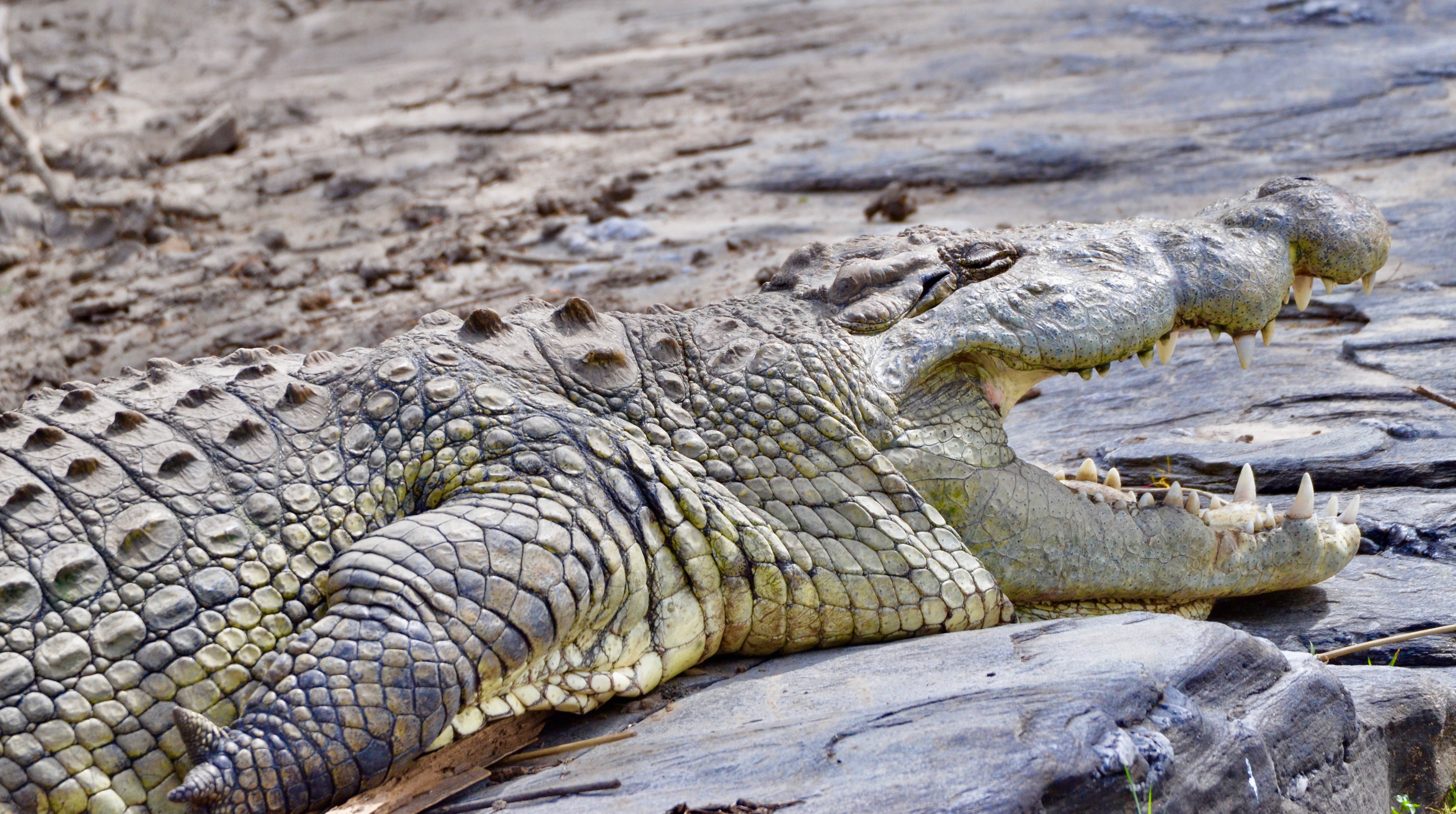
He was famous too. When we returned to the Serena Hotel in Nairobi and the desk clerk asked where we’d journeyed from and we told him, he immediately asked if we’d seen the camp’s famous crocodile.
The chalets and tents are, thankfully, high up on the banks of the river, well away from smiley. We had tent #2 which was spacious, had a fridge and nice bathroom. The best thing about it was the outdoor patio where we could sit and enjoy a glass of wine.
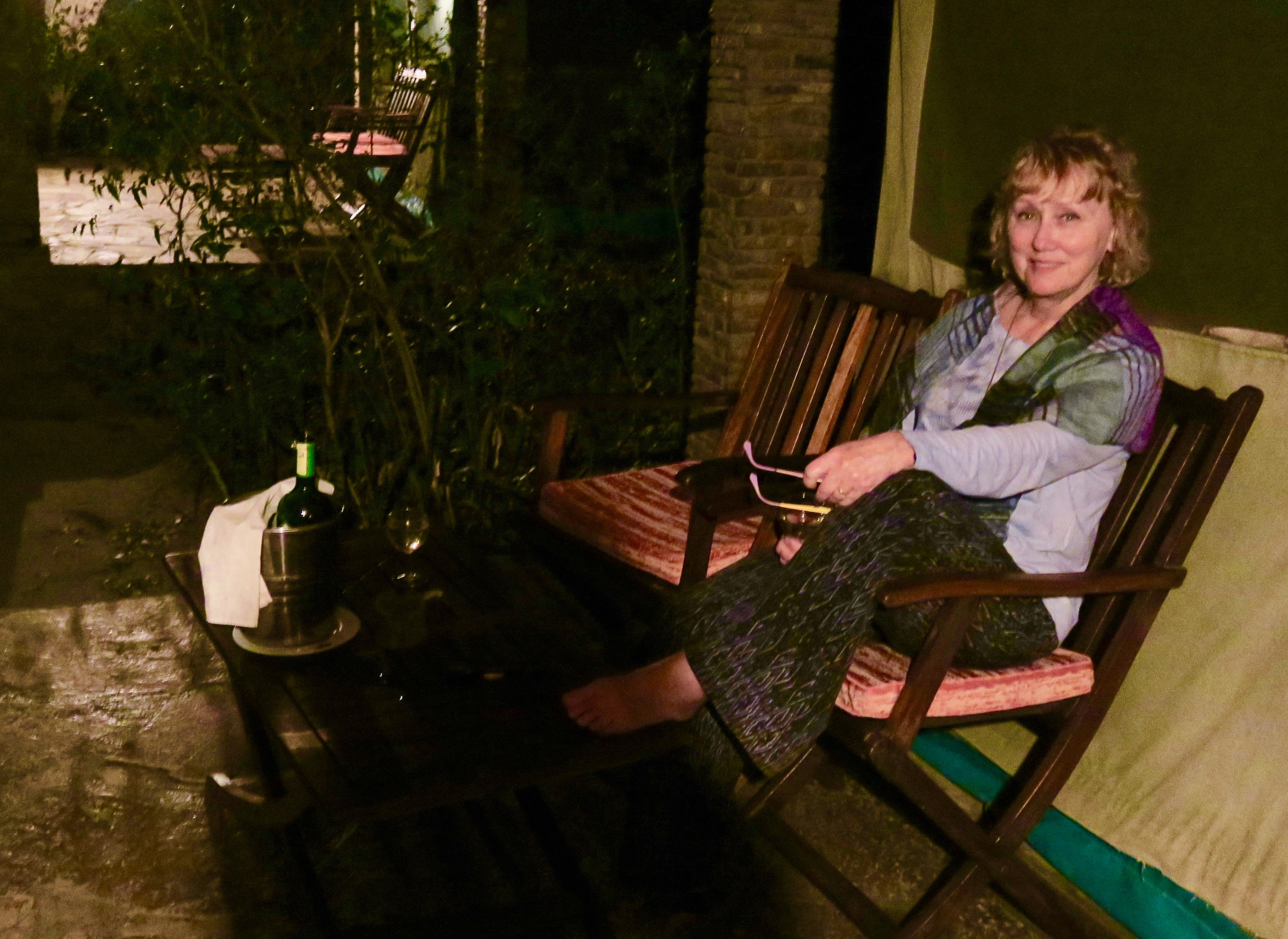
Across the river was a tree that had a colony of weaver birds. The males of the species put on an endlessly entertaining display as they cling upside down to the nests they have created and flutter their wings, hoping to attract one of the drab females to move in. The females are very fussy and while they do inspect the nests as the male waits outside in trepidation they almost invariably declare them unsuitable and fly off. I know it’s personification, but you can actually see the look of dejection that comes over the males when this happens.
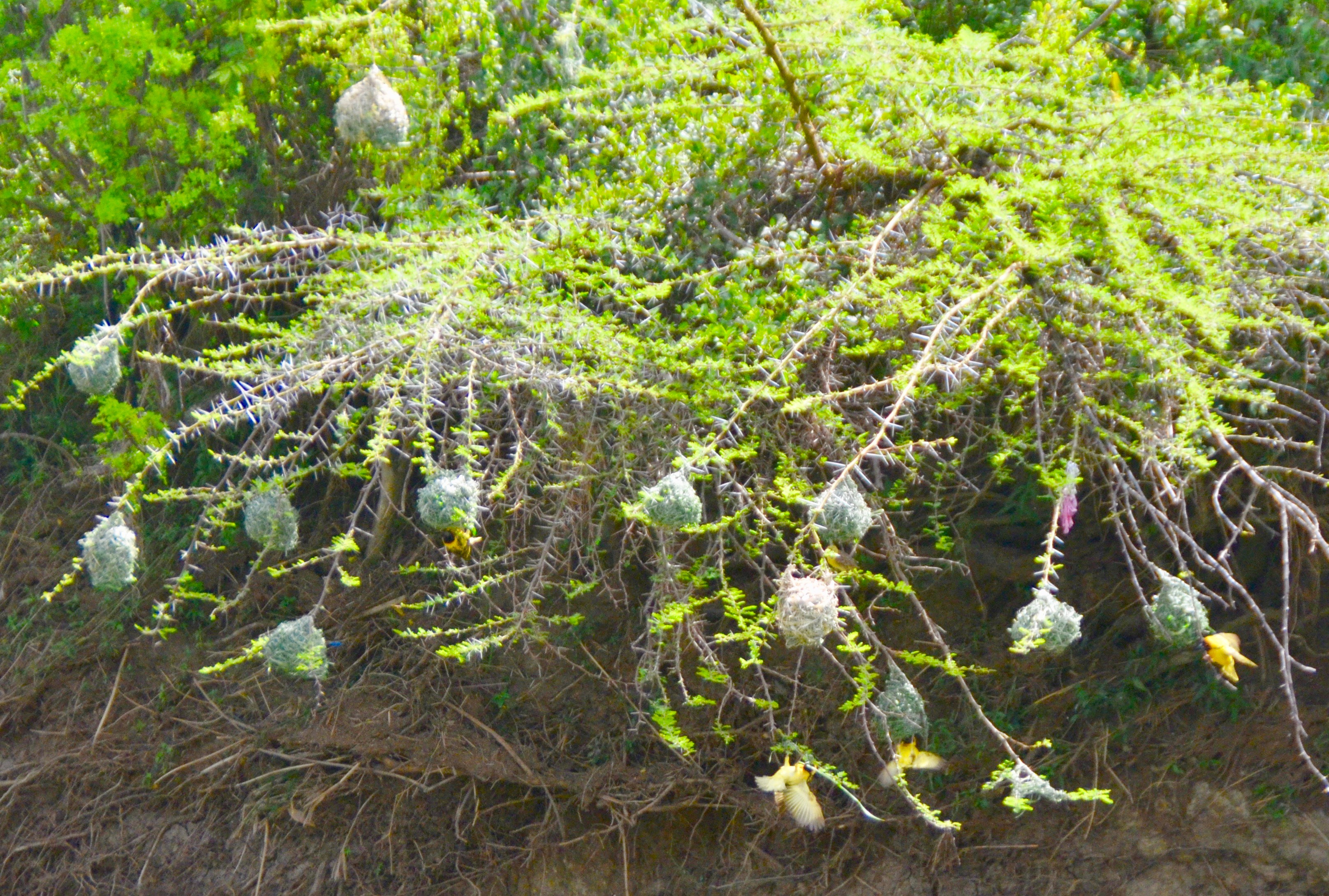
For wifi you needed to go to the bar, but hey that’s not the end of the world, having a cool Tusker or White Top while checking emails.
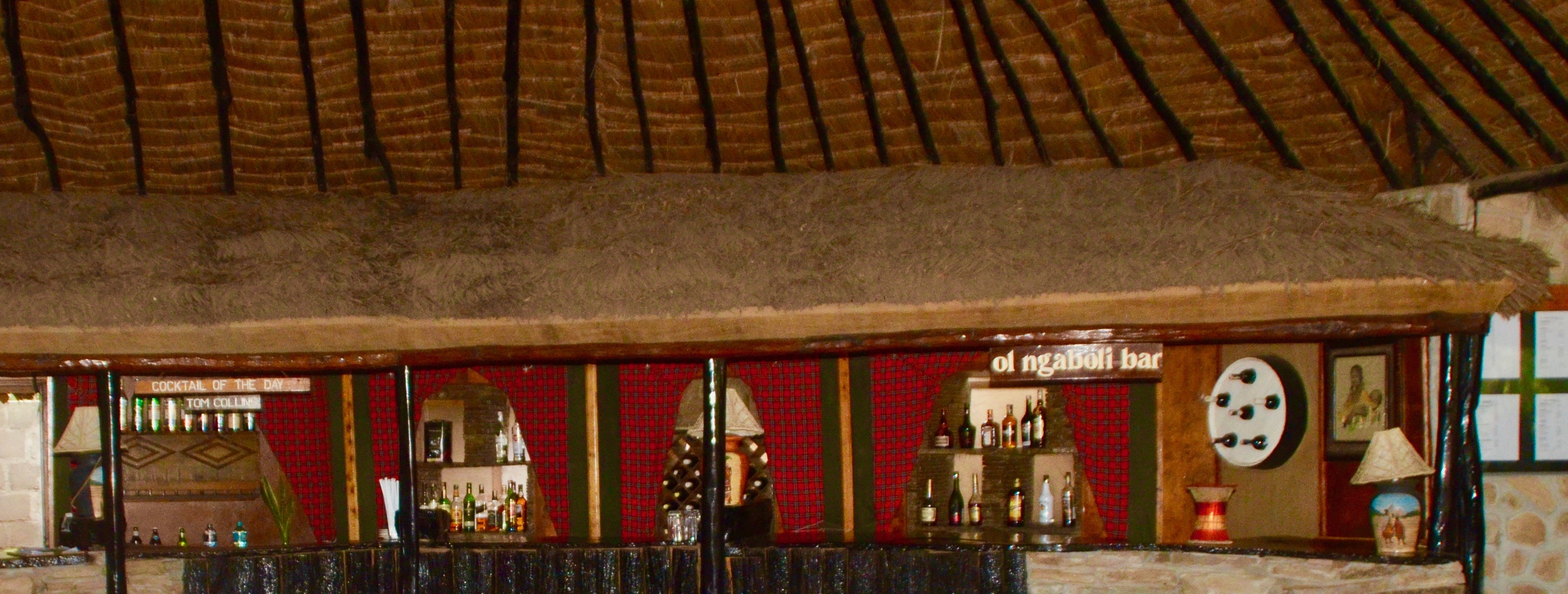
Or you could do it by the pool – a lot safer than a dip in the river.
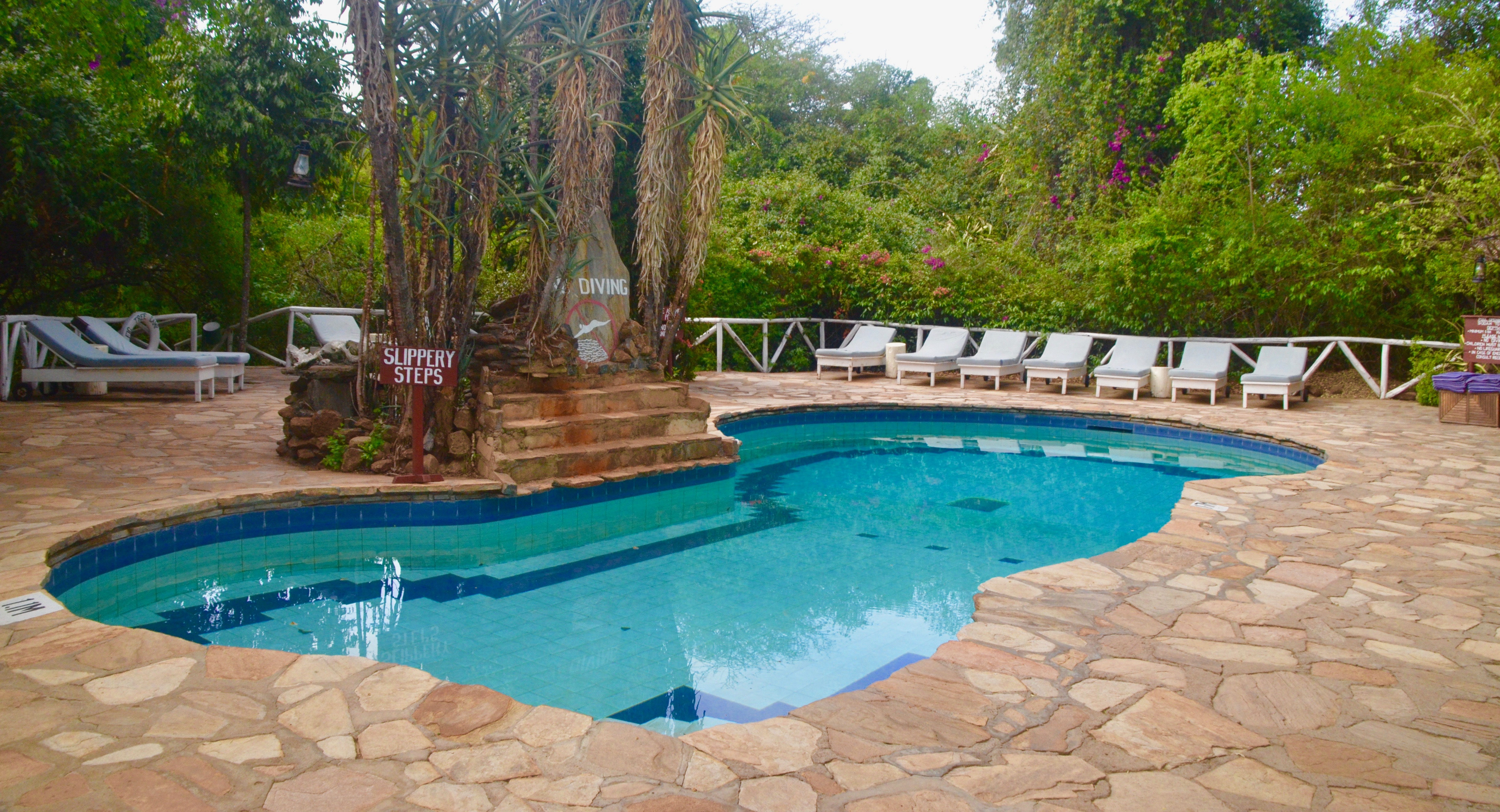
The meals at Fig Tree Camp are buffet style, like all the places we stayed in Kenya, and by buffet standards, very good with a wide selection of dishes to cater to the many different nationalities that visit these game camps. I probably ate more Indian dishes while in Kenya than other other type cuisine. Unlike Egypt, nobody in our group had any stomach or intestinal problems from the food, although we did drink only bottled water.
The Masai people are, of course, native to the Masai Mara area and some them wandered about the grounds of Fig Tree Camp dressed in their traditional garb. Costumes would not be the right word because this is how most of the Masai men dress every day. This is Alison and fellow Adventures Abroad traveller Erica Pascal with one of these men. They do expect to be tipped for posing, but how often do you get the opportunity to get a shot like this with the Talek River in the background?
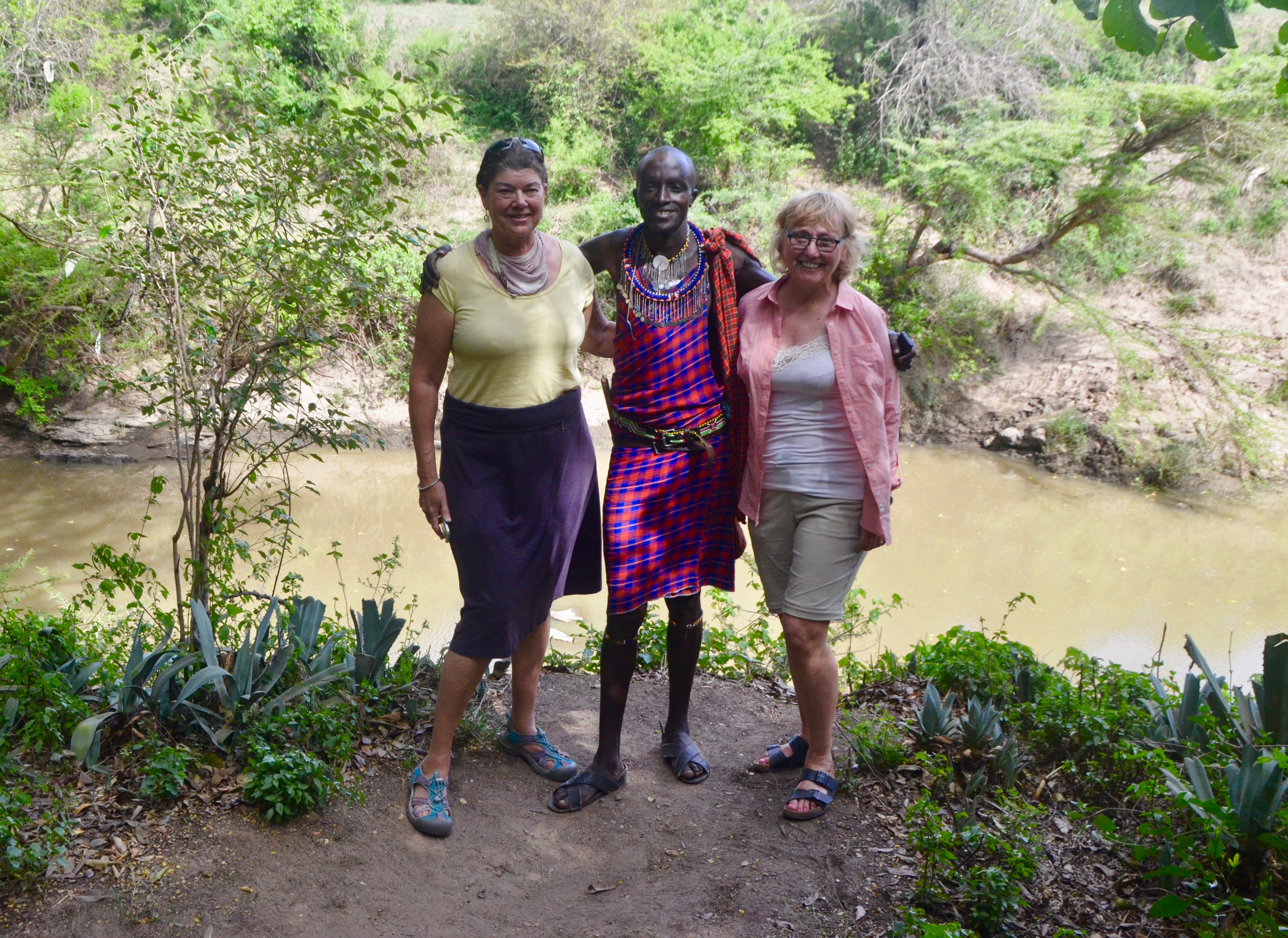
Not long after the sun goes down the camp puts out food scraps for genets that make a ritual of coming to the bridge railing for their nightly snack.
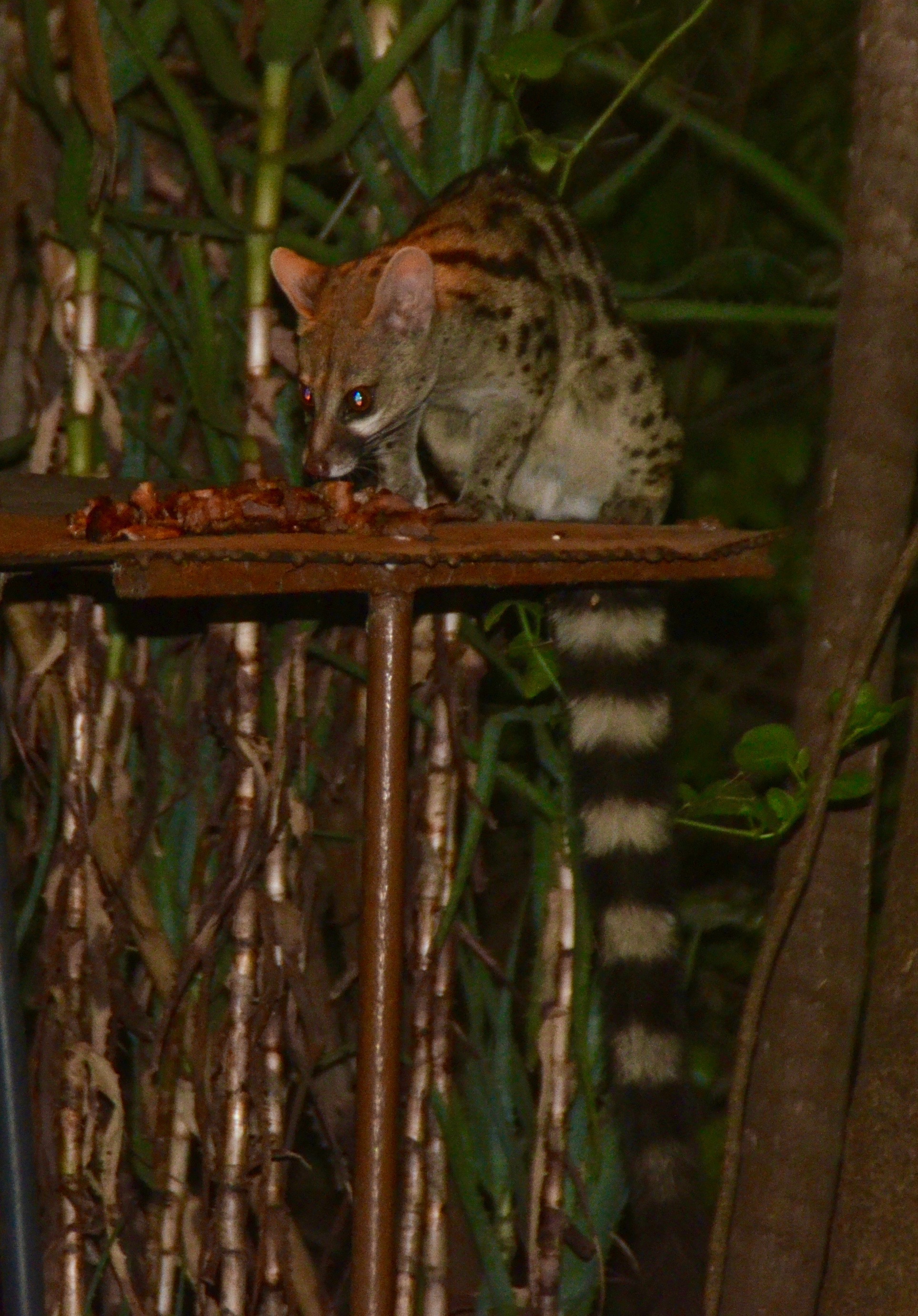
So, as you can see, Fig Tree Camp is a pretty interesting place to stay, but the adventure is just beginning.
Ballooning Over Masai Mara
Mada Hotels specializes in balloon trips over East African wildlife with operations at Masai Mara, Serengeti and Tarangire reserves. The trips are by no means cheap – $450.00 USD and are an optional add on to the regular tour price. However, Alison and I were not about to come all this way and miss out on a balloon trip over the African savannah because of few extra dollars. In retrospect, given the remoteness of the location, the number of persons required to pull off a successful balloon ride and retrieval, plus the champagne breakfast, I don’t think the price is unreasonable. Three of our group of five opted for the balloon ride.
We had to get up at 5:30 which was no problem as there was hot coffee ready – all I need to start each day. At six we were driven the surprisingly short distance to the field where the balloon was ready to be filled with hot air.
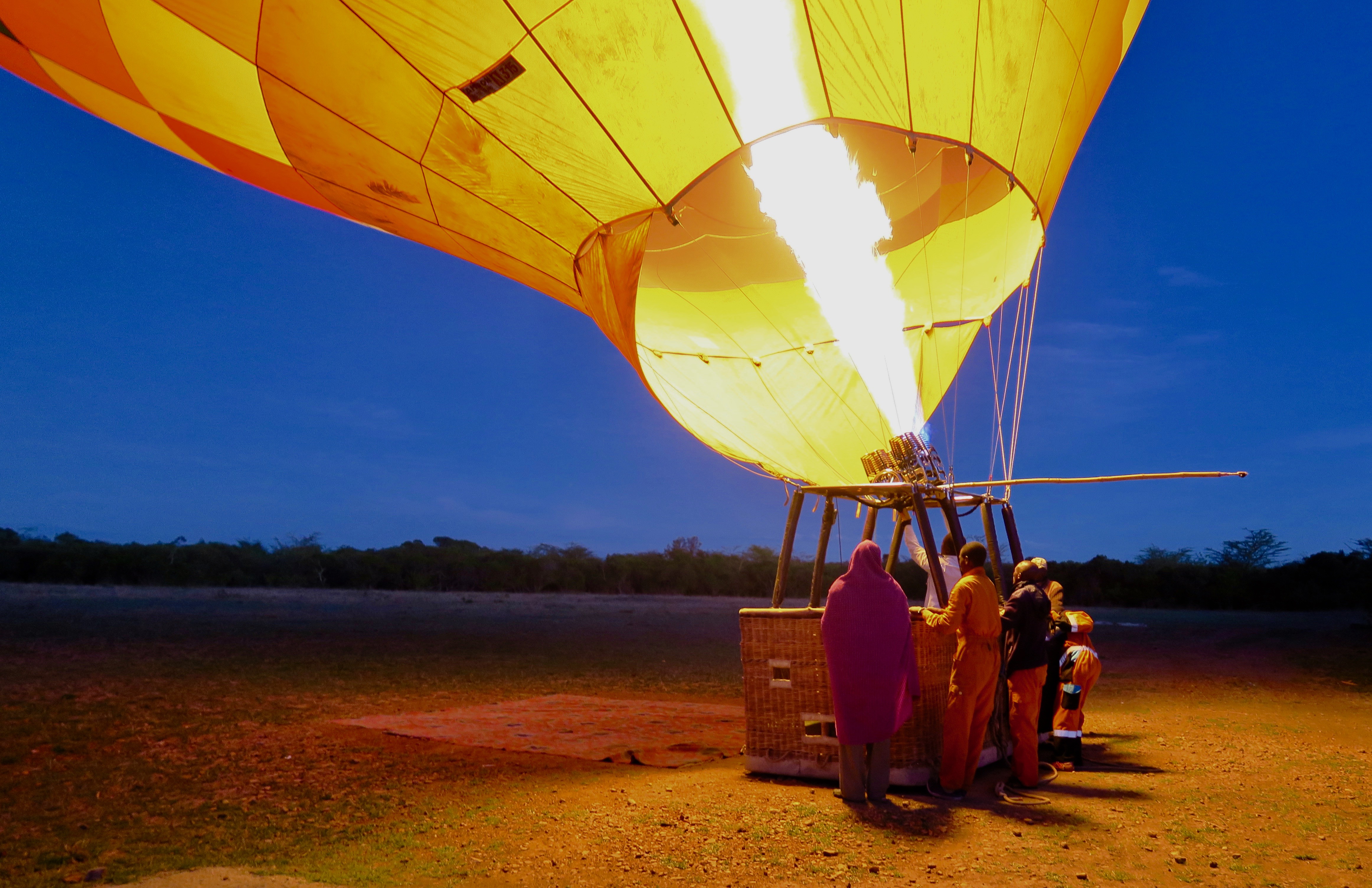
There was a full moon still up and the sight of the balloon inflating underneath it was exhilarating in the clear morning air.
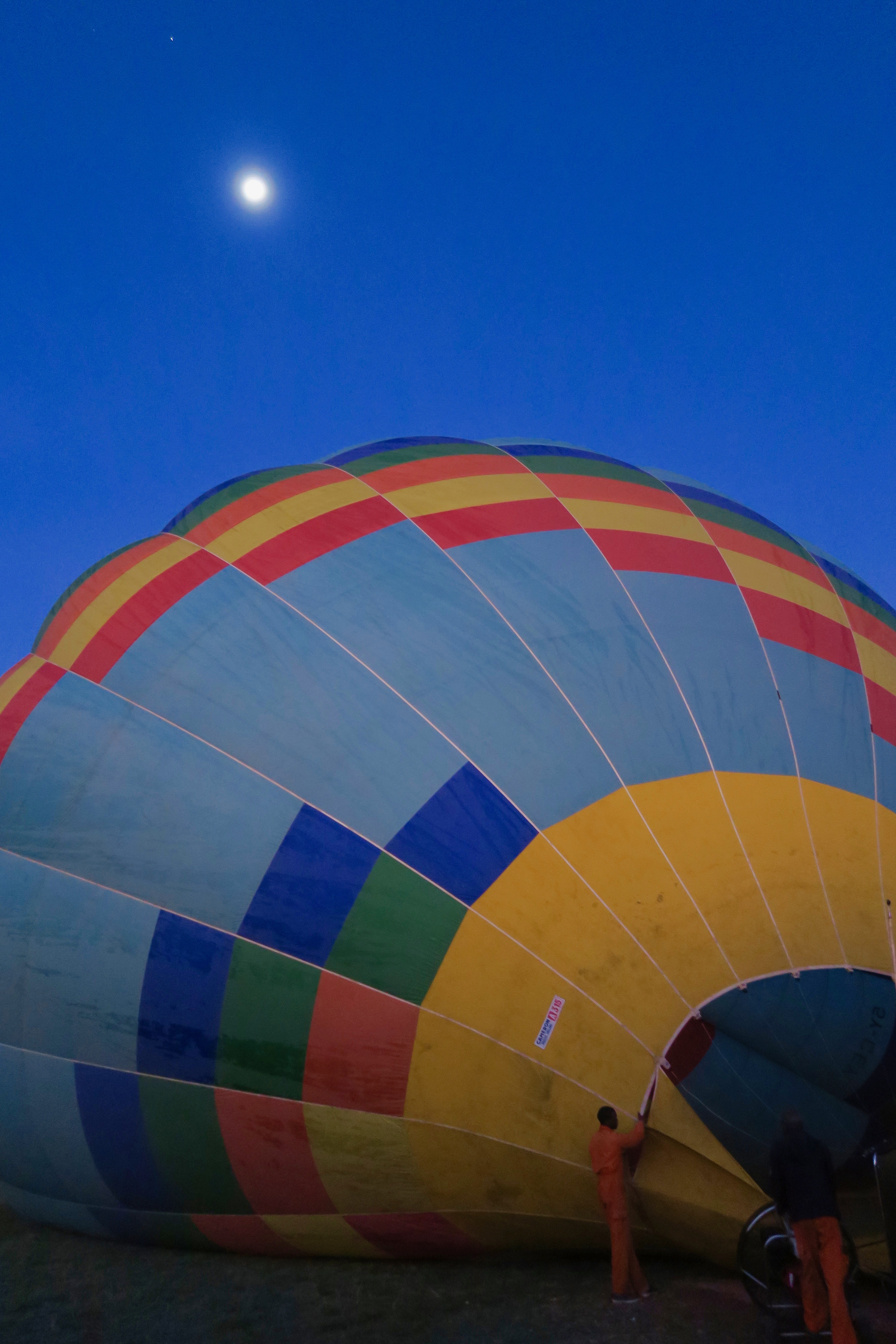
Looking up inside the balloon provided a collage of colour and heat and a sense of wonderment that nothing but hot air was going to carry the basket and passengers safely across the savannah over trees, rivers, wild herds of game and their predators. No point dwelling on that or you’d never go up in a balloon. The safety record of Adventures Aloft is perfect and there was probably more danger in the drive to get here than on the trip itself.
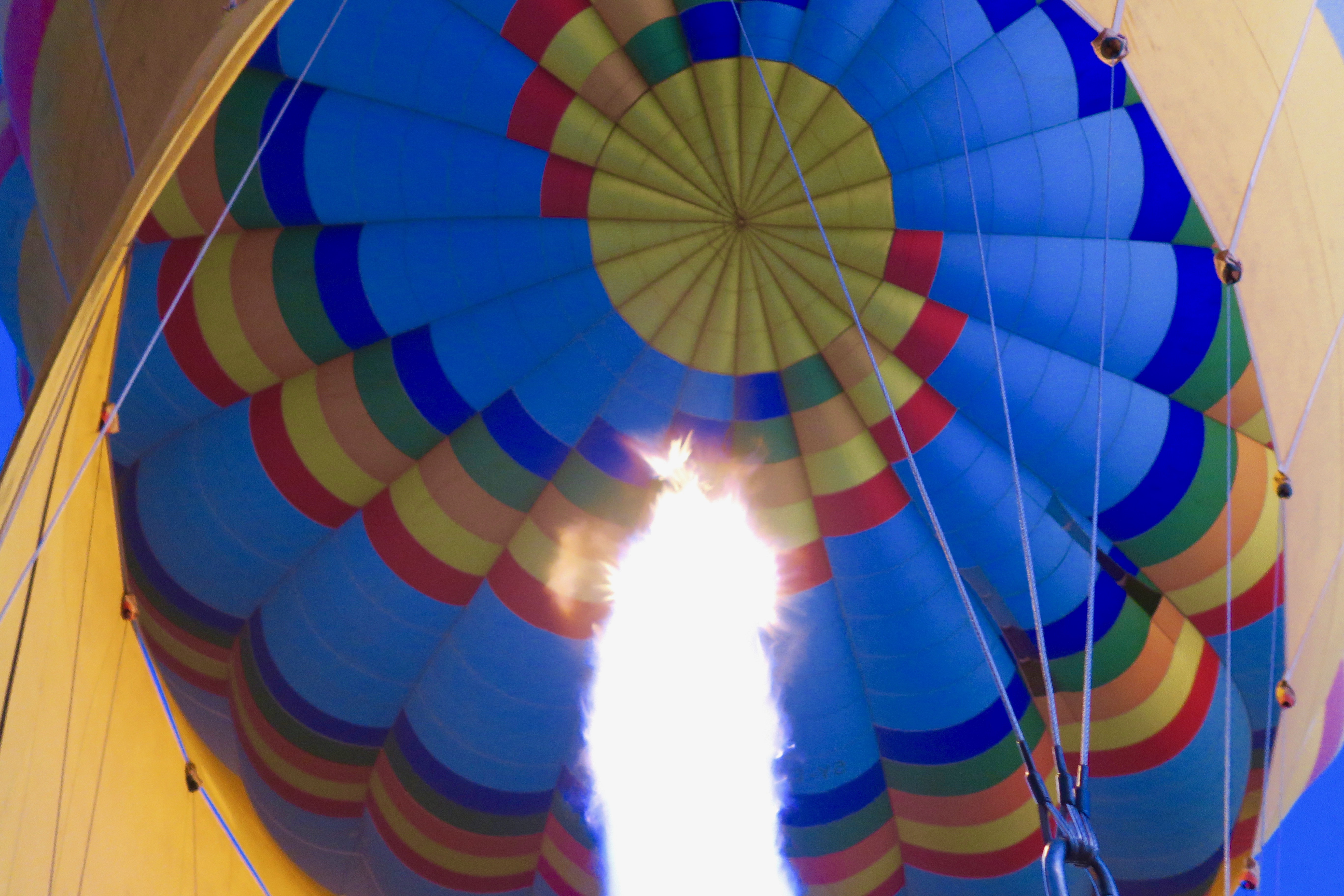
The basket could hold 16 passengers and two crew. Today we had a dozen including a very strange Asian trio. Two of them were obviously a couple, maybe newlyweds, and the other man was poorly dressed, chain smoked when not in the balloon and most mysteriously, ducked out of sight whenever a picture that might include him was being taken. I got the distinct impression that he might have been an unwanted body guard for a couple from say, North Korea. The rest of the group were Europeans other than us and Erica.
Ours was the only balloon going up from this location and when I asked about that, was told that during the migration there would be at least four.
This is our pilot, Captain Barnabas, who managed to combine quiet competence with outright joviality. This was not our first balloon ride and we had no trepidation at any time on the flight, but if we had, Captain Barnabas’ assuring manner would have resolved it. The reality is, that despite being as high as 1,000 feet, you really get no sense of height in a balloon, or at least the kind you might get standing on a high cliff or on the roof of a building.
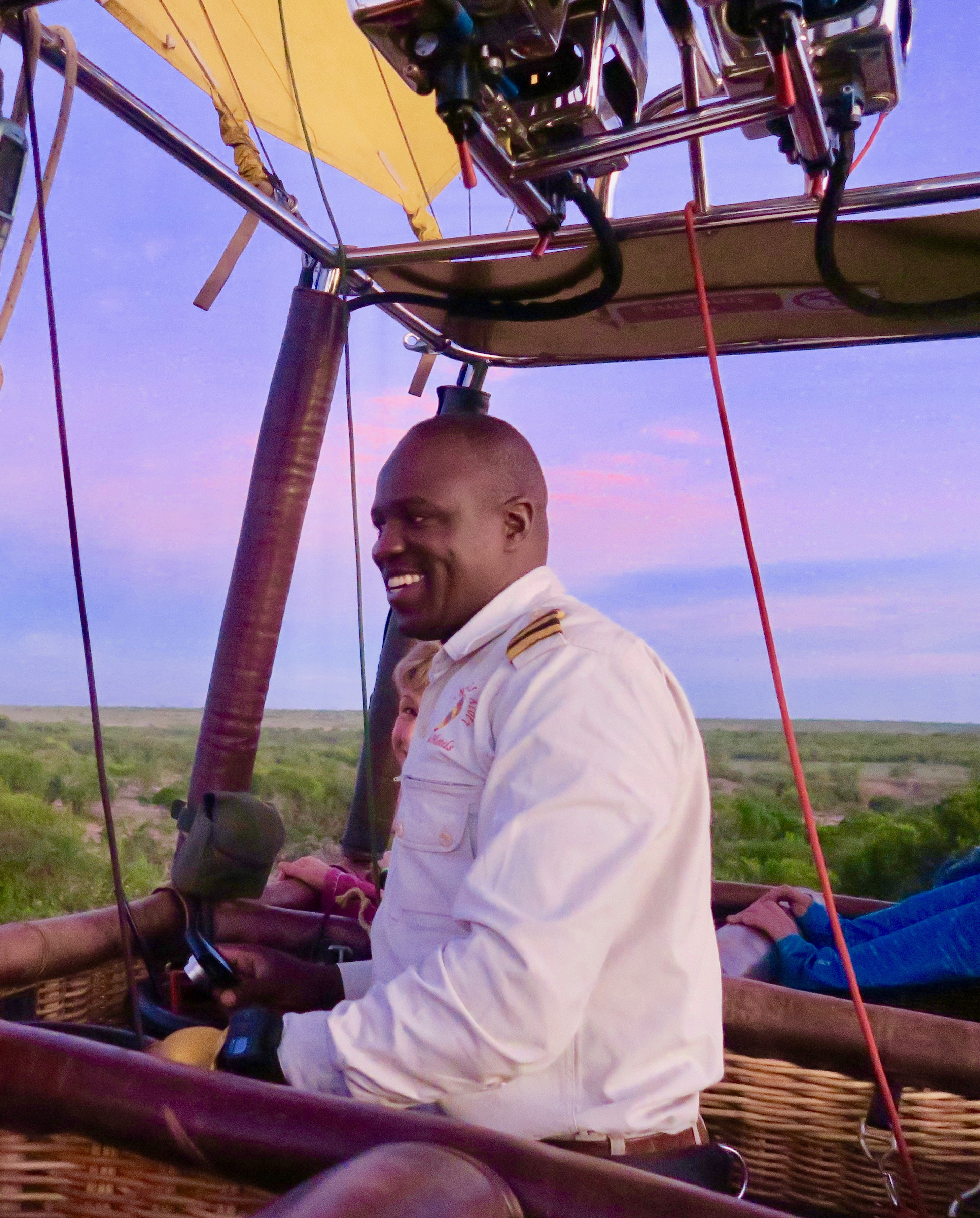
OK, let’s get going and see what we see.
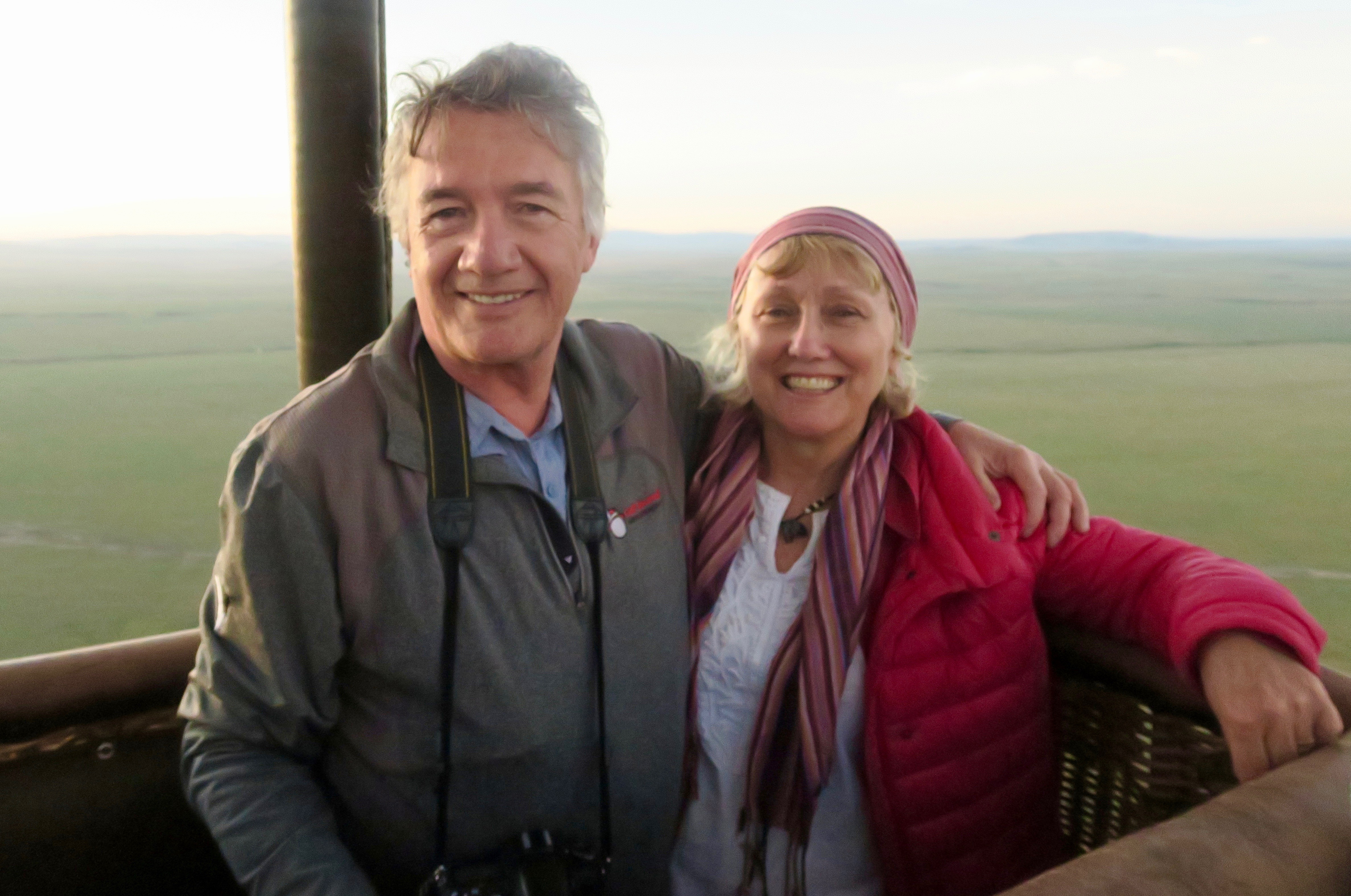
Almost immediately upon rising we move over top the trees on the banks of the Talek River and a troop of baboons below.
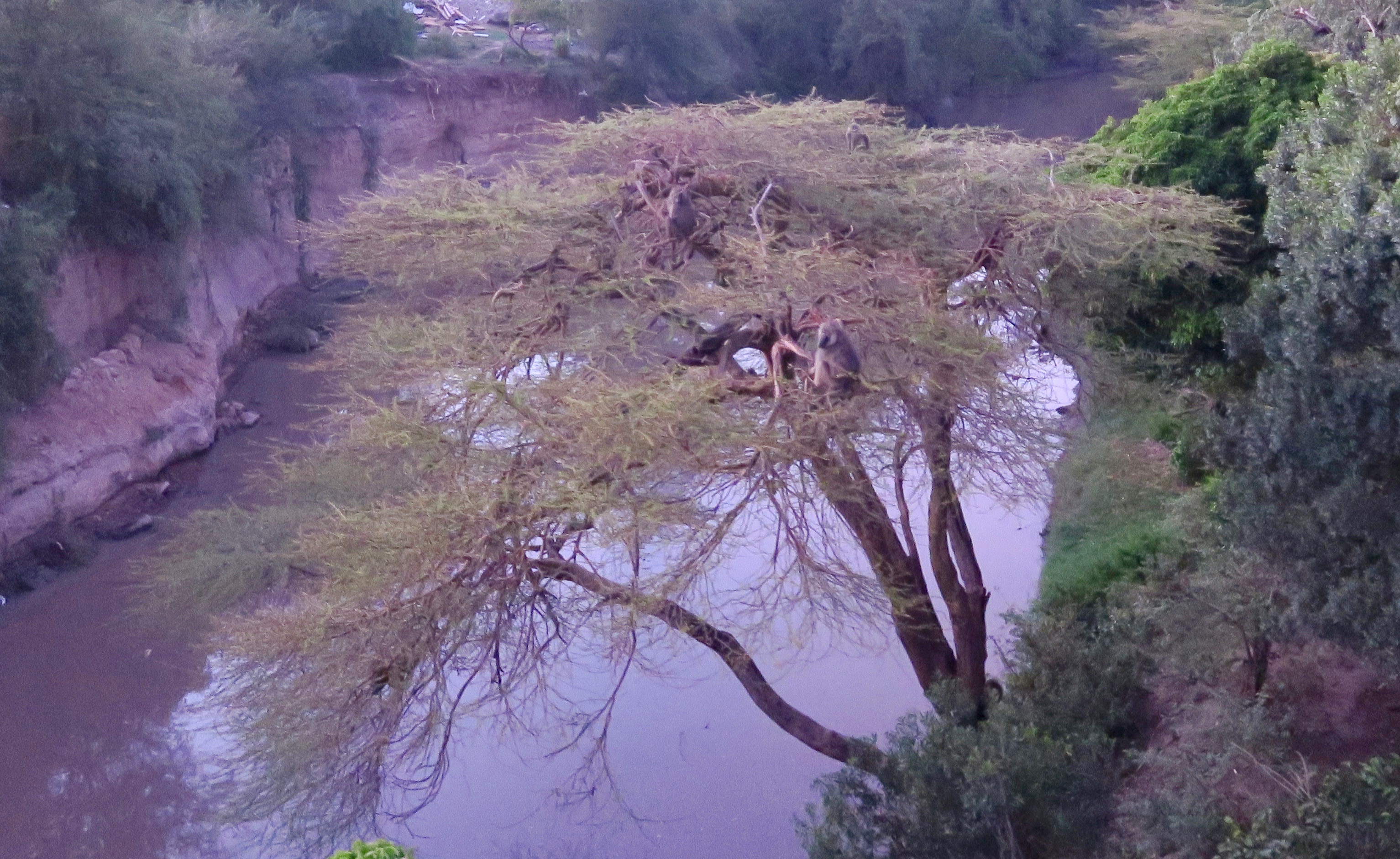
Many people think the Masai Mara is just one big savannah, but there’s actually quite a bit of forest, especially around the riverbanks. From the photo it looks from the balloon’s shadow that it’s only half there.
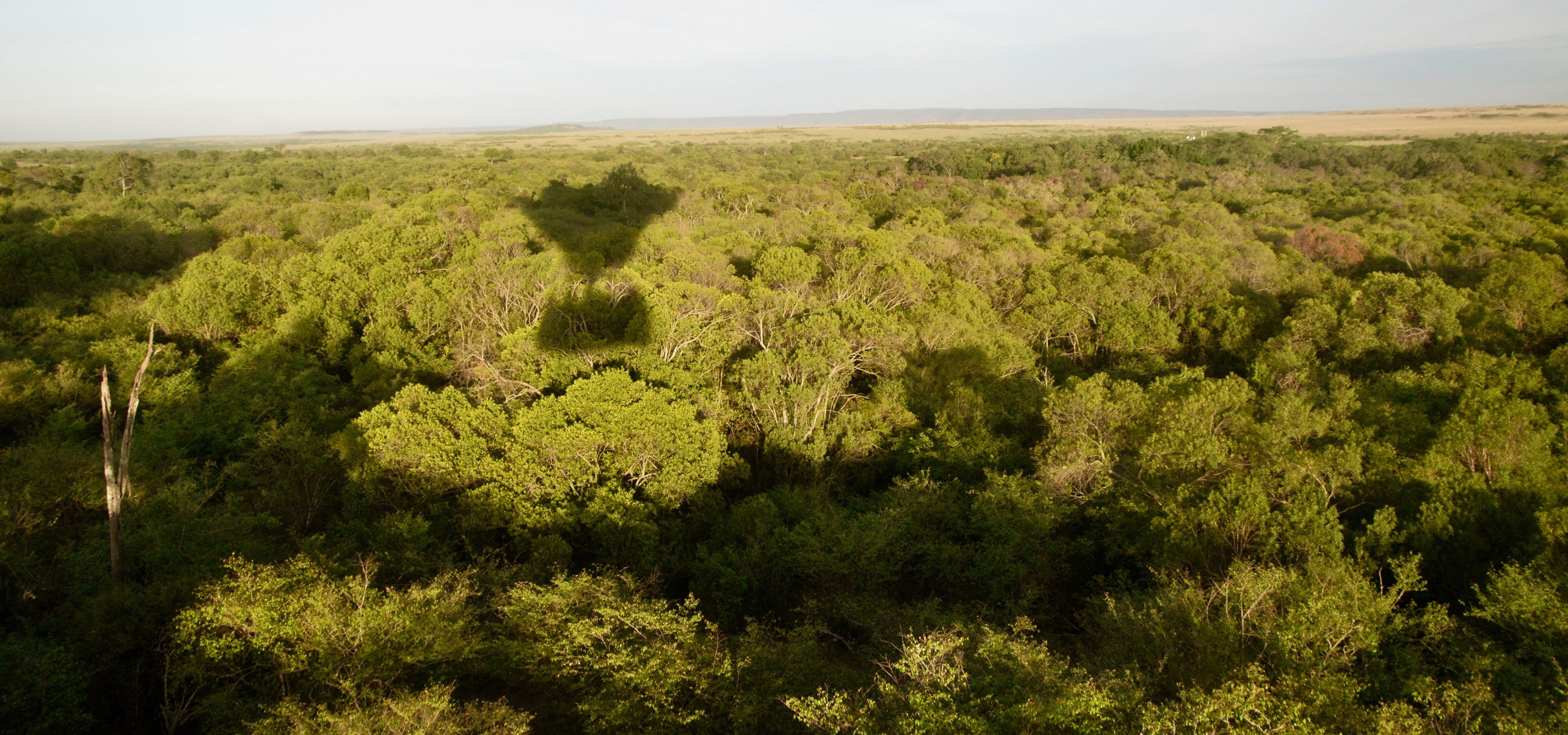
Moving up higher, we come across this stately procession of Masai giraffes. These are views you are only going to get from a balloon. In between the loud bursts of flame that keep the balloon elevated, it is incredibly quiet up here and it’s almost as if you are viewing nature with the sound muted.

We spot a group of elephants and Captain Barnabas lets the balloon descend for a closer look.
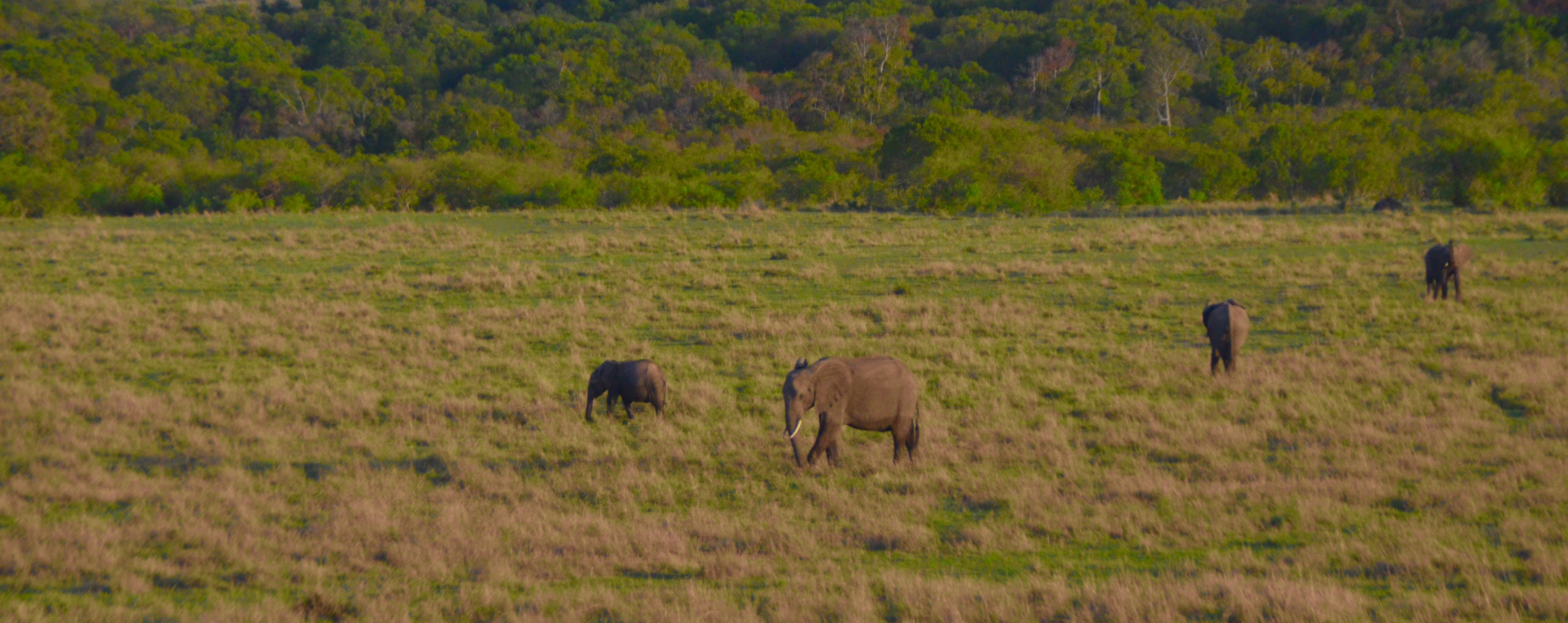
At one point it seemed a little too close, as this bull looked like he was thinking of charging, but Captain Barnabas whisked us higher before the tusker could make up his mind. Nice little adrenalin shot early in the day.
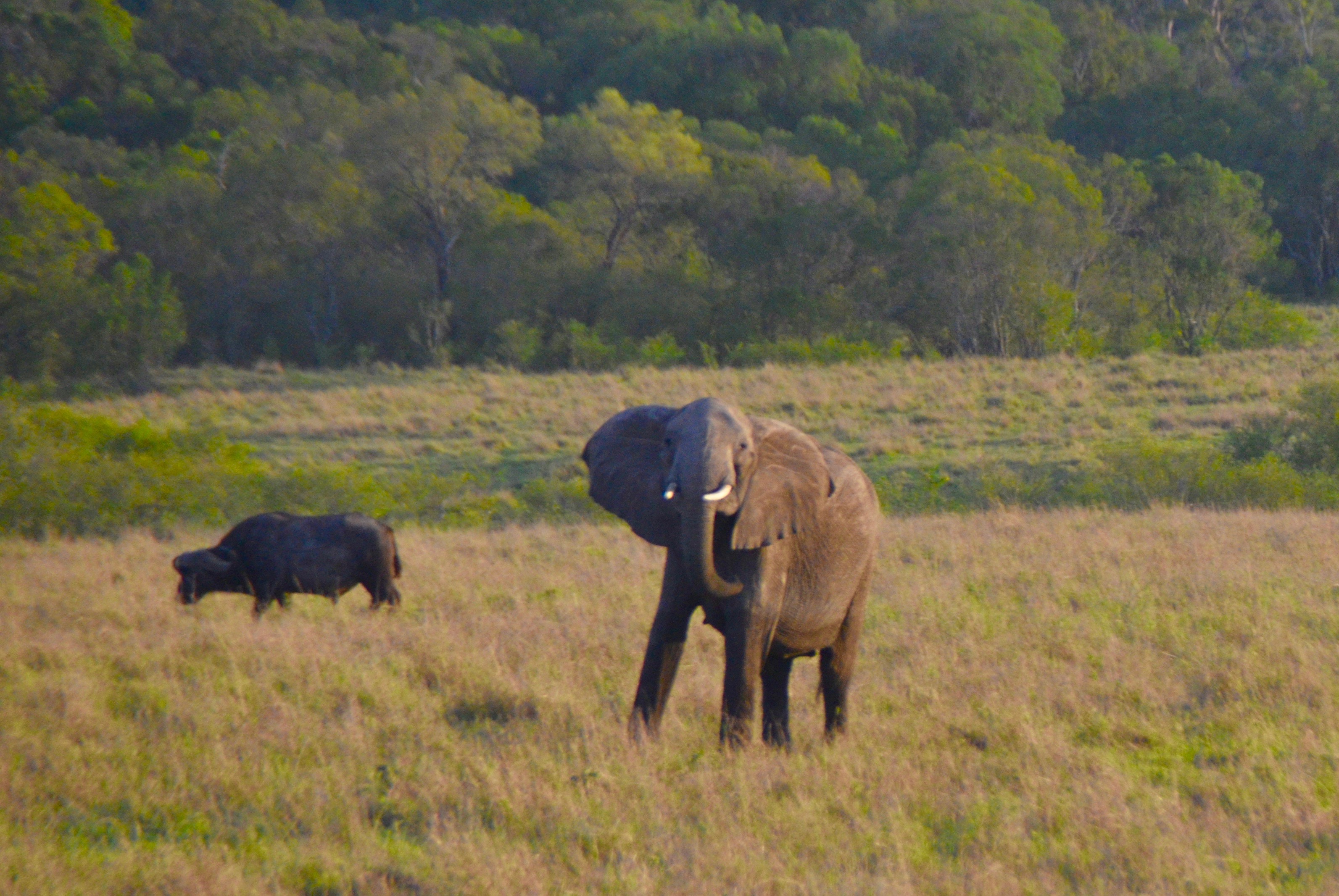
Even without the wildlife, it’s beautiful above the Masai Mara in the early morning light.
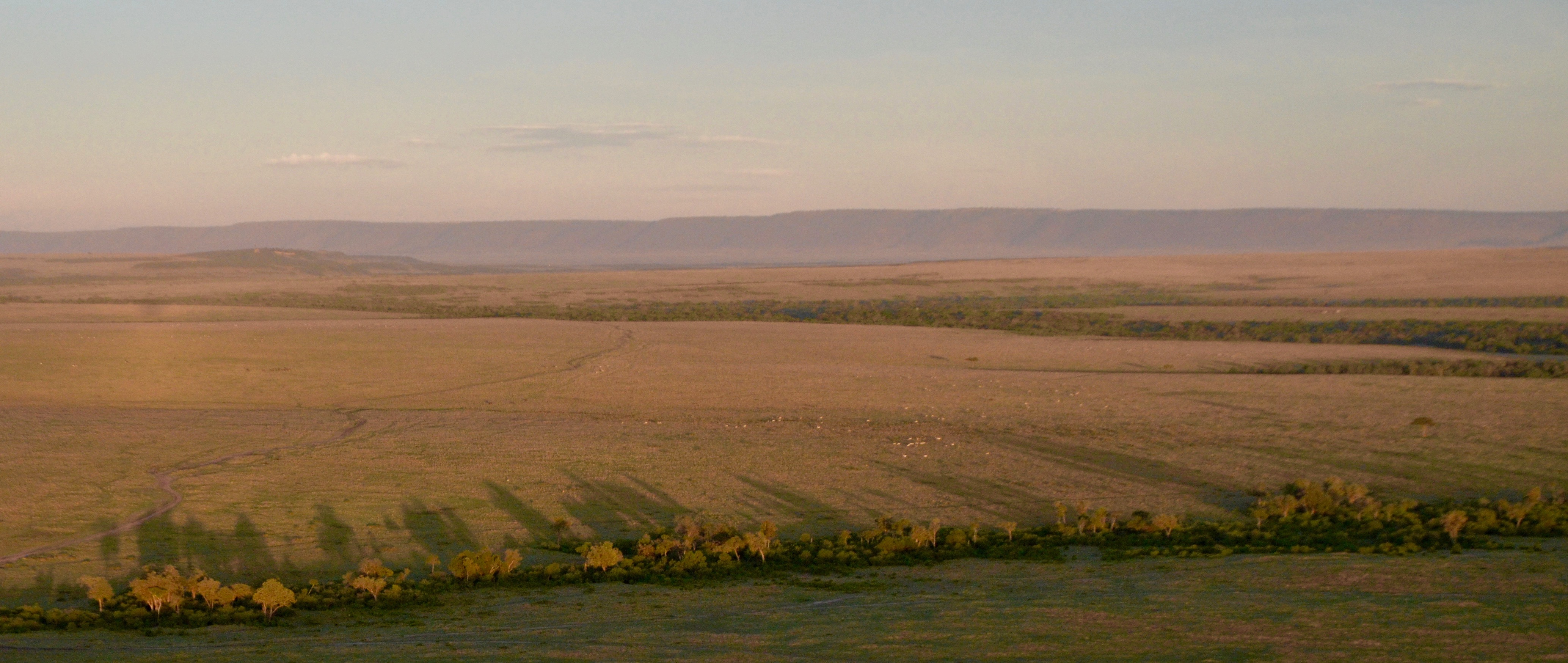
With the shadows in front of us we have been travelling west. Turning around we see a wonderful sunrise and three other balloons launched from another camp.
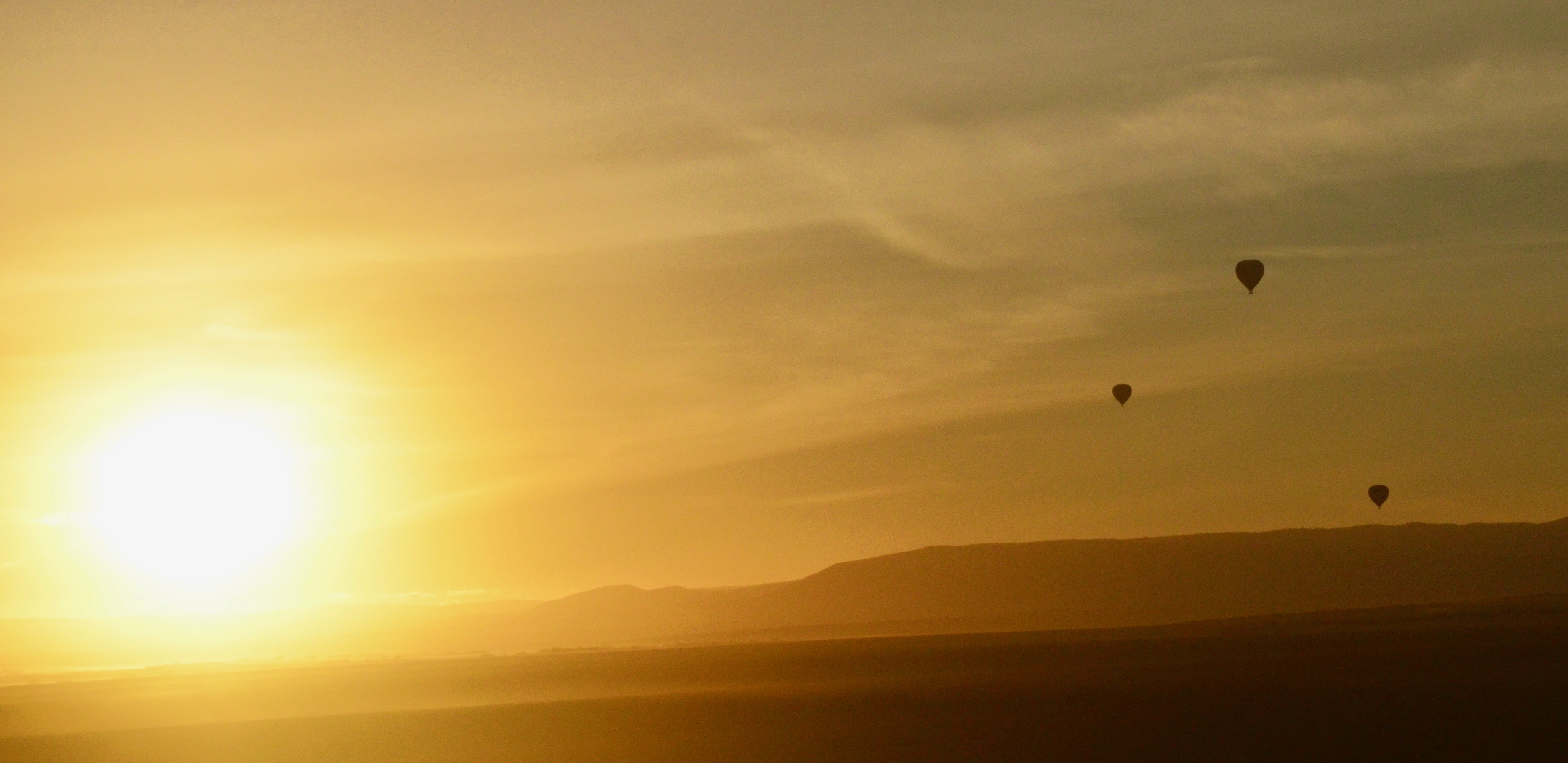
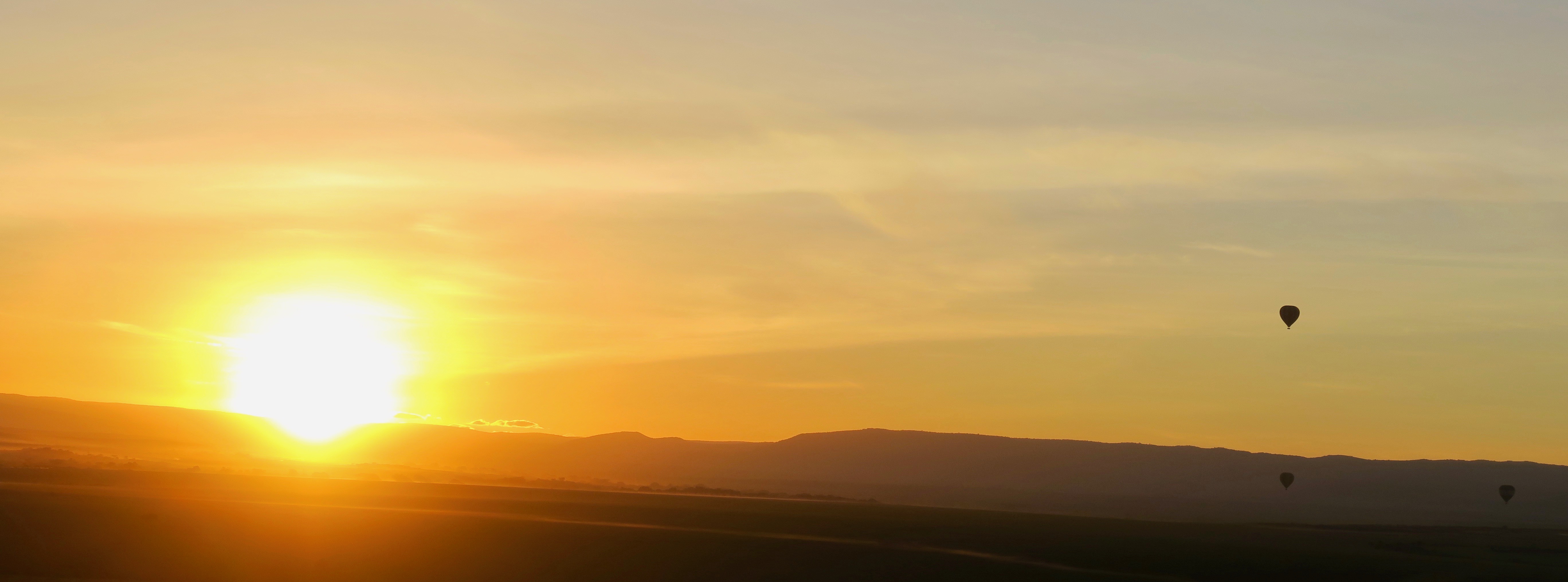
Facing west again, the balloon glides just over the top of this herd of waterbucks. It doesn’t seem to spook them.
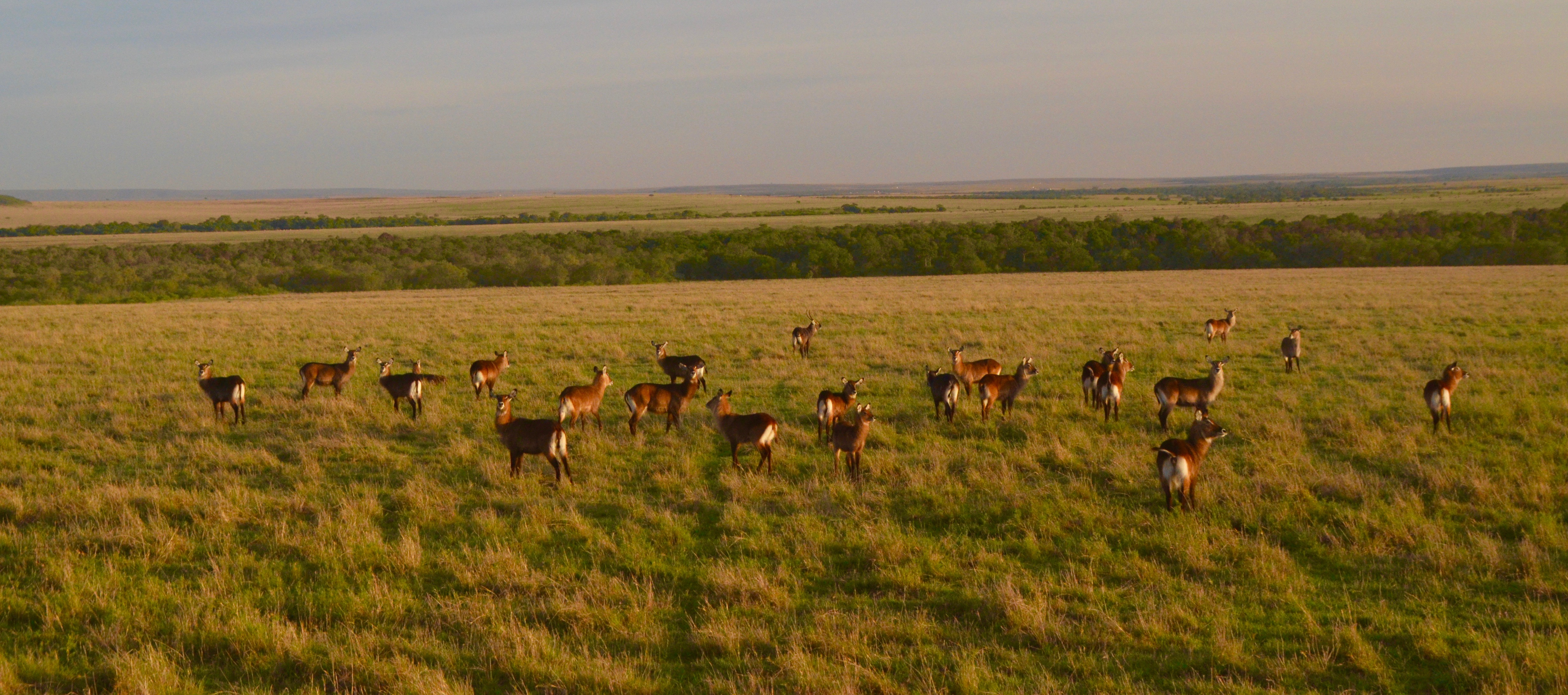
Wildebeests are a different story. They do flee as the balloon approaches.
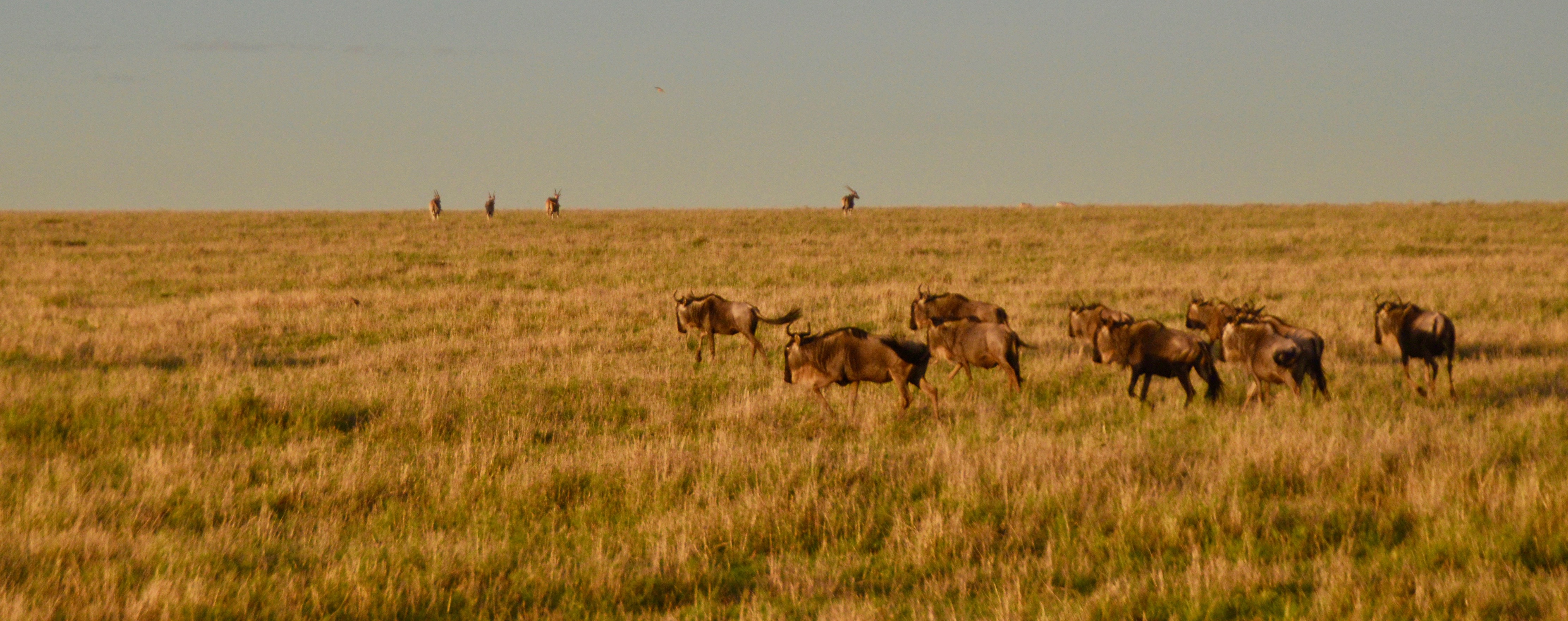
One other thing you can really only appreciate from the air is just how many bones and skulls litter the plains of Masai Mara. I could have done an entire photo gallery of just different types of skeletons and skulls, but one’s enough to give you the idea.
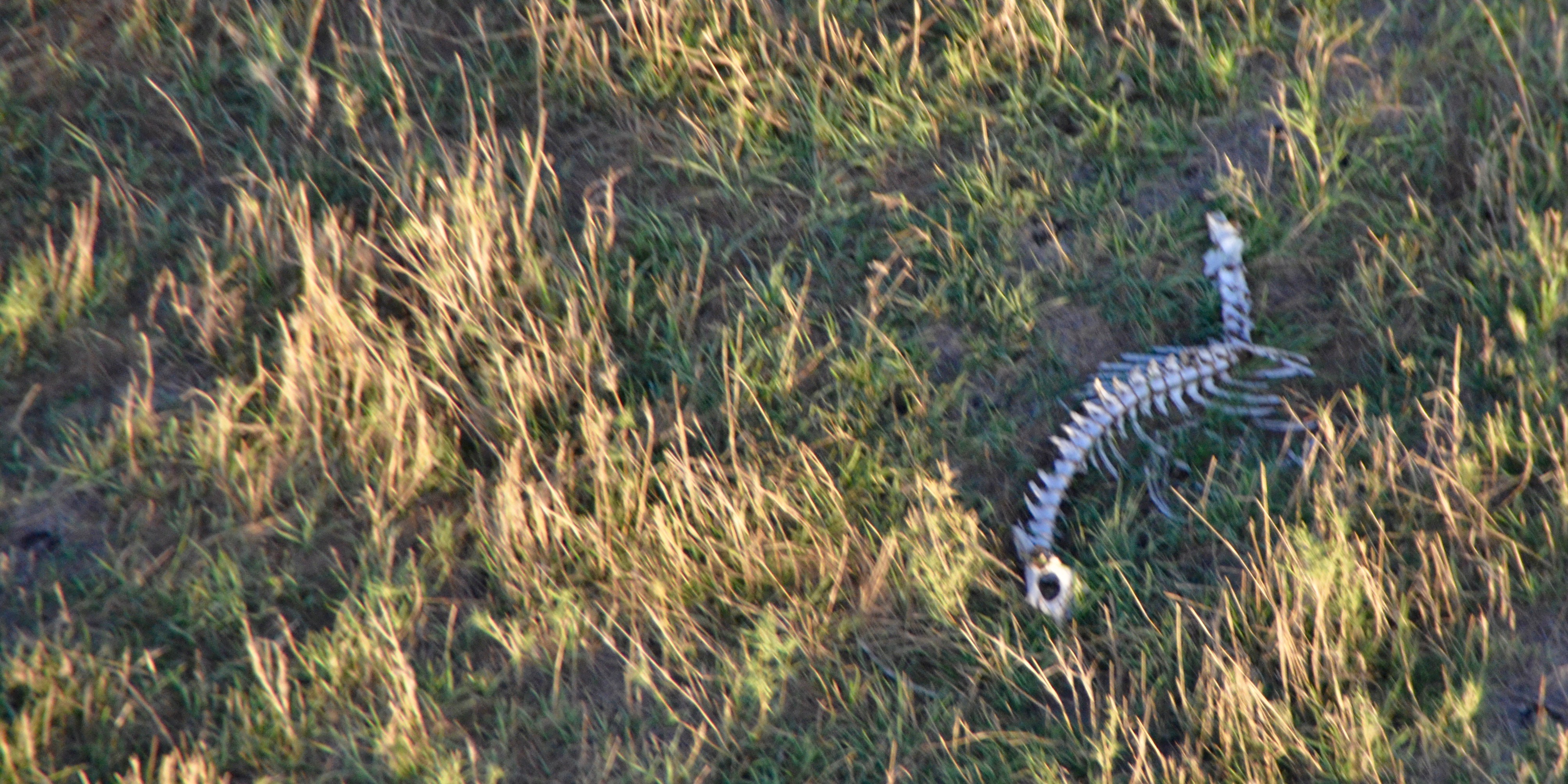
All too soon, Captain Barnabas sights the retrieval truck and the spot chosen for our champagne breakfast. Apparently it differs almost every day. We will land on the open savannah without the protection of being inside the vehicle so I presume they make sure were not landing near a pride of lions. The landing is smooth as silk. We get out and are greeted by this scene.

I had assumed we’d get a glass of sparking wine and something out of a picnic hamper, but they’ve recreated the Fig Tree Camp breakfast buffet right out here in the open, including a made to order omelet station. Captain Barnabas serves as bar tender and explains that the tradition of drinking champagne after a successful balloon flight goes all the way back to the Montgolfier brothers, the inventors of the hot air balloon.
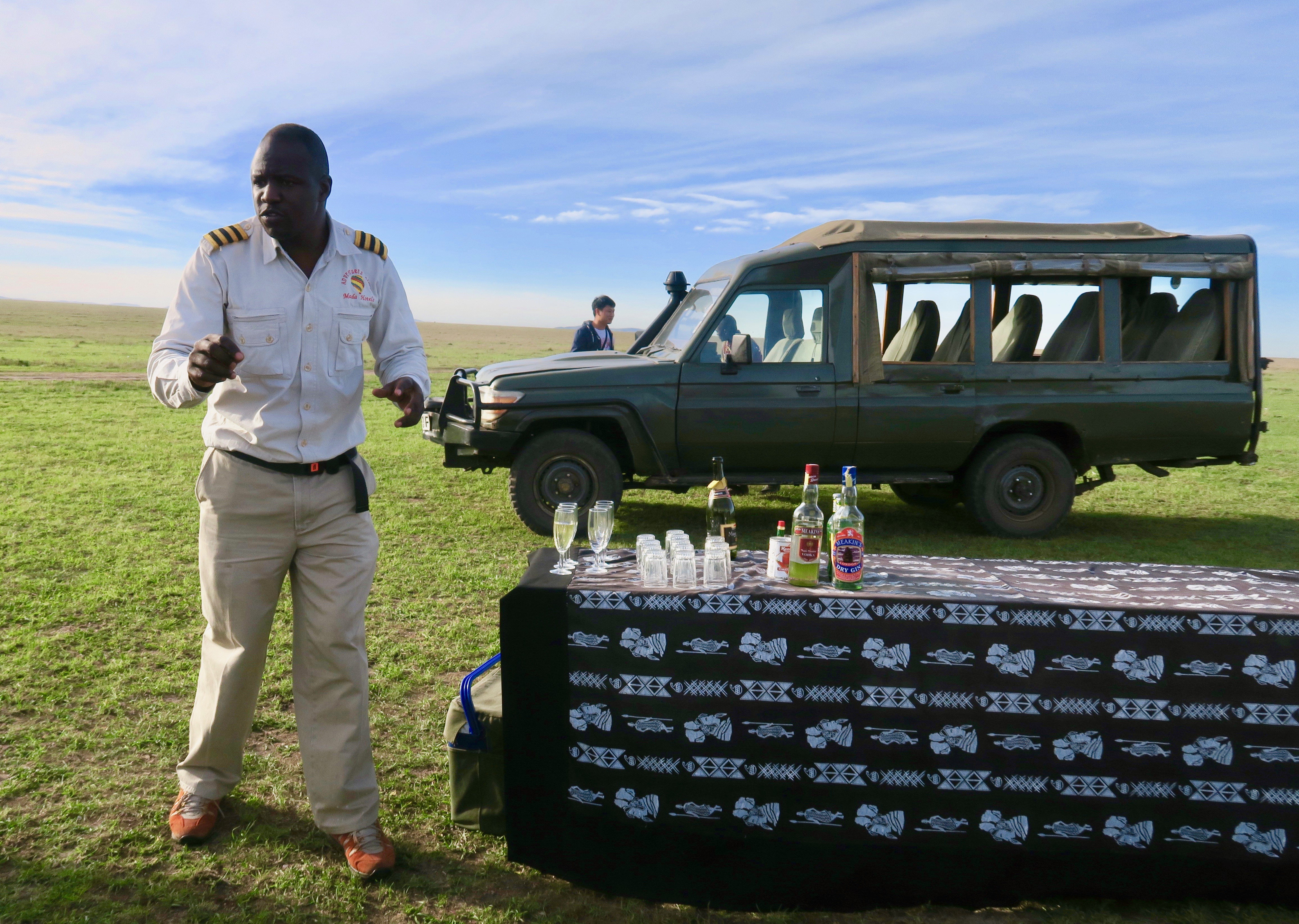
Pretty good way to start the day. After a filling breakfast and a few glasses of champagne, we are driven to a rendezvous with Richard and our two other tour members who have started the morning game drive.
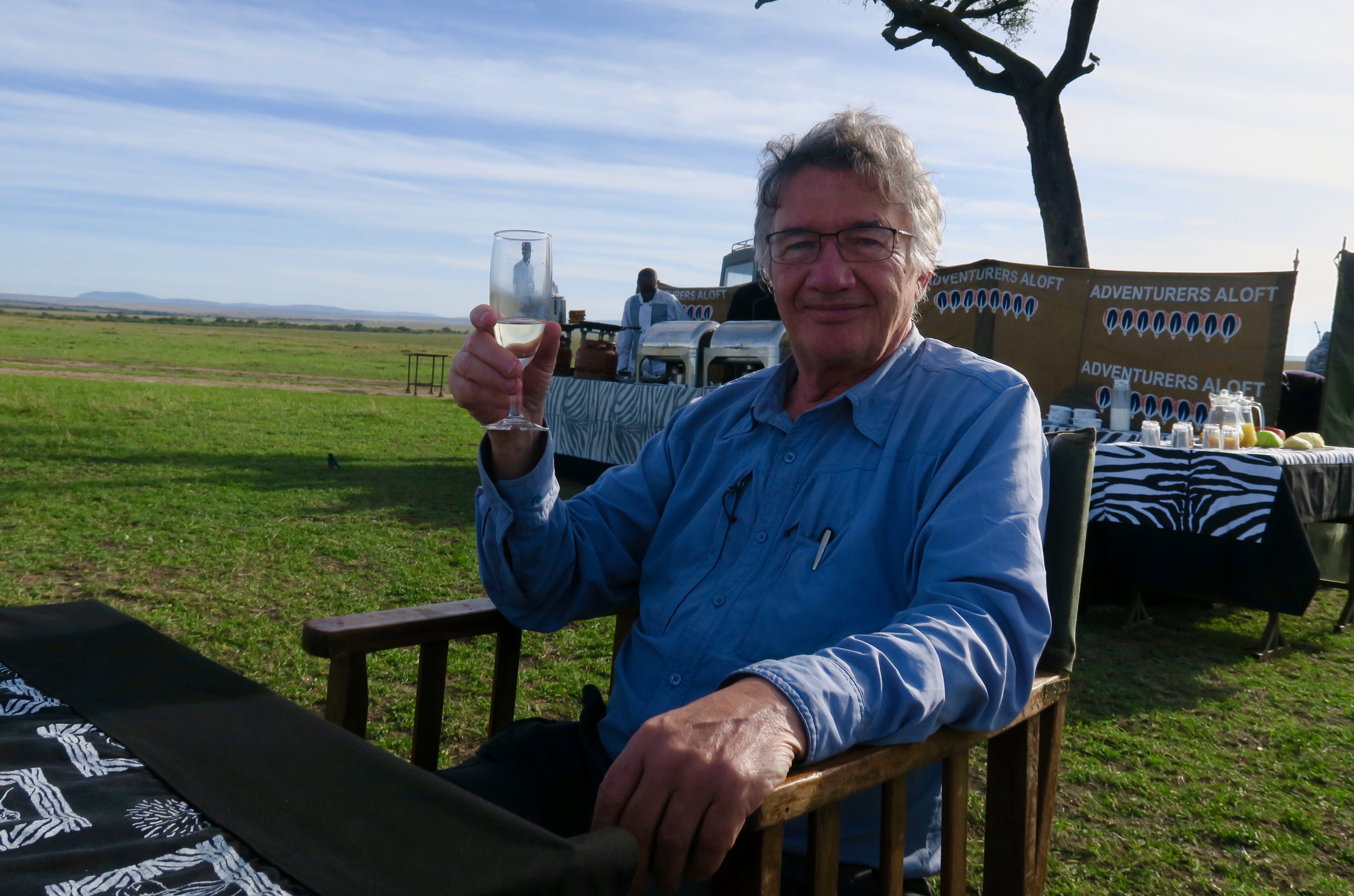
Masai Mara – The Game Drives
As mentioned we had three game drives in Masai Mara and each of them was exciting, successful and different. I’ve created a photo gallery of the best wildlife shots from all of Kenya which you can view so I’ll only go over the highlights of each drive at Masai Mara.
On the first game drive the show was stolen by this somewhat indolent looking leopard. Of the big five (elephant, cape buffalo, rhino, lion & leopard), the leopard is by far the hardest to find. Many people come to Africa and see four of the big five without difficulty, but often leave without spotting (no pun intended) a leopard. Richard’s quick eyes picked out this one lolling on the grass, but from a distance was it quite well camouflaged. It didn’t seem to be bothered a bit by our presence. This was the only leopard we saw in Kenya.
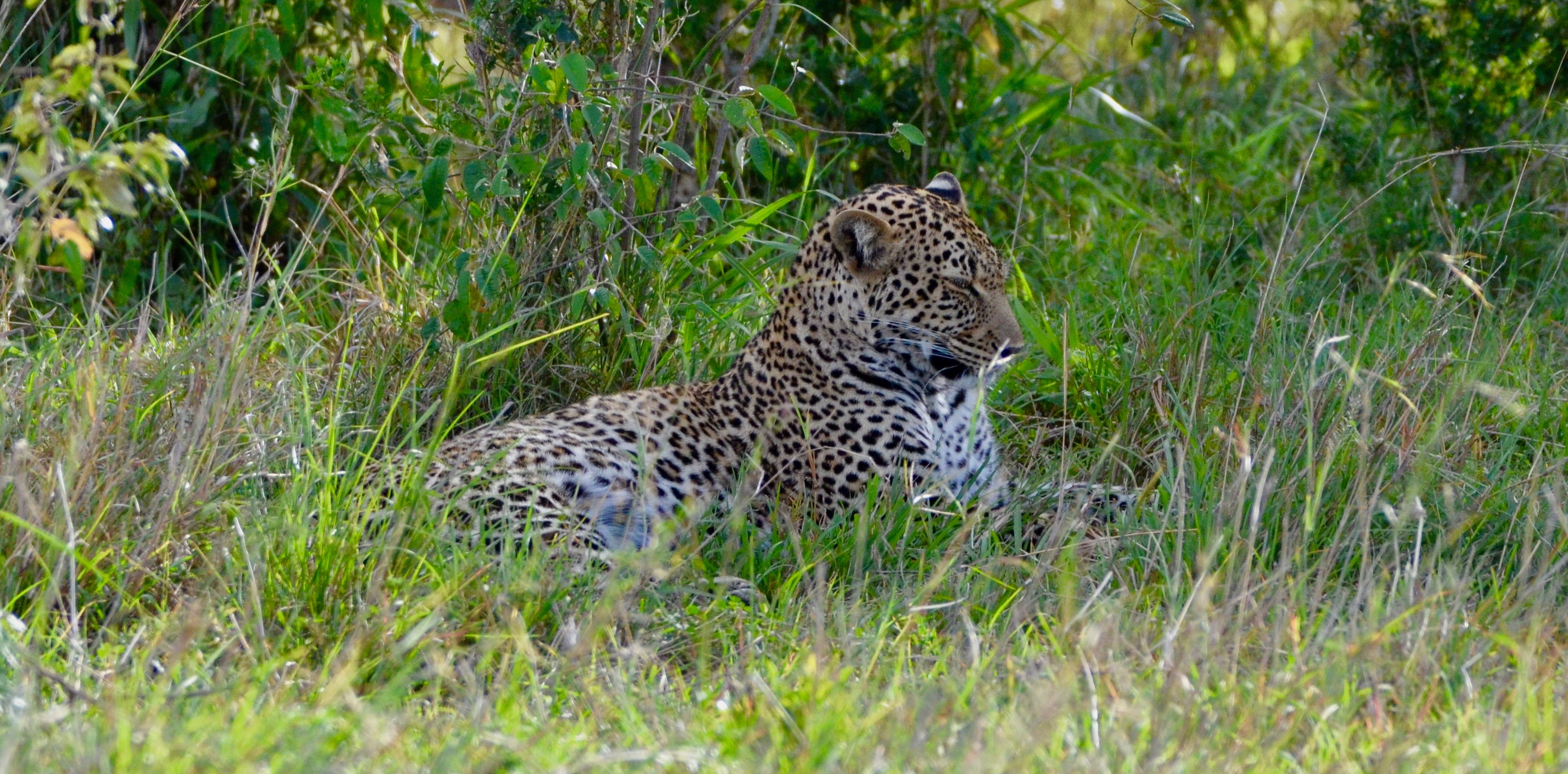
This is a grazing herd of topi, an antelope we had not come across before.
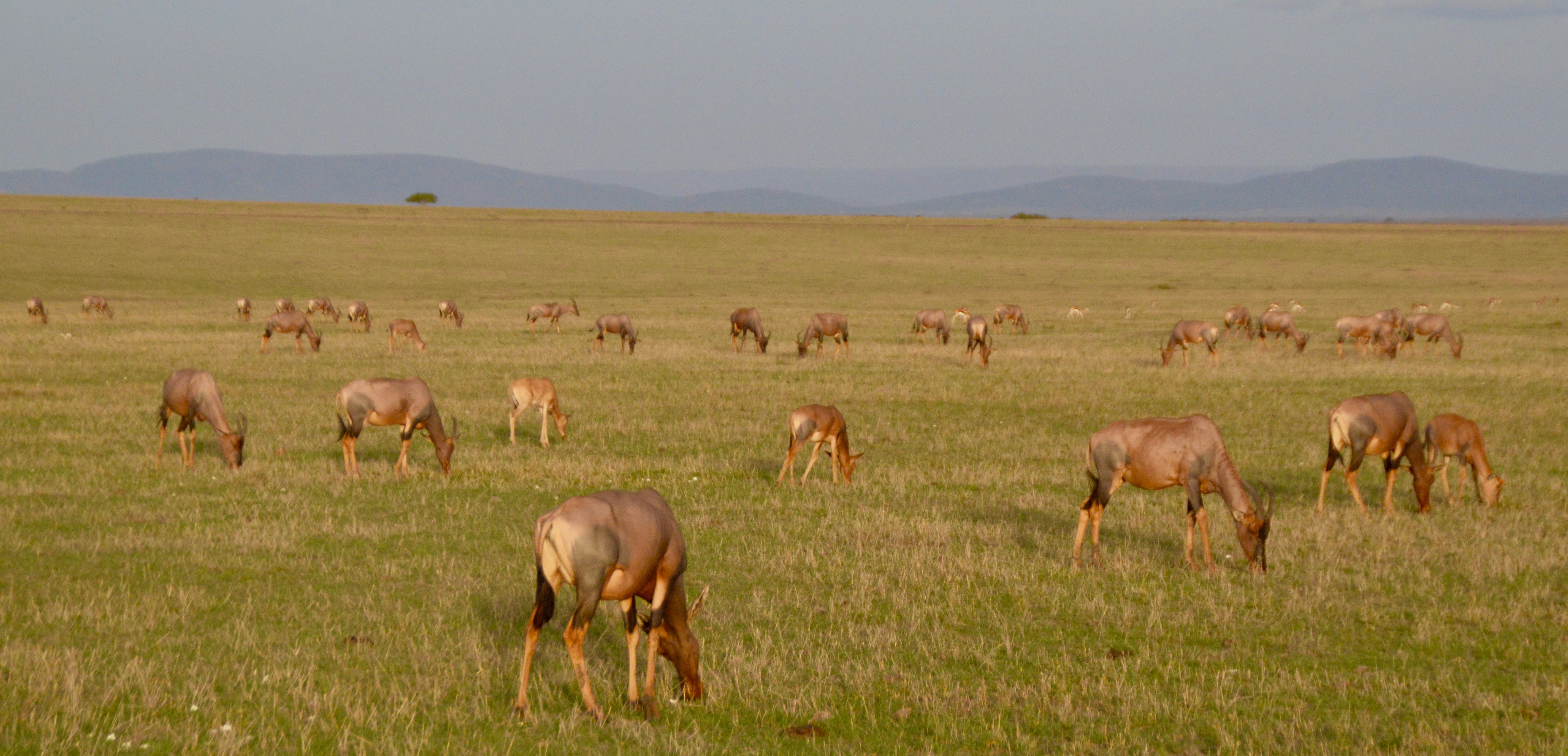
From a distance they look quite splotchy, but closer up are really quite a striking beast.
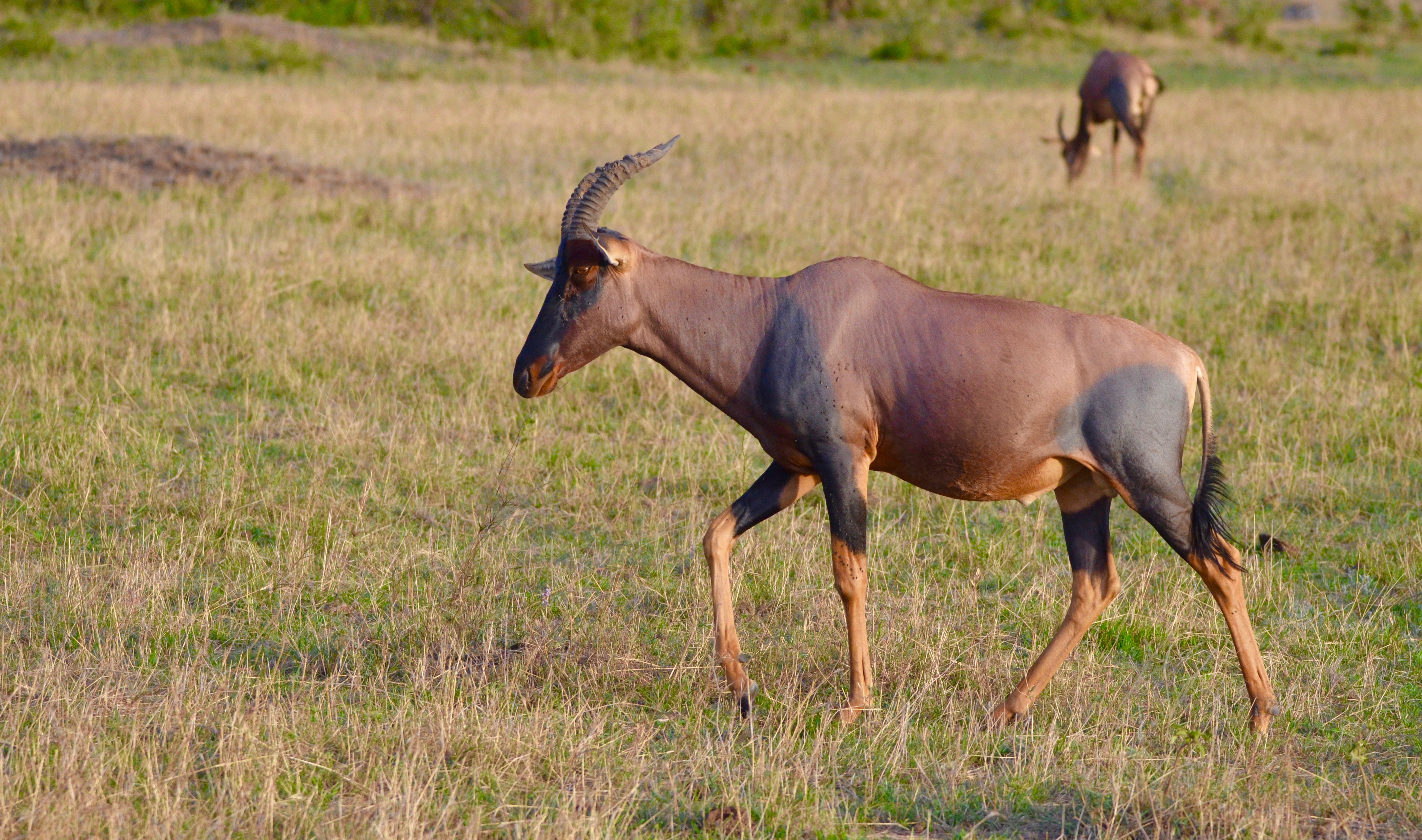
We also saw our first Masai giraffes including this curious youngster.
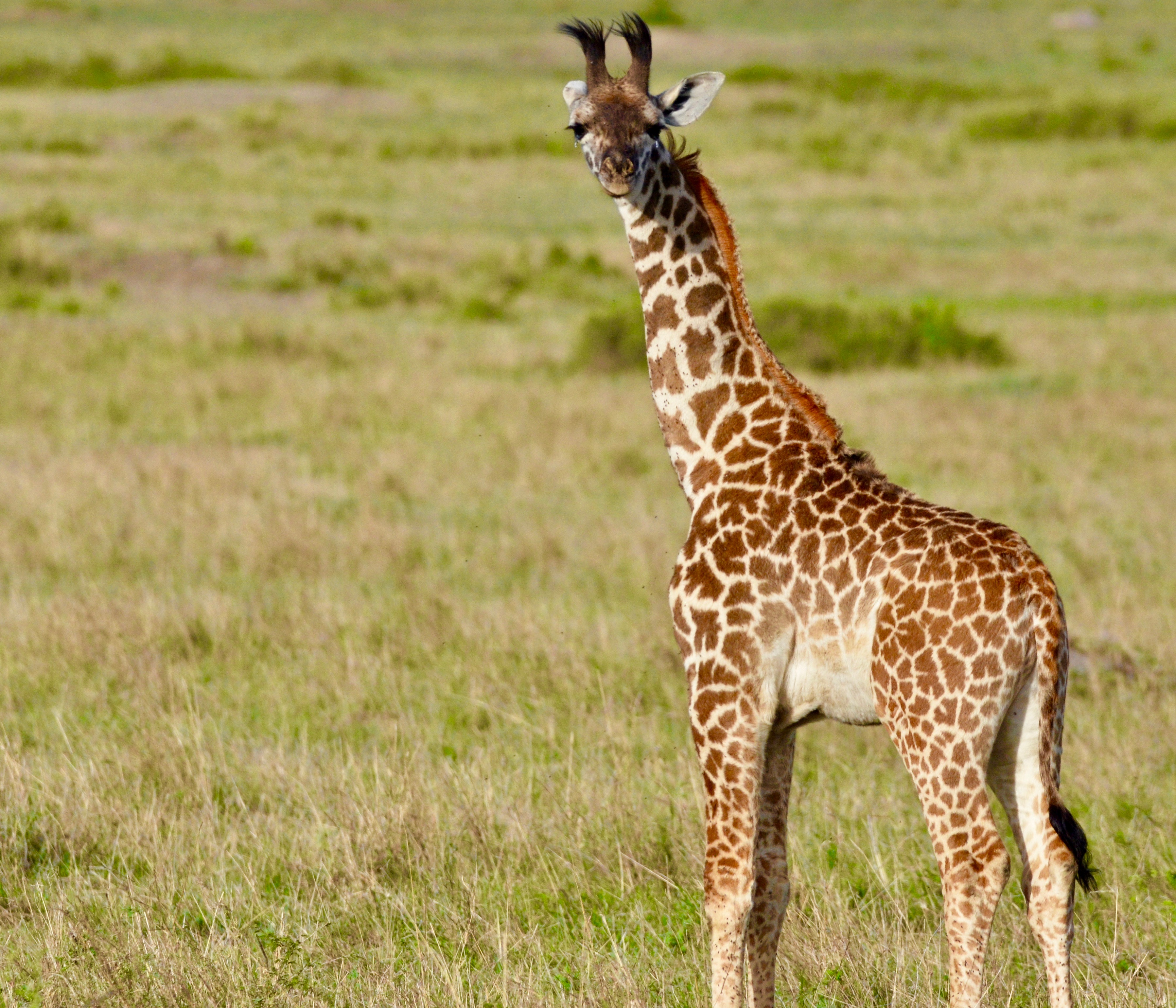
Speaking of youngsters, how about this very young spotted hyena.
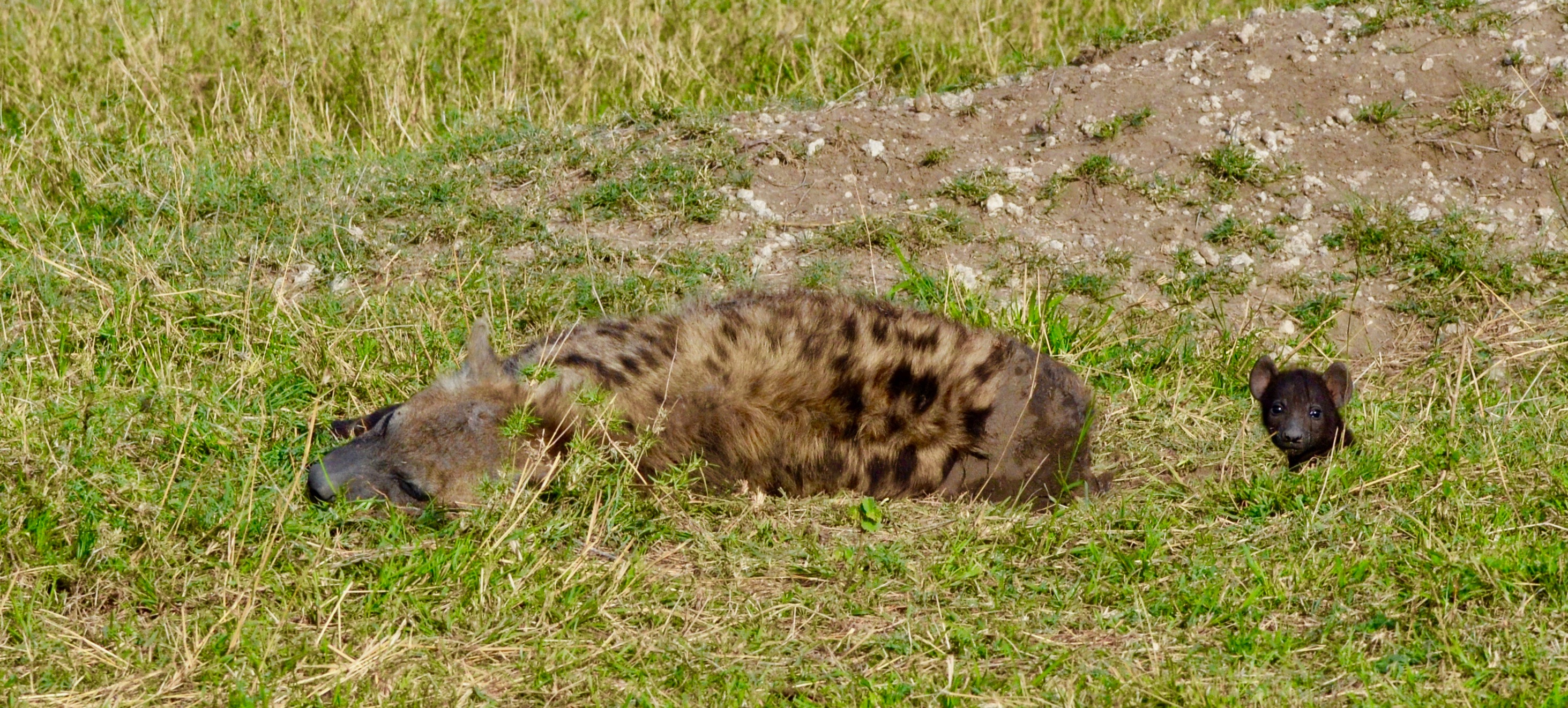
It’s hard to believe he’ll grow up to look this mean.
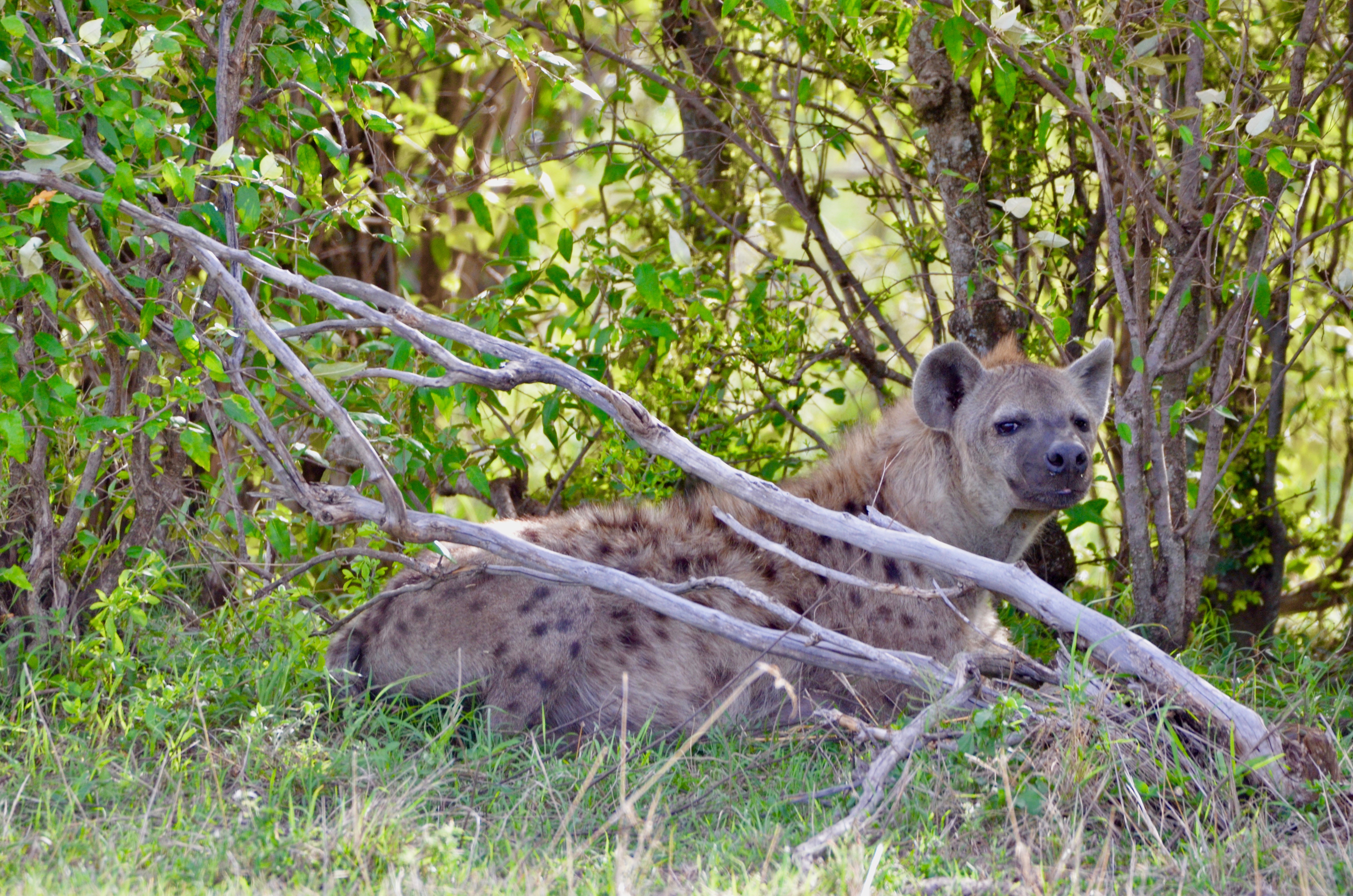
Warthogs are amongst the strangest looking and actually funniest to watch (contrast that to Mr. Hyena above) of all the animals in Masai Mara.
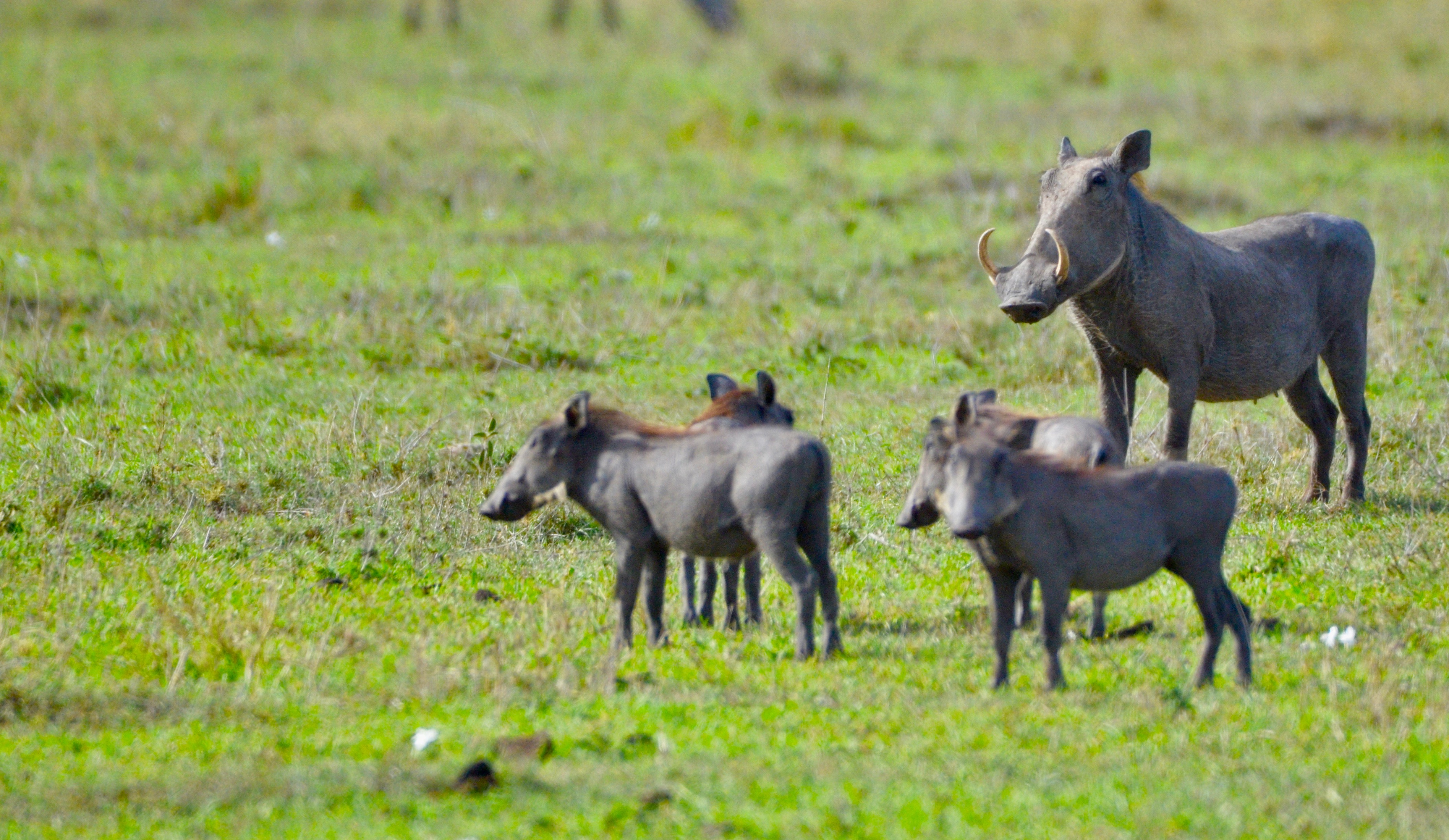
The first game drive also produced a wonderful full grown male lion who gave us an obligatory roar, or was it a yawn, that could have come straight from the MGM logo.
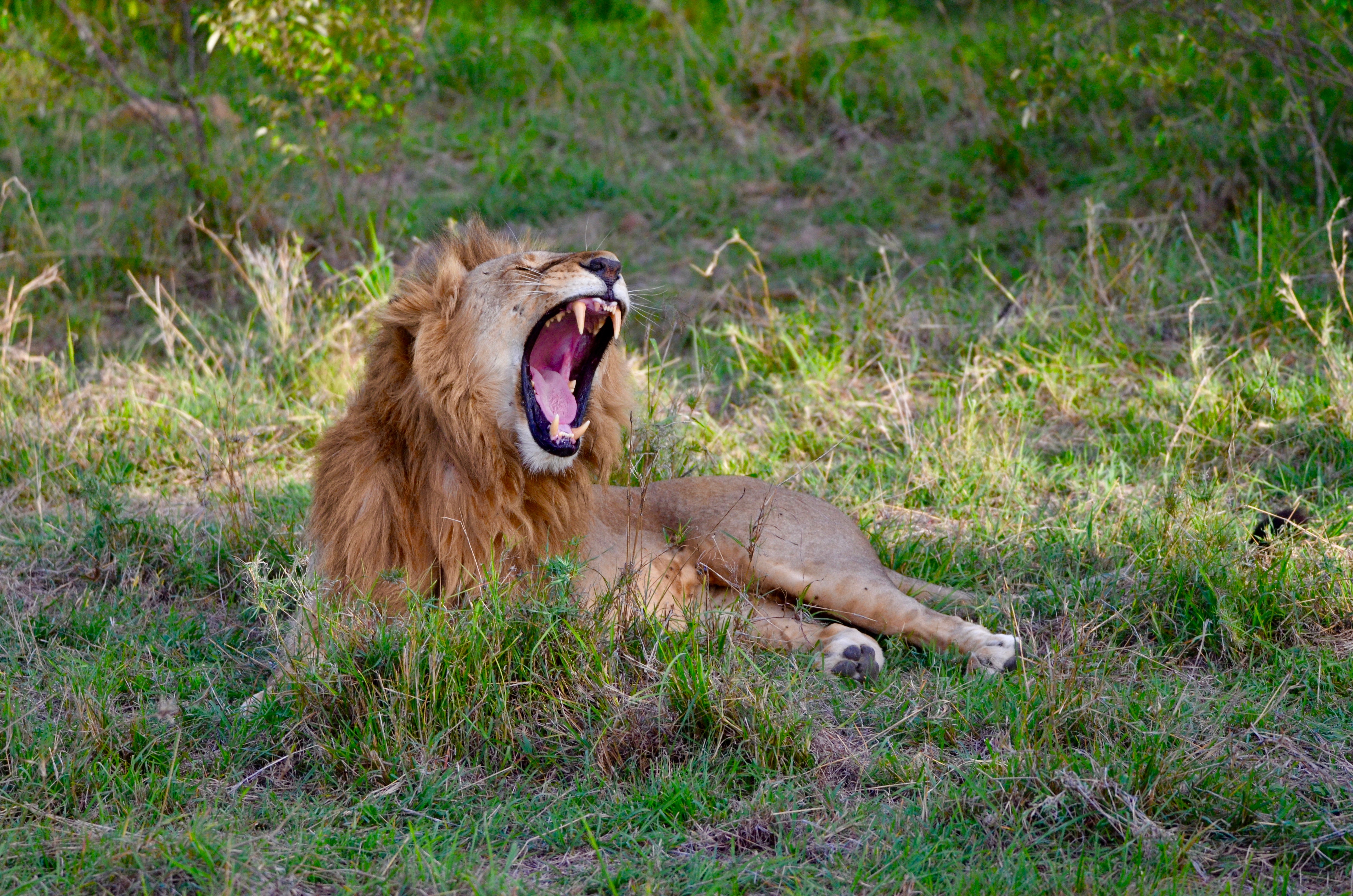
The final highlight of the first Masai Mara game drive was this tiny and elusive dik-dik, the smallest of the antelope species.
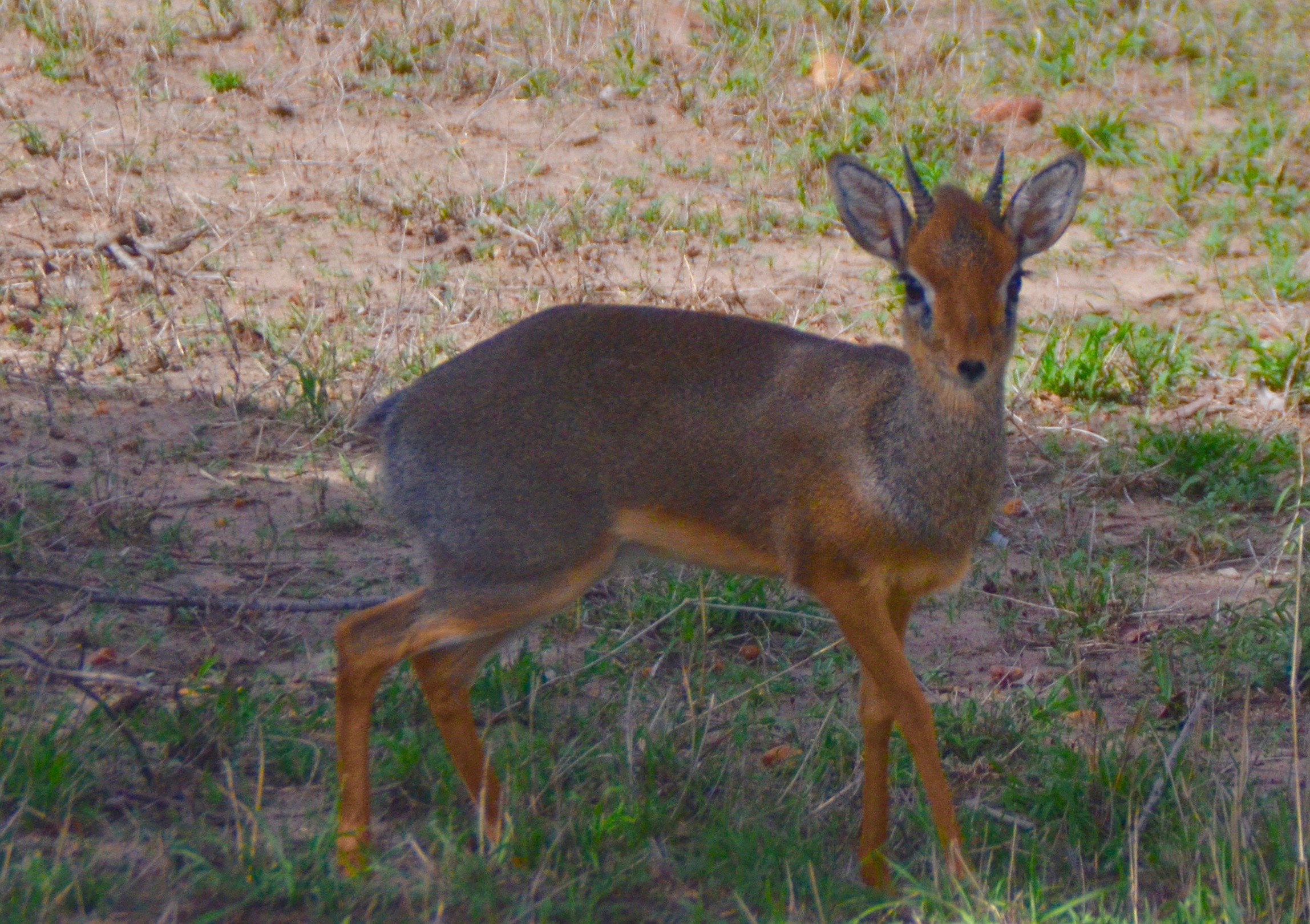
On the second game drive we got to experience Masai Mara at its rawest and bloodiest as we came across this young Cape Buffalo that had been killed by a pride of lions who literally were sticking their heads inside the carcass to rip it apart from the inside. This curious cub got right on top of the body to see close up, how it was done.
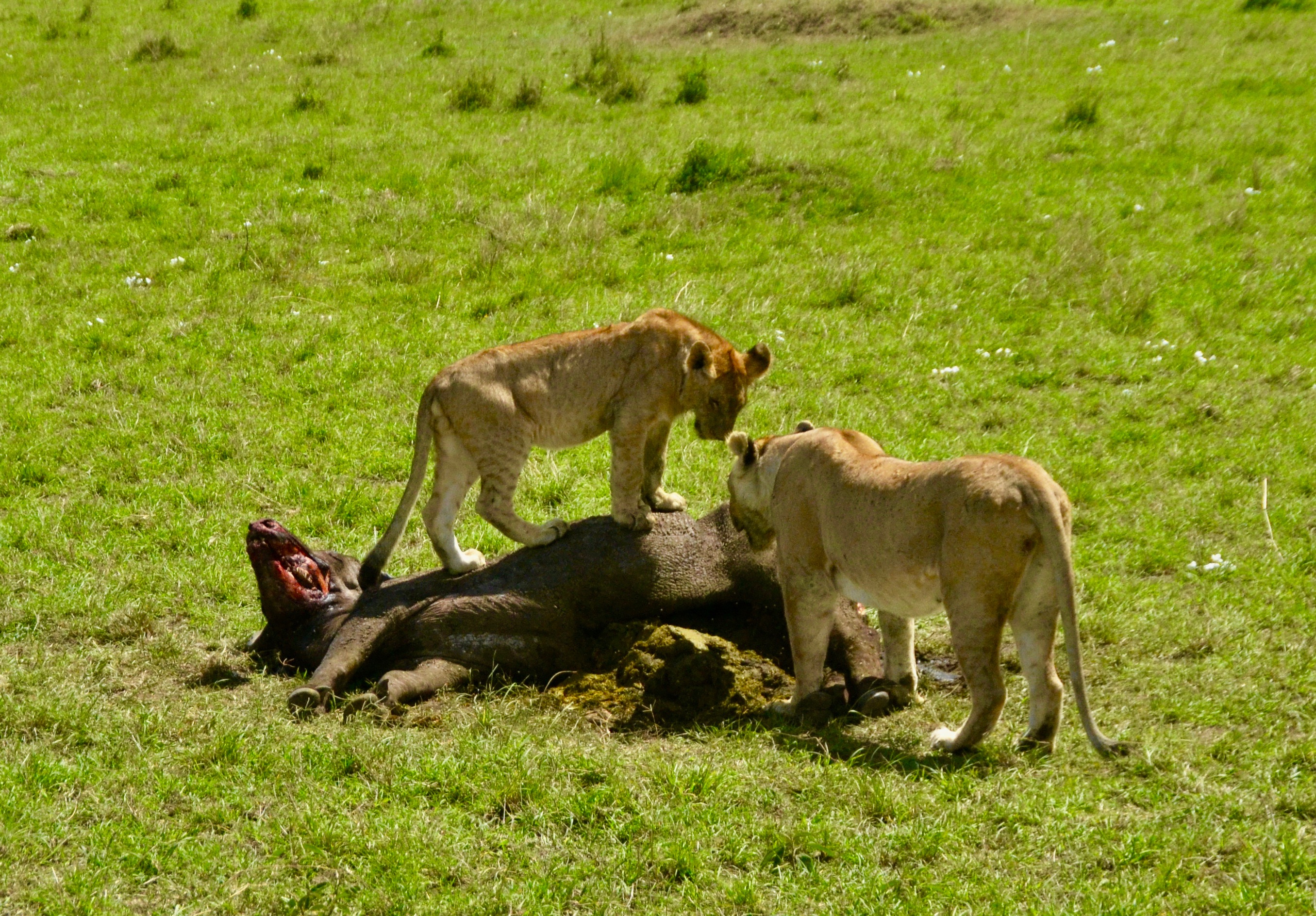
We covered a lot of ground on the second drive, driving up to the top of a rise which was one of the few spots you could safely exit the vehicle and stretch your legs.
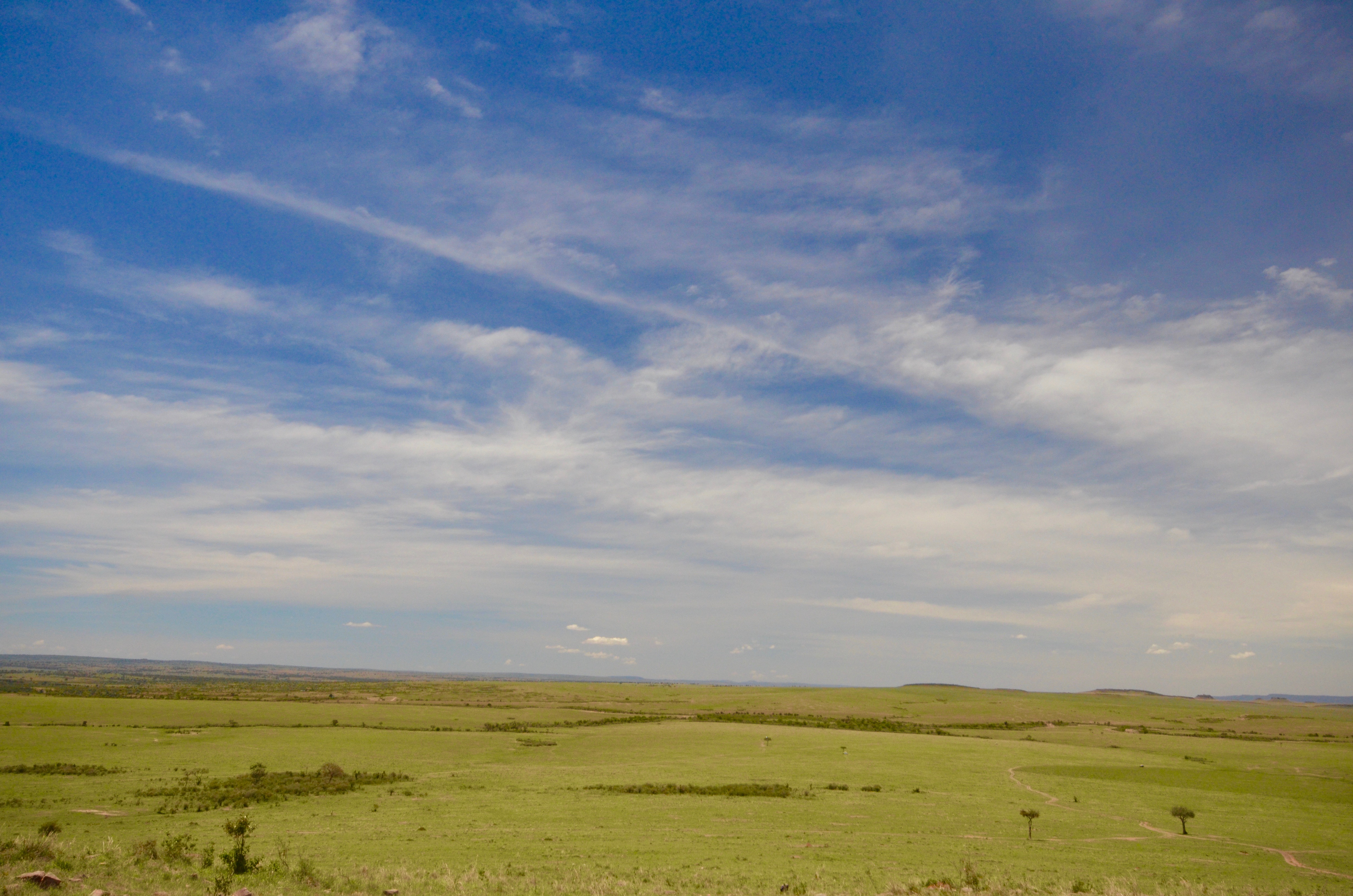
Some of the firsts on this game drive were two cheetahs, neither camera shy. Isn’t this one of the most magnificent creatures on earth? How we could drive it to the brink of extinction is simply beyond comprehension.
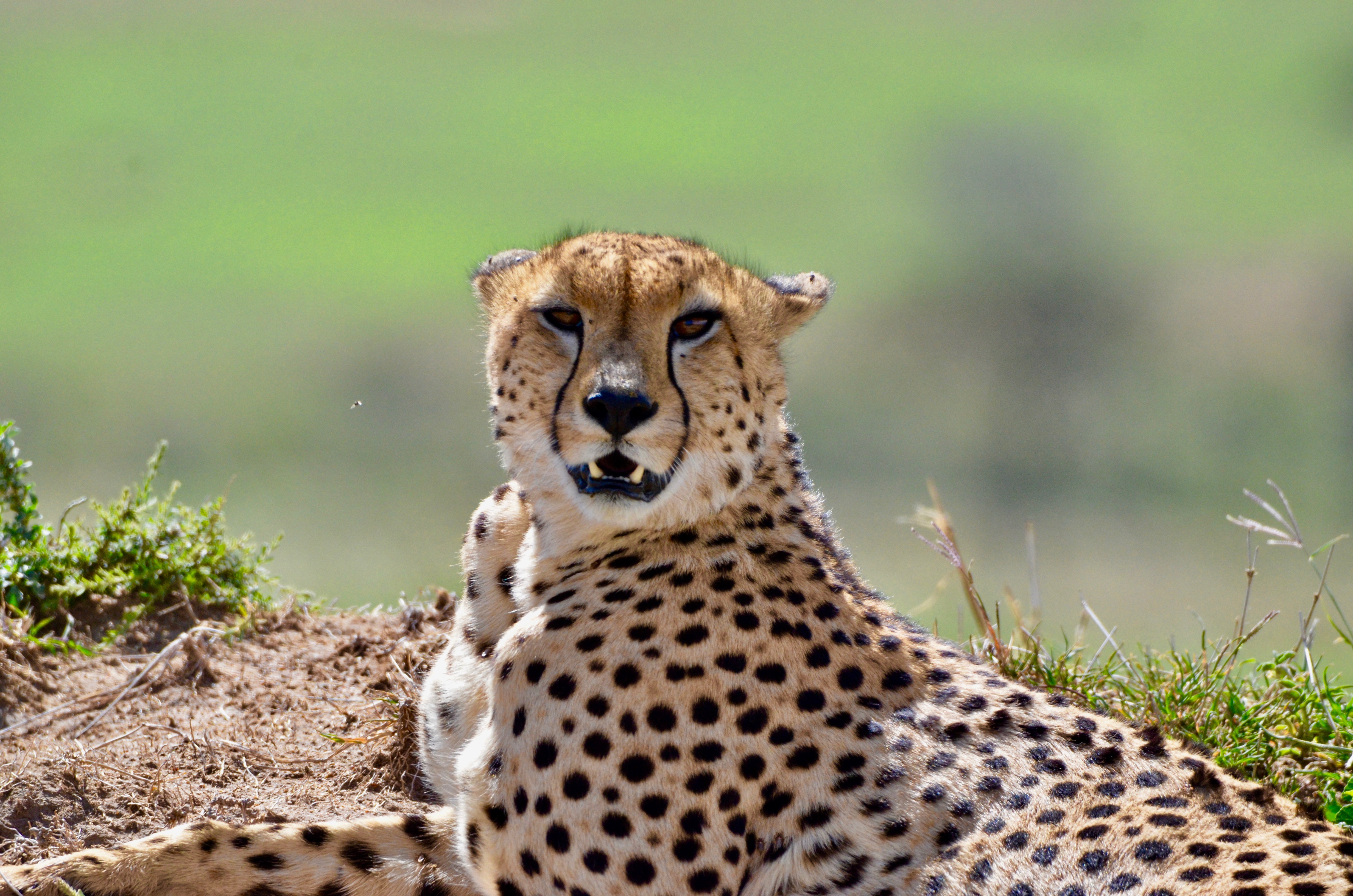
Another first was large numbers of banded mongoose which were quite entertaining as they moved forward as a body, but always with at least one sentry standing erect, much like meerkats.
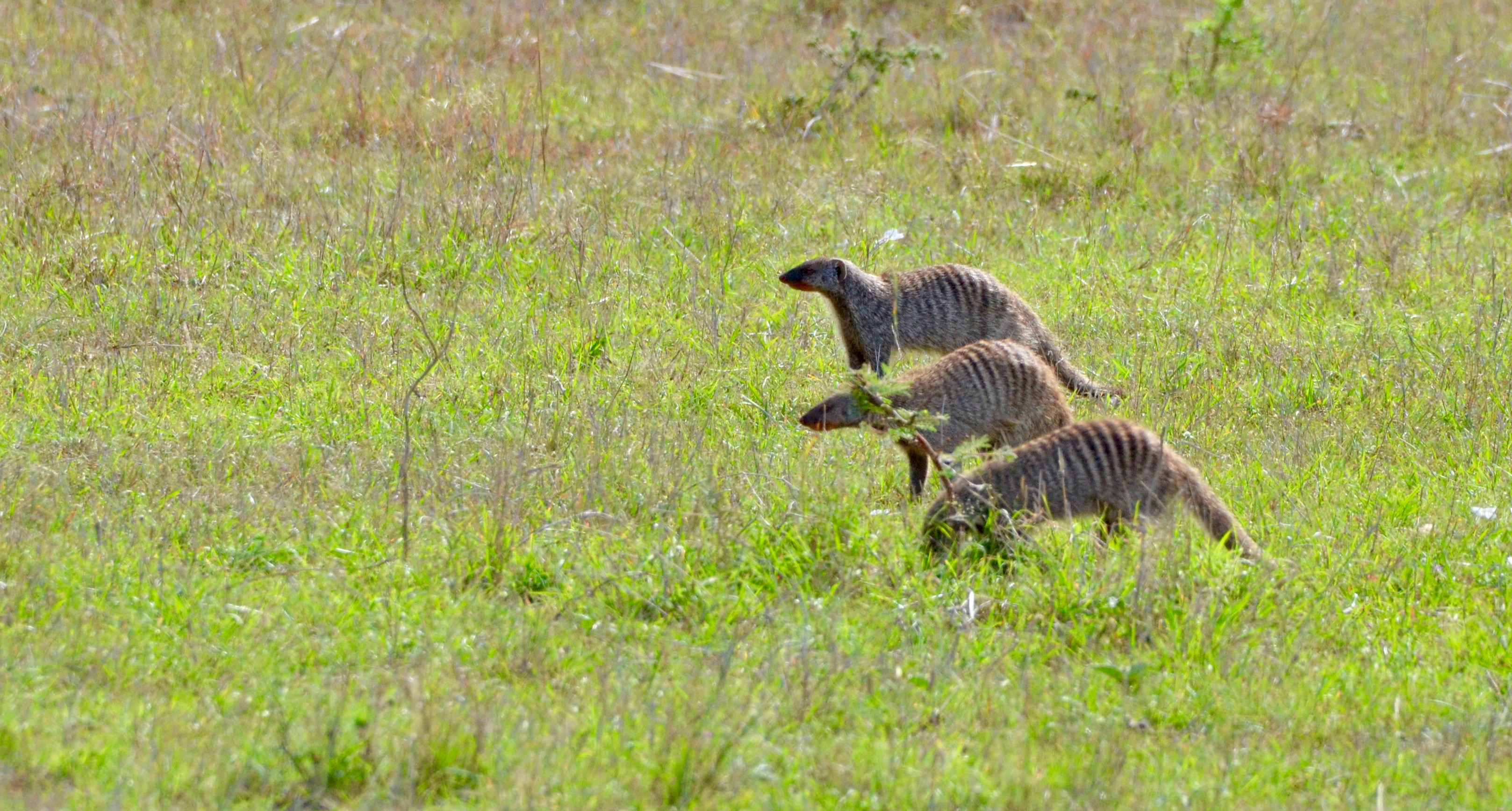
Another first was this Coke’s Hartebeest, not the smartest looking animal on the savannah.
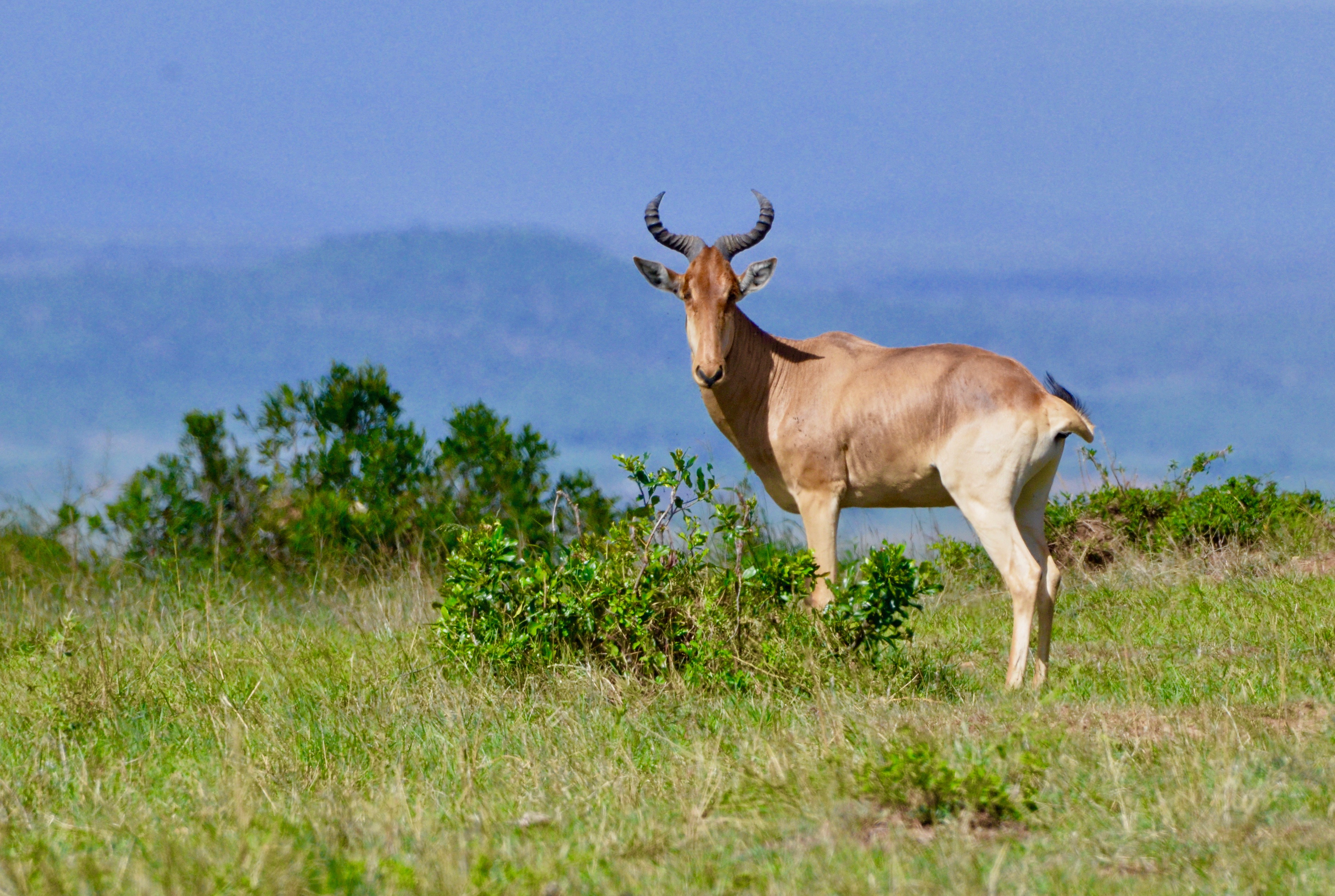
On this drive, which lasted all day, we reached the fabled Mara River which flows all the way to Lake Victoria. This is one of the areas where the wildebeests and zebras cross during migration. It looks harmless enough, but from the video above the crossings occur when there is a lot more water in the river.
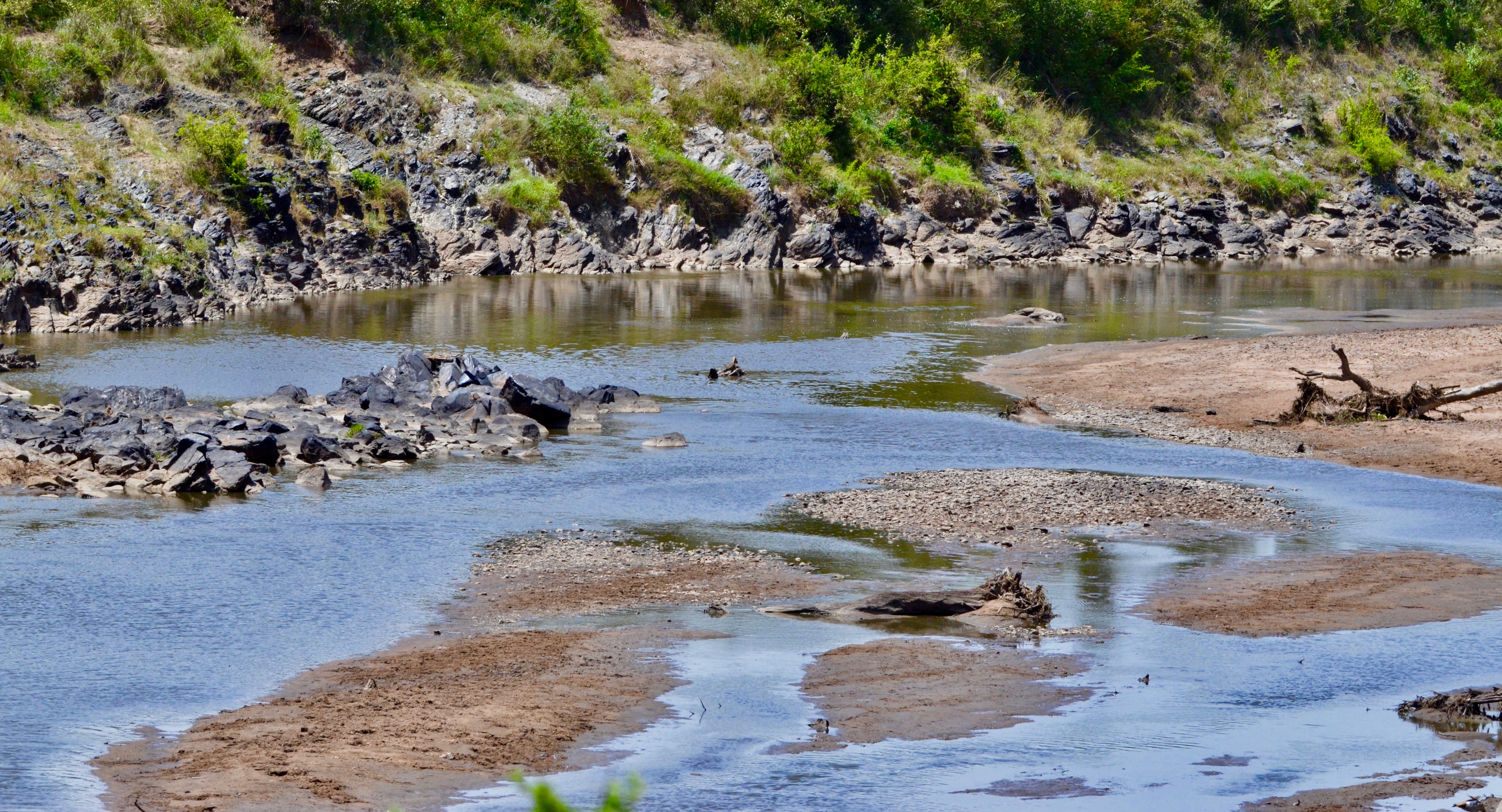
Still the river was high enough to support a fairly large number of hippos who basically just lie in the water up to their eyeballs and nostrils and wile away the day until they come ashore to feed at night.
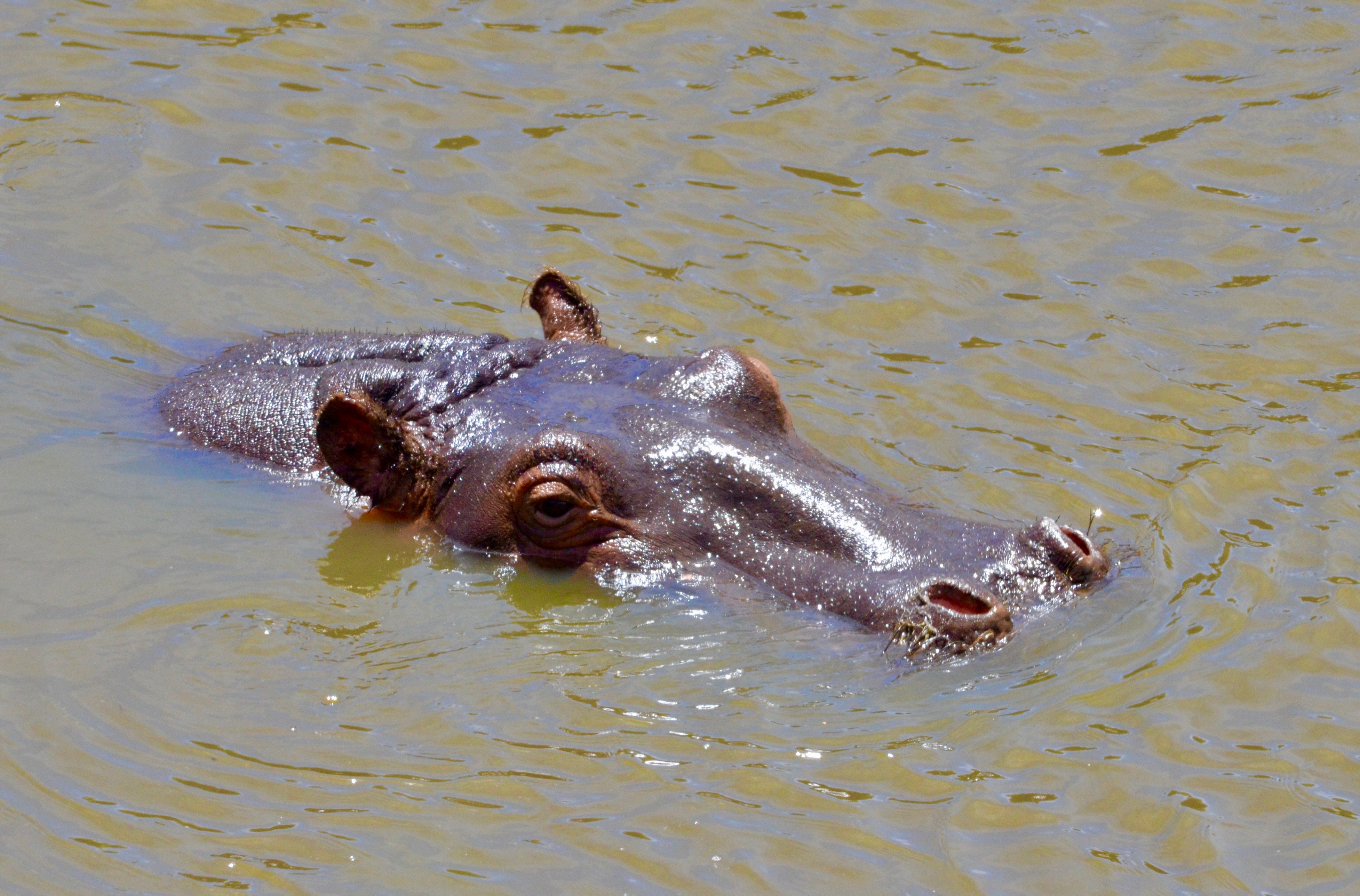
Today’s drive proved to be a great opportunity for viewing some of East Africa’s largest and most desirable birds, from a birder’s point of view including our one and only spotting of the secretary bird, a snake killer without an equal in the avian world.
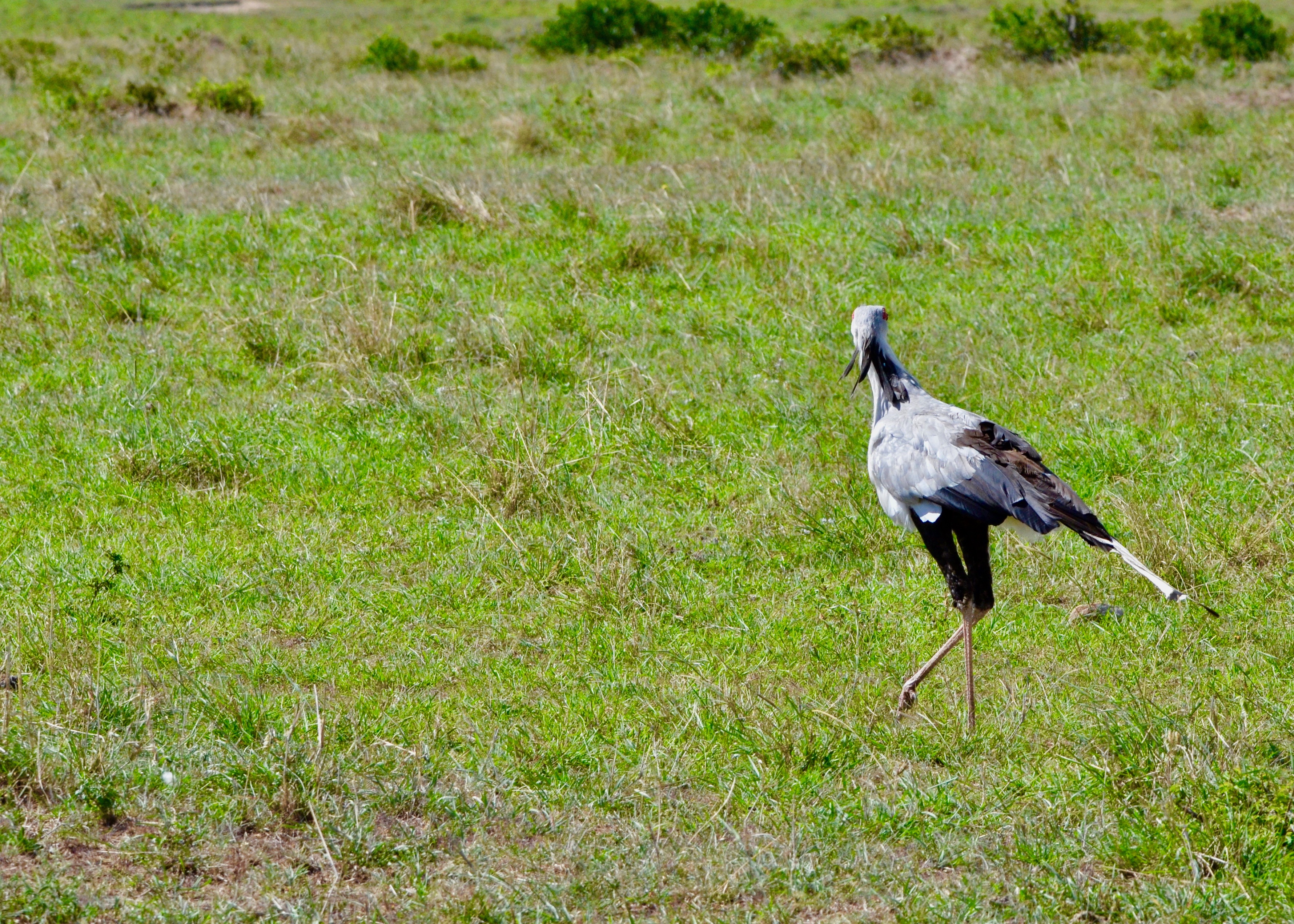
Two hammerkops which can build a nest that weighs a ton.
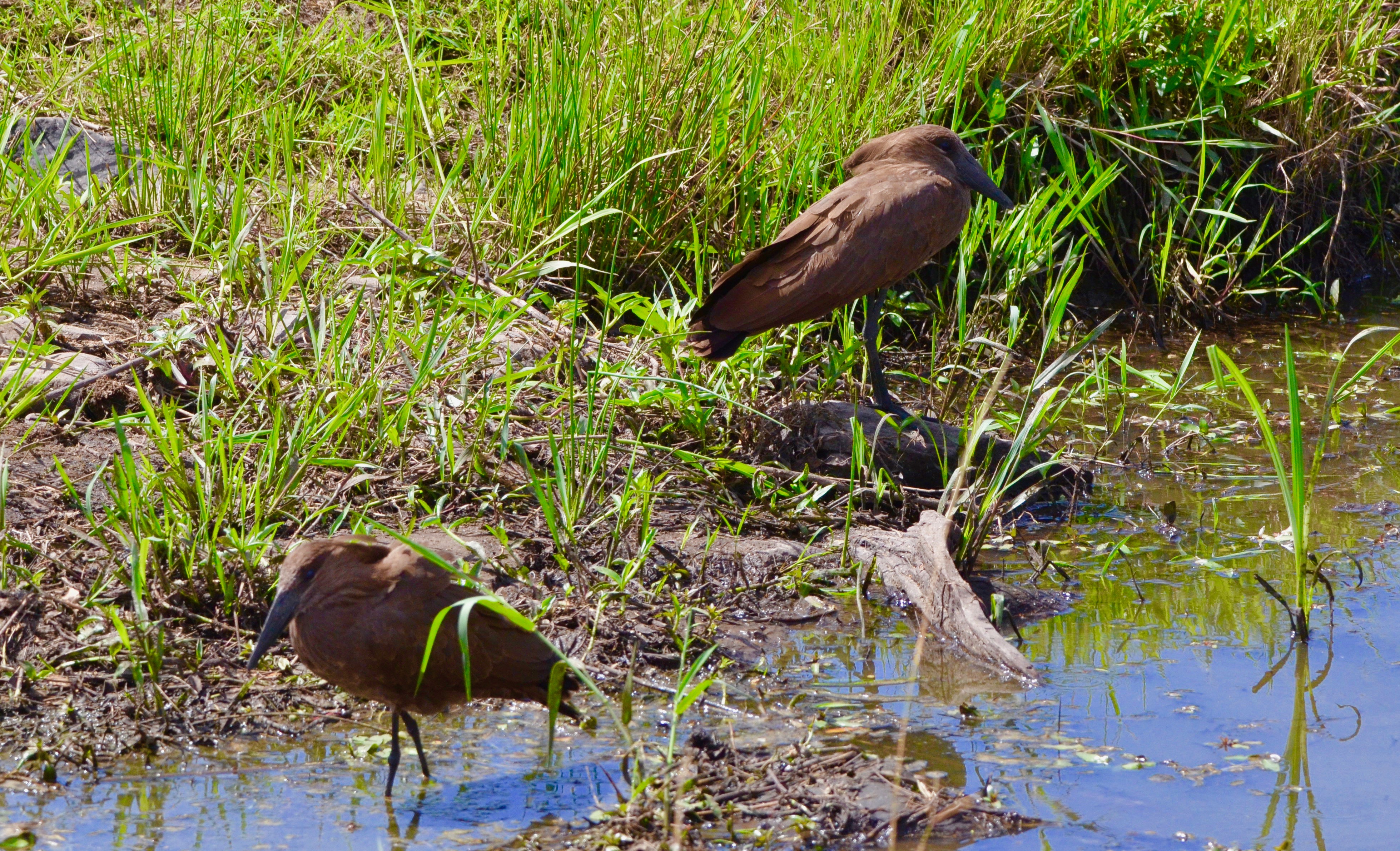
The strange looking, but still beautiful saddle-billed stork.
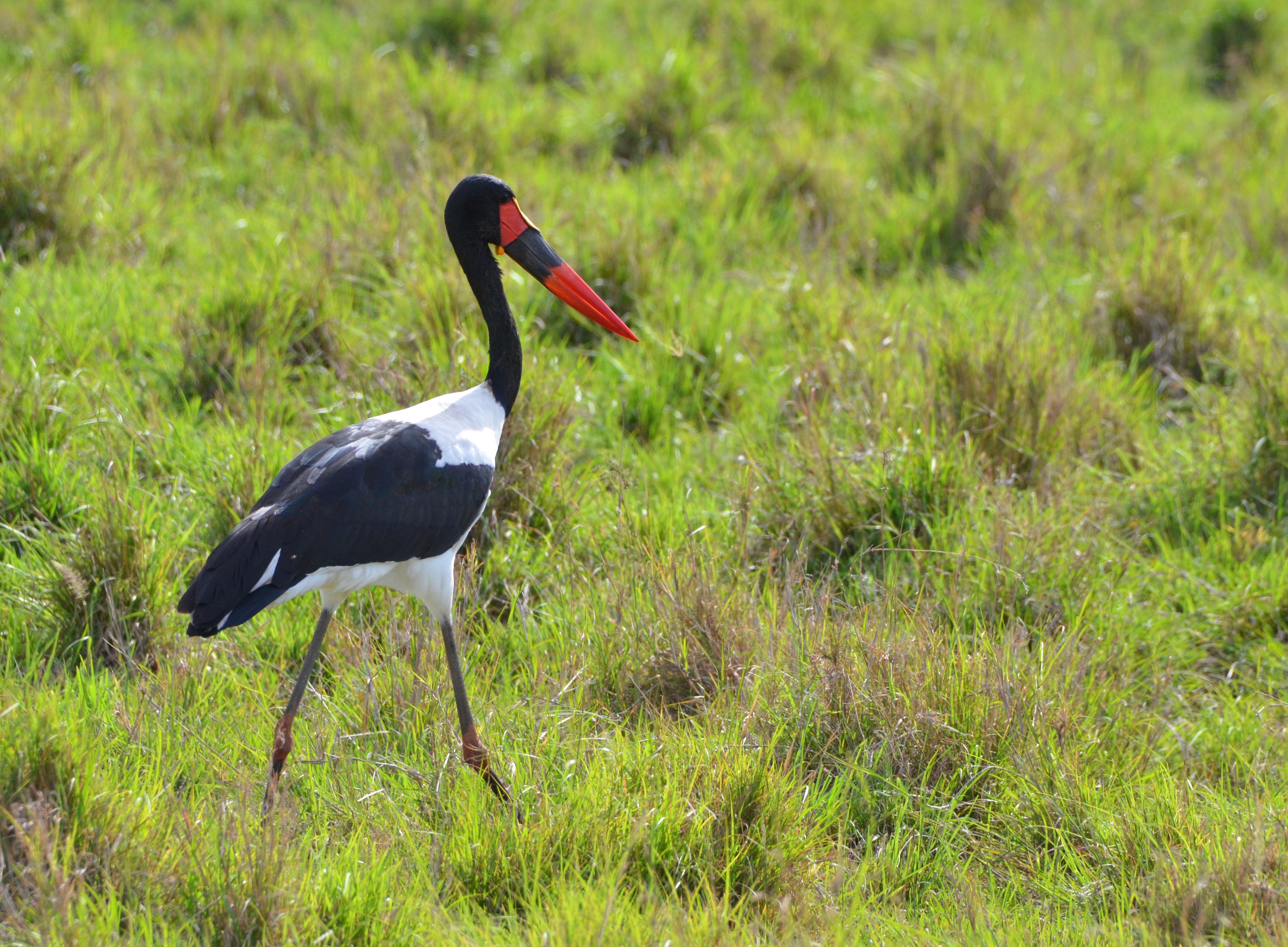
Lastly, the quite rare woolly-necked stork.
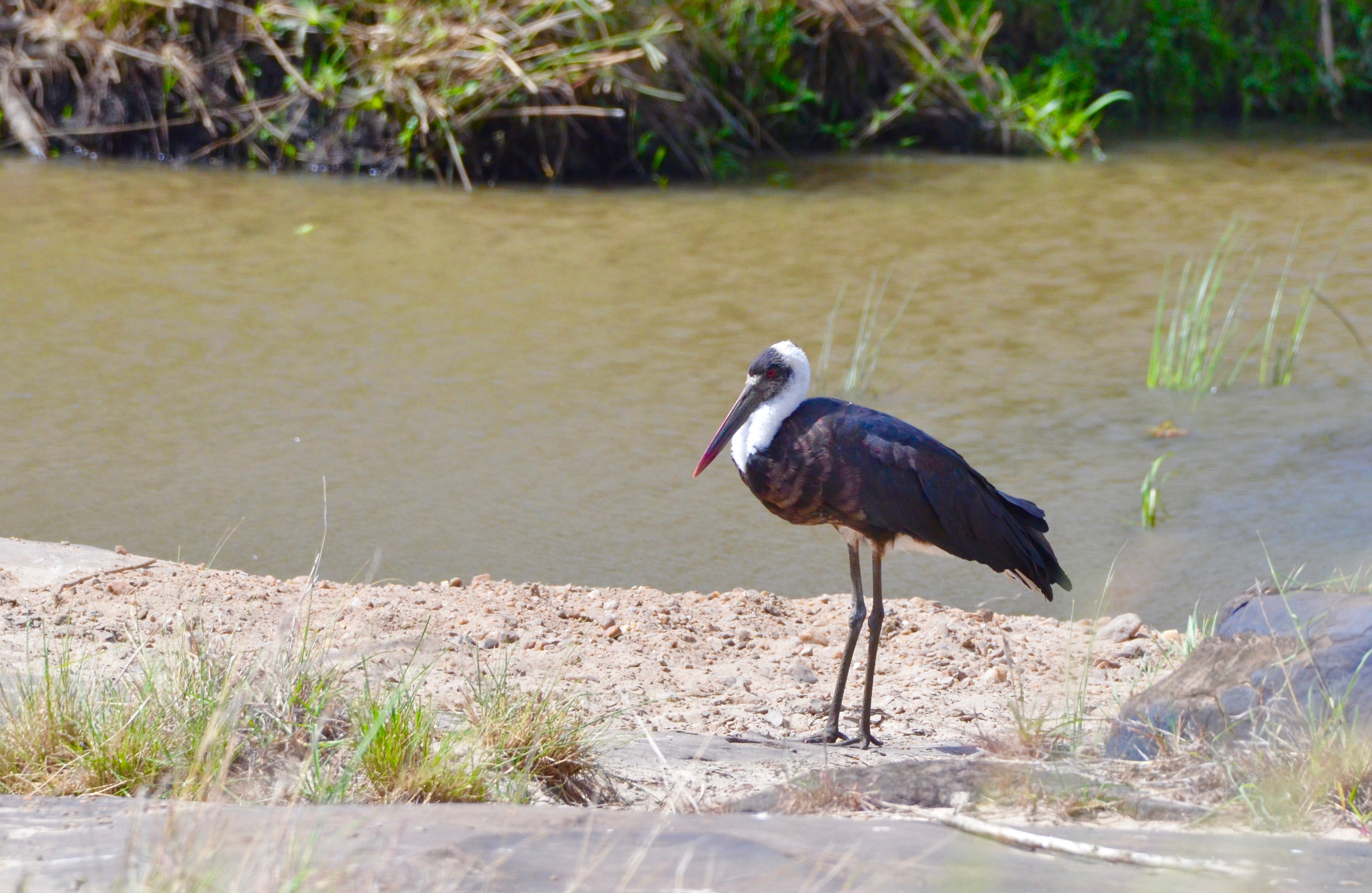
Given that we were out all day we had to stop for lunch somewhere and that turned out to be under a solitary tree that provided some well appreciated shade. Richard pulled everything we needed out of a hamper and we all enjoyed our picnic on the savannah. I have a feeling it’s a pleasant memory I’ll carry with me for the rest of my life.
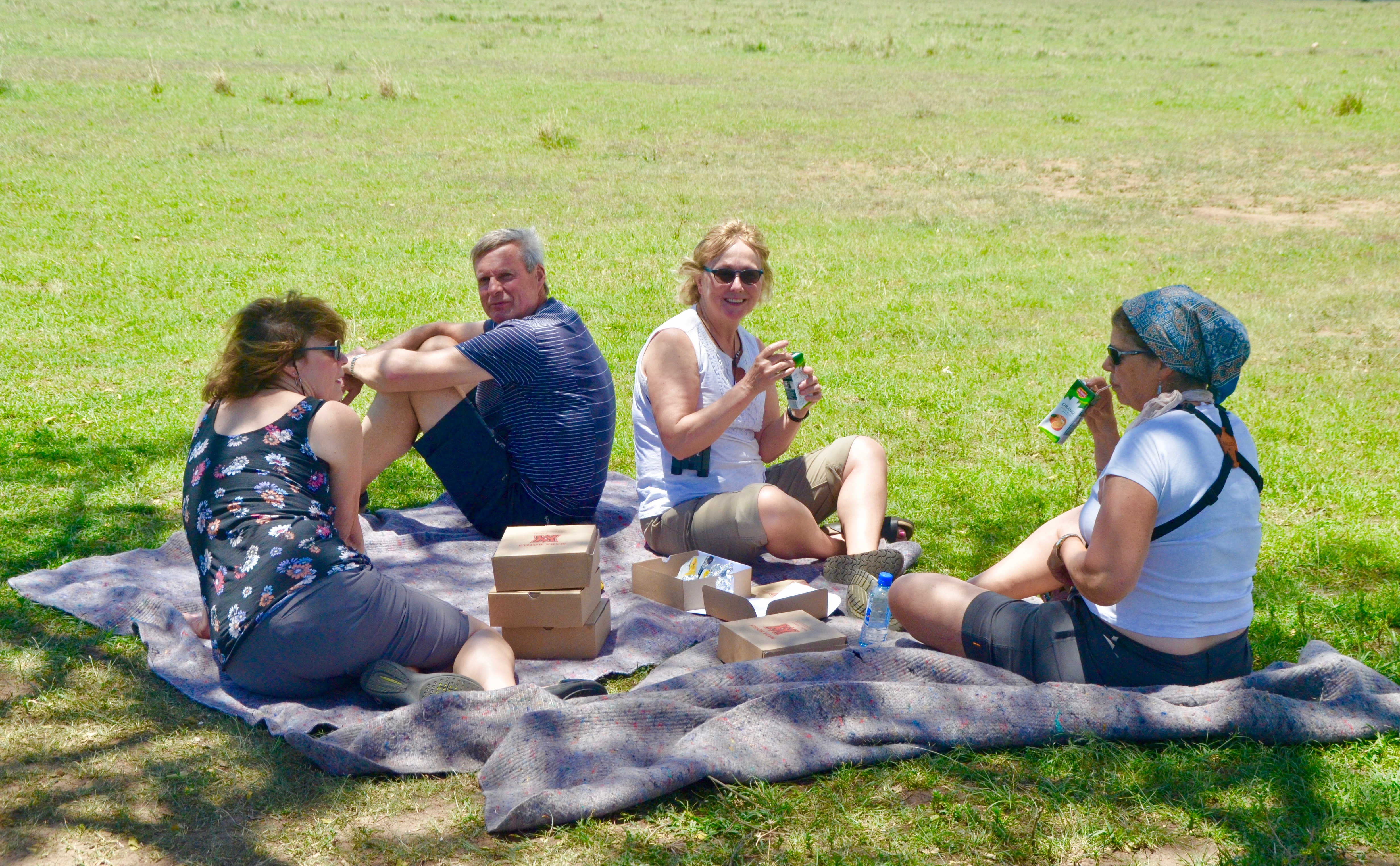
We saw more game on this day long excursion than on any other drives including quite a few lions, lots of giraffes, elephants and other large animals that were by now becoming ‘old hat’. A couple more one time sightings included this reedbuck and two does which were quite shy.
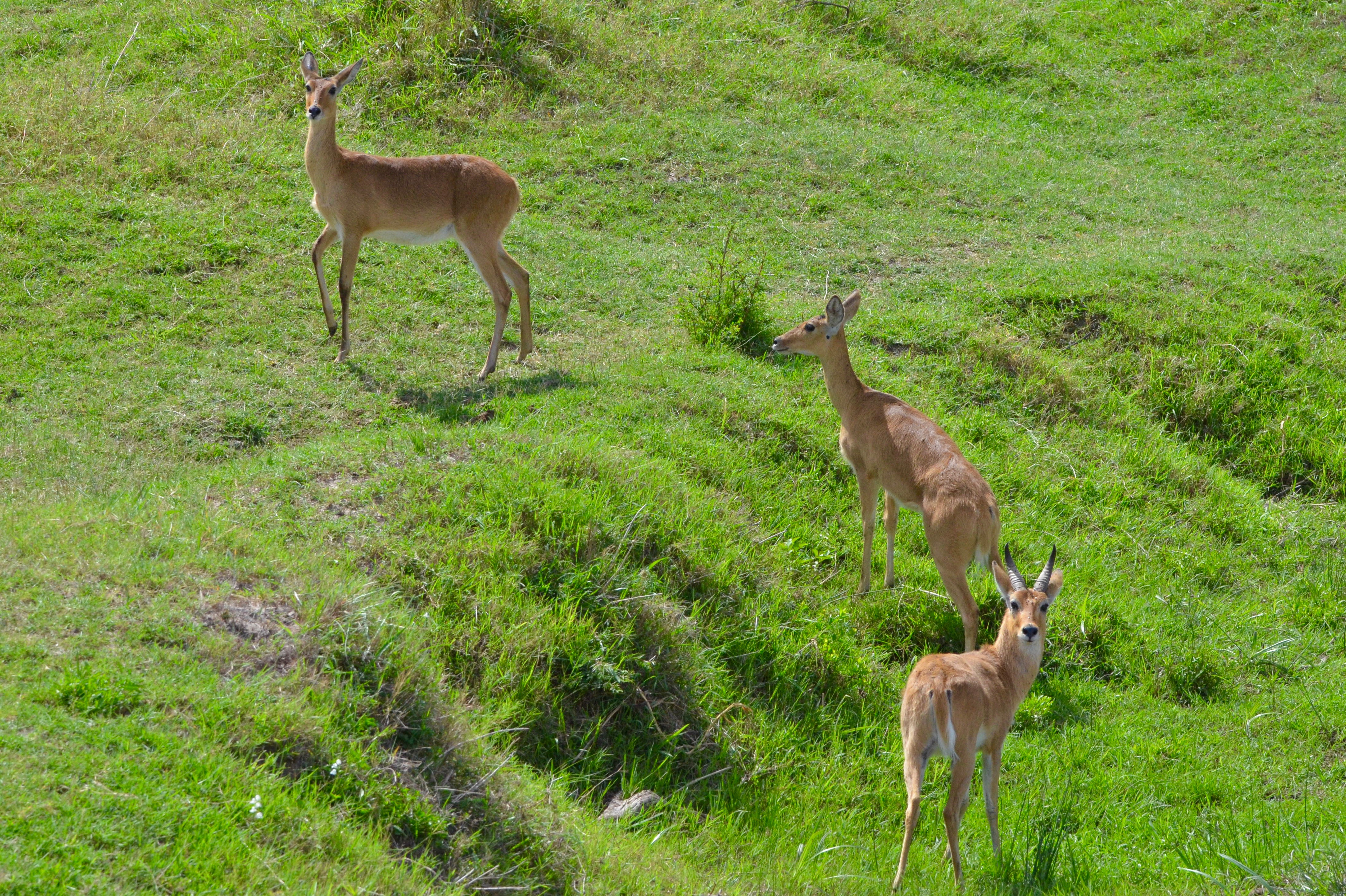
In videos and TV shows you watch about the Serengeti there seem to be jackals everywhere, but not so, at least this week, in Masai Mara. We saw very few, but did get a good look at this silver back jackal which reminded me in size and gait very much of our North American coyote.
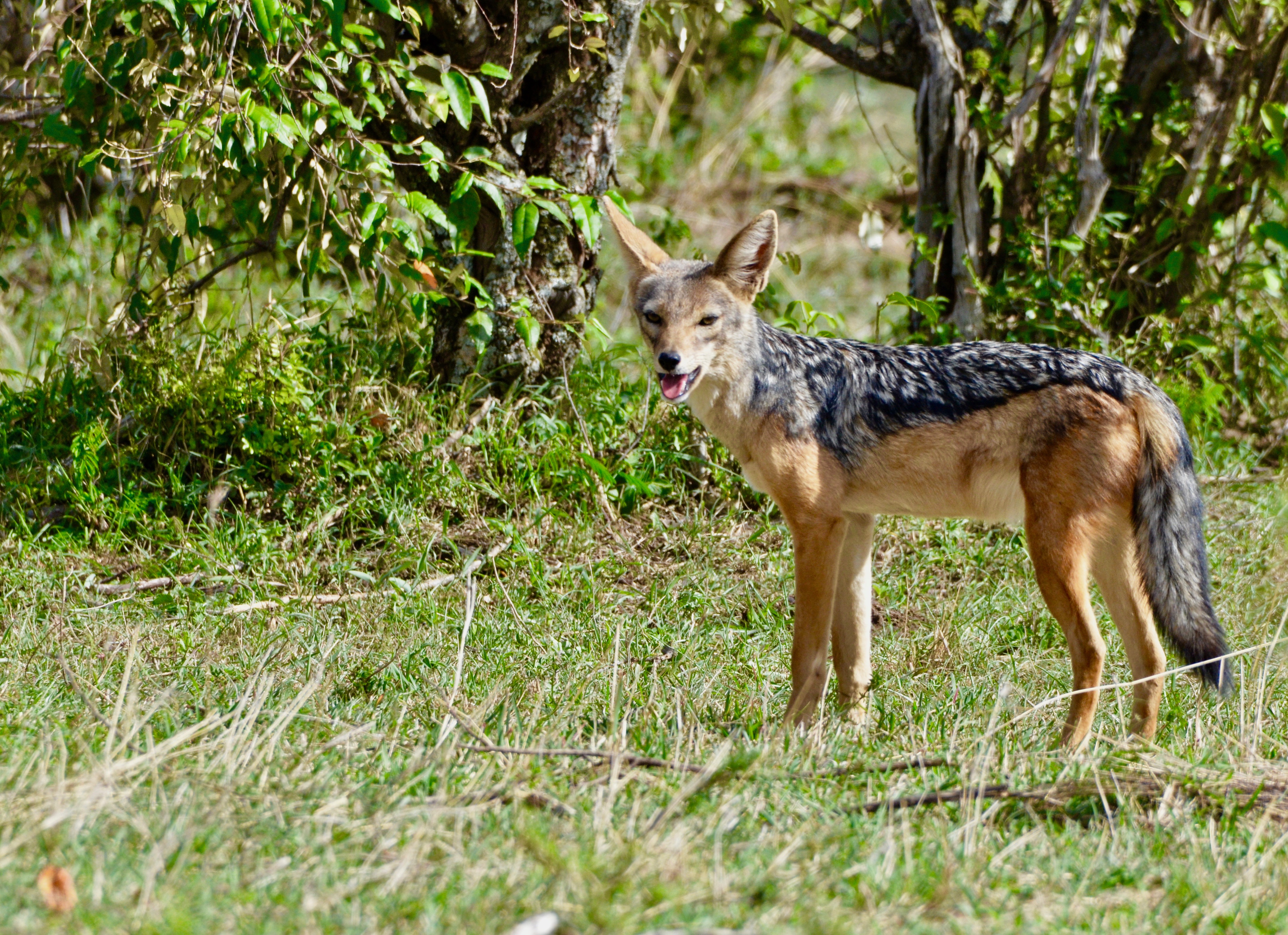
The third game drive brought more new sightings, but the best was a repeat of yesterday’s blood and guts, except that the players were different. The vanquished was a young wildebeest and the victor was a cheetah that had literally just started into its meal. Like the lions, the cheetah was starting from the inside out.
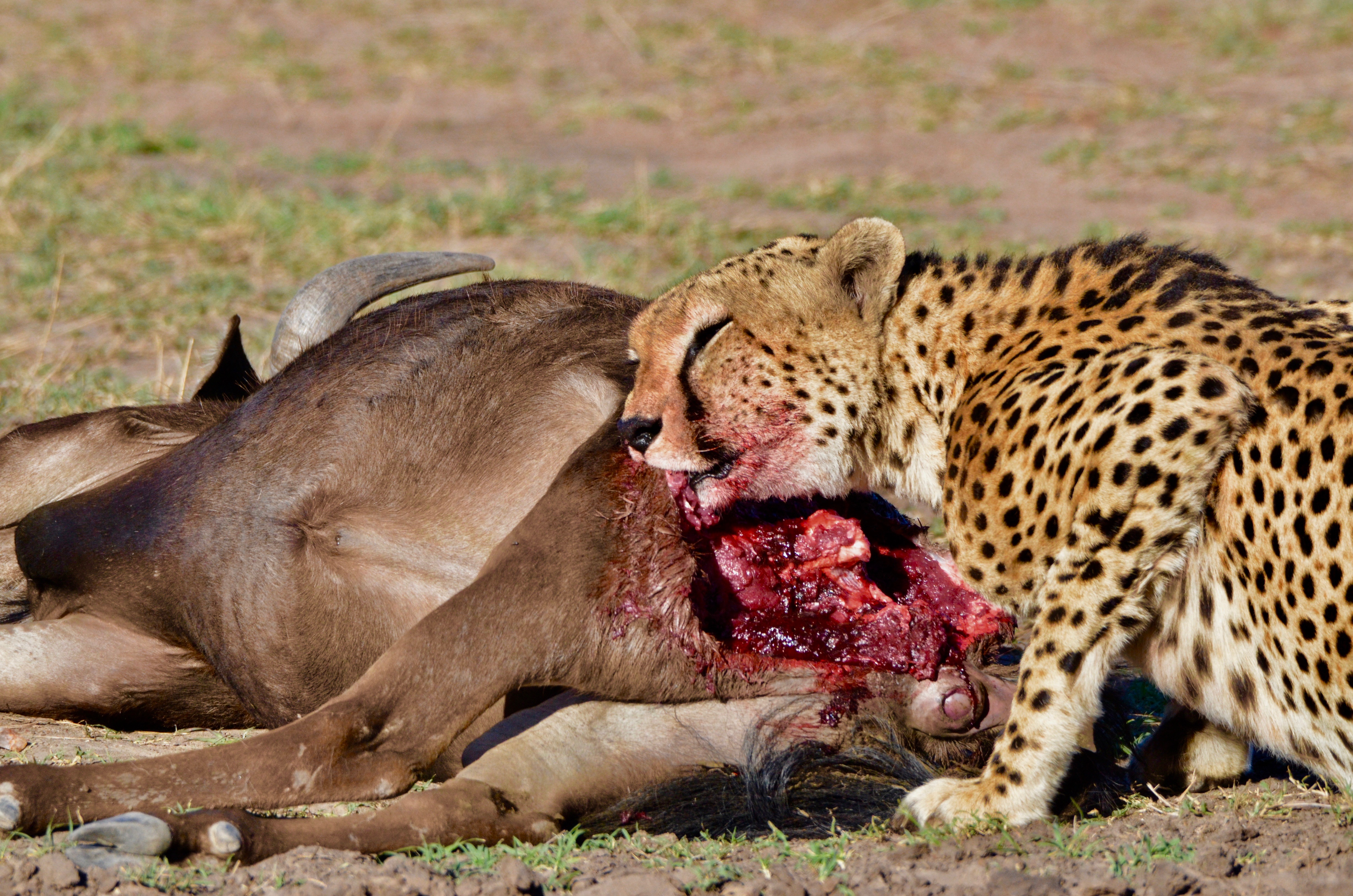
I always thought of cheetahs as considerably down the deadly threat ladder from lions, leopards and hyenas, but after seeing the size of the dead wildebeest there is no doubt that a cheetah could easily kill a human. That said, this fellow pulled his head up every few minutes to look around for hyenas or lions that could confiscate his kill.
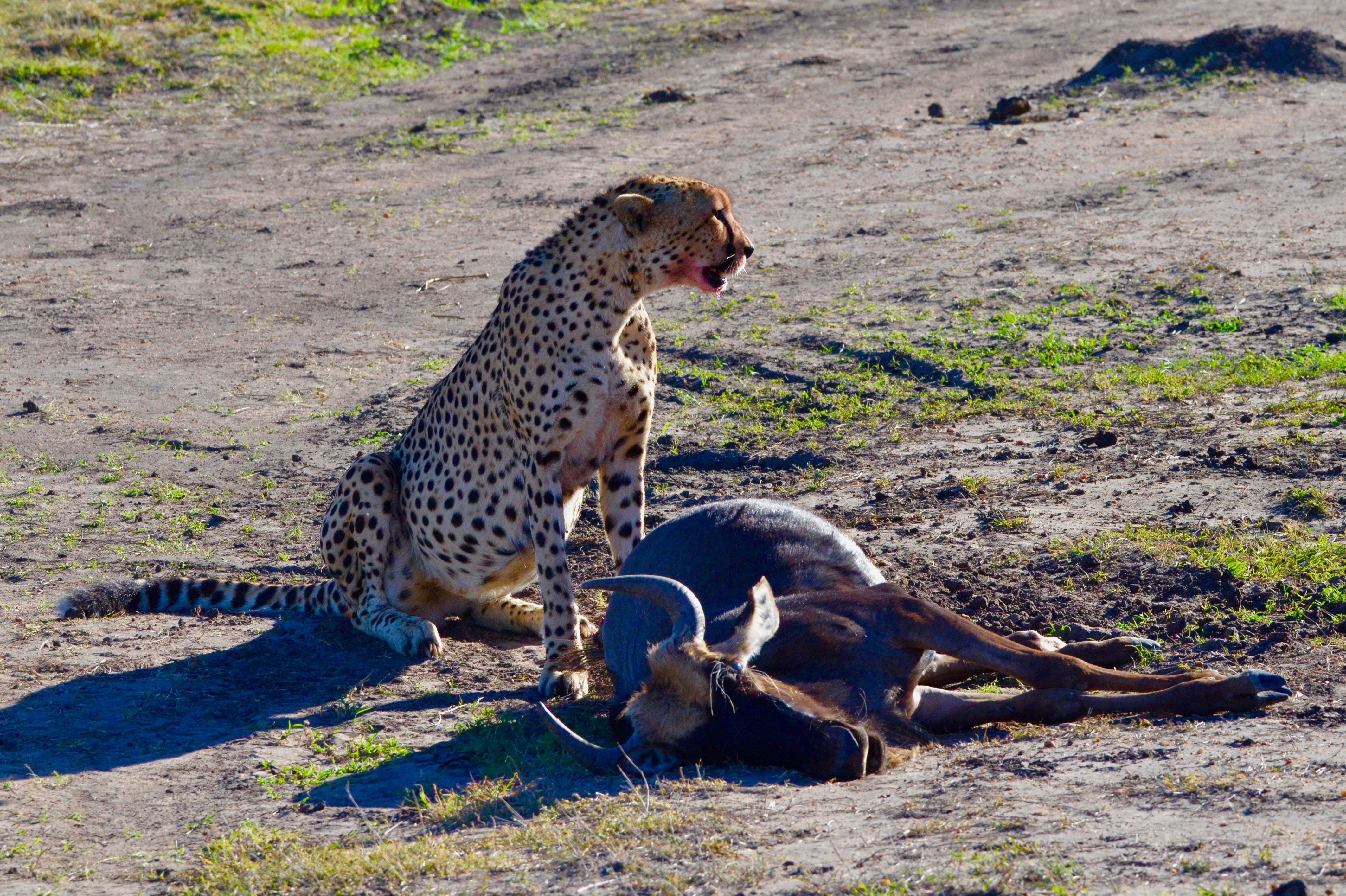
We returned to the scene of the cheetah kill near the end of this game drive and the only thing left was the head and skeleton. Three species of vulture had all gorged themselves after the cheetah departed. This was nature at its rawest and most macabre, but also an everyday occurrence on the Masai Mara.
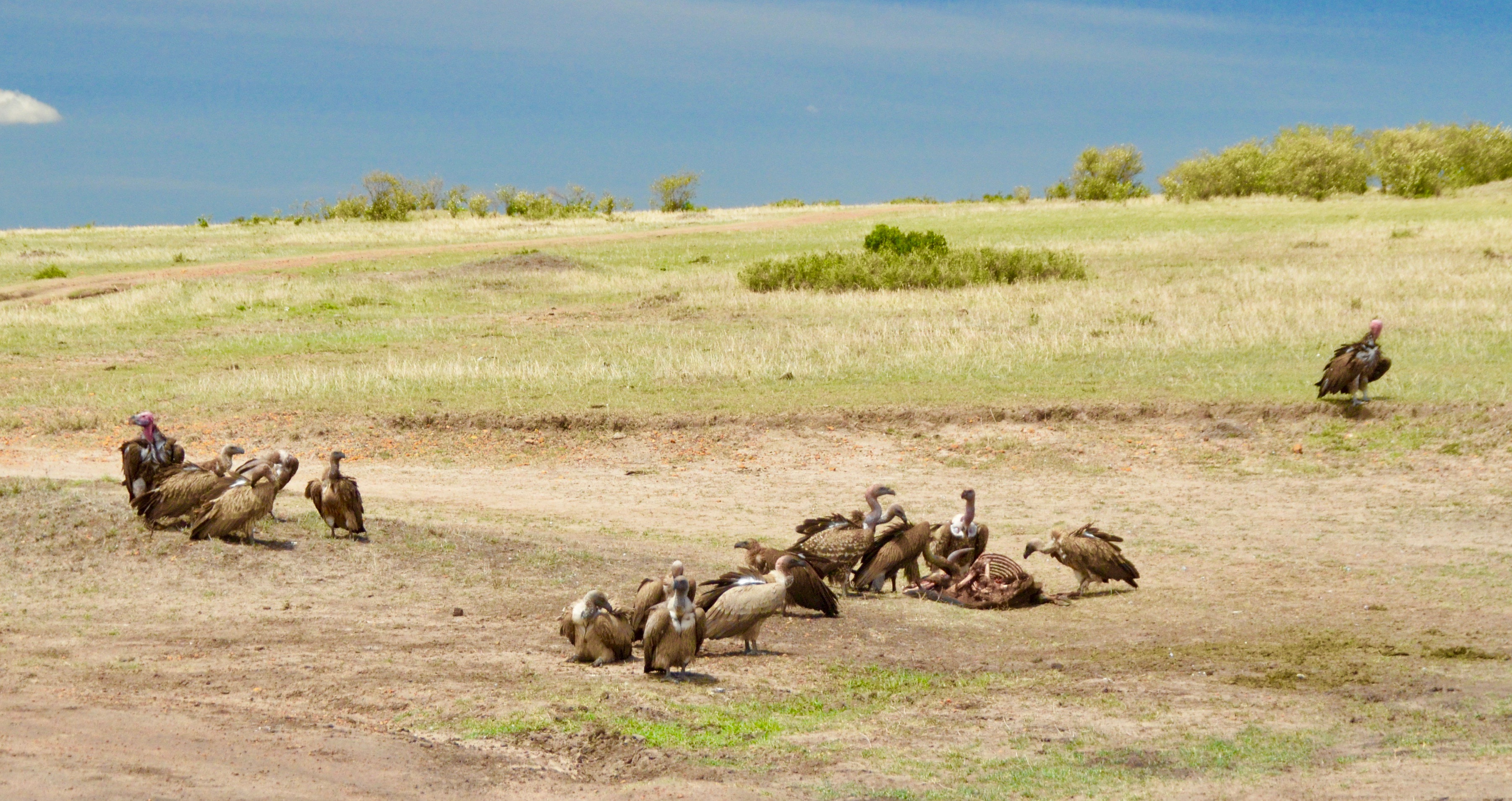
Not to be outdone we came across another lion kill, but by the time we arrived the lions were sated and docile.This time the victim was a Masai cow. Due to the ongoing drought in Kenya, the Masai are, at times, allowed to bring their cattle into the reserve, but then take the risk of losing a few to predators. A domesticated cow would be a huge attraction to a pride of lions – big, slow in relation to a wildebeest or zebra, dumb and no doubt, very tasty.
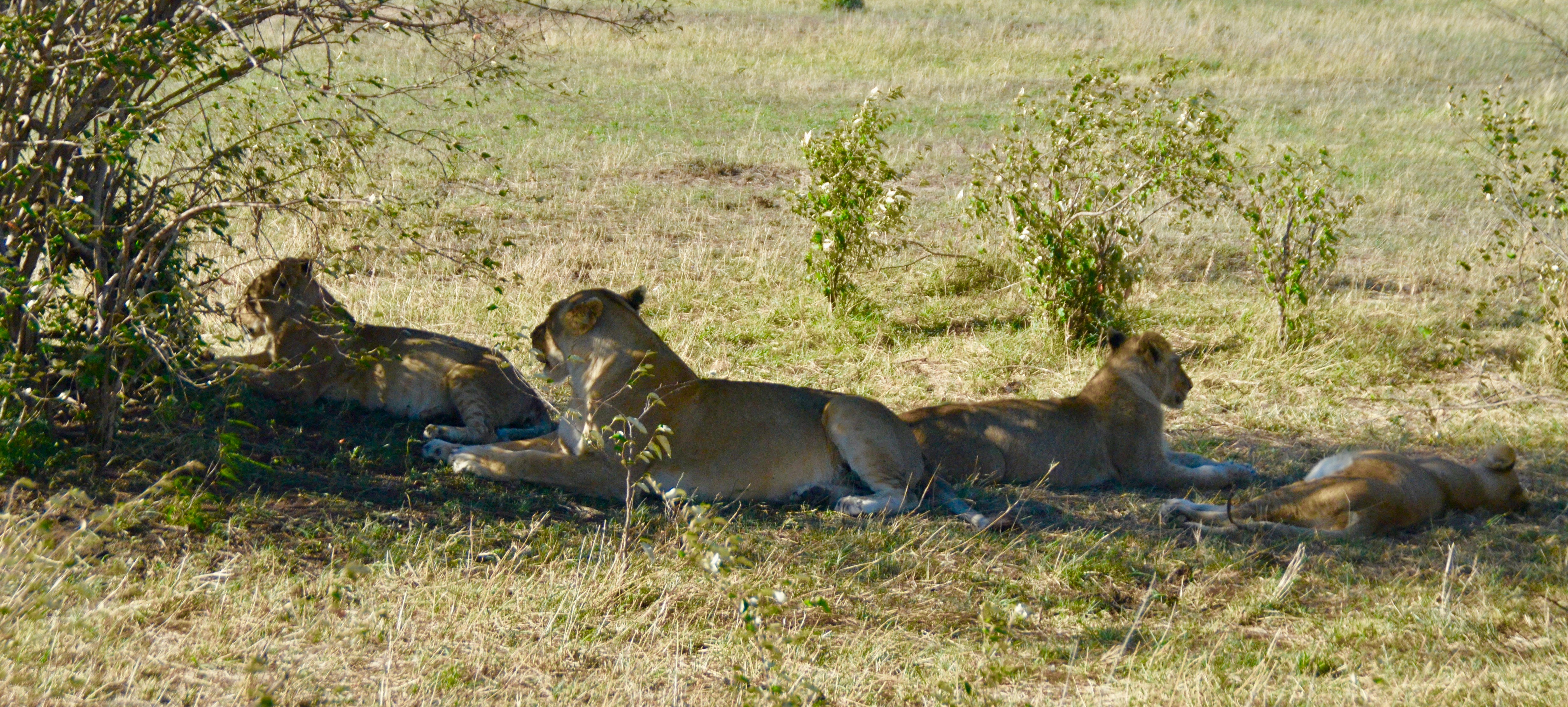
This lioness looks so contented she could be confused for a big, sweet puddy tat – that would be a mistake of epic proportions.
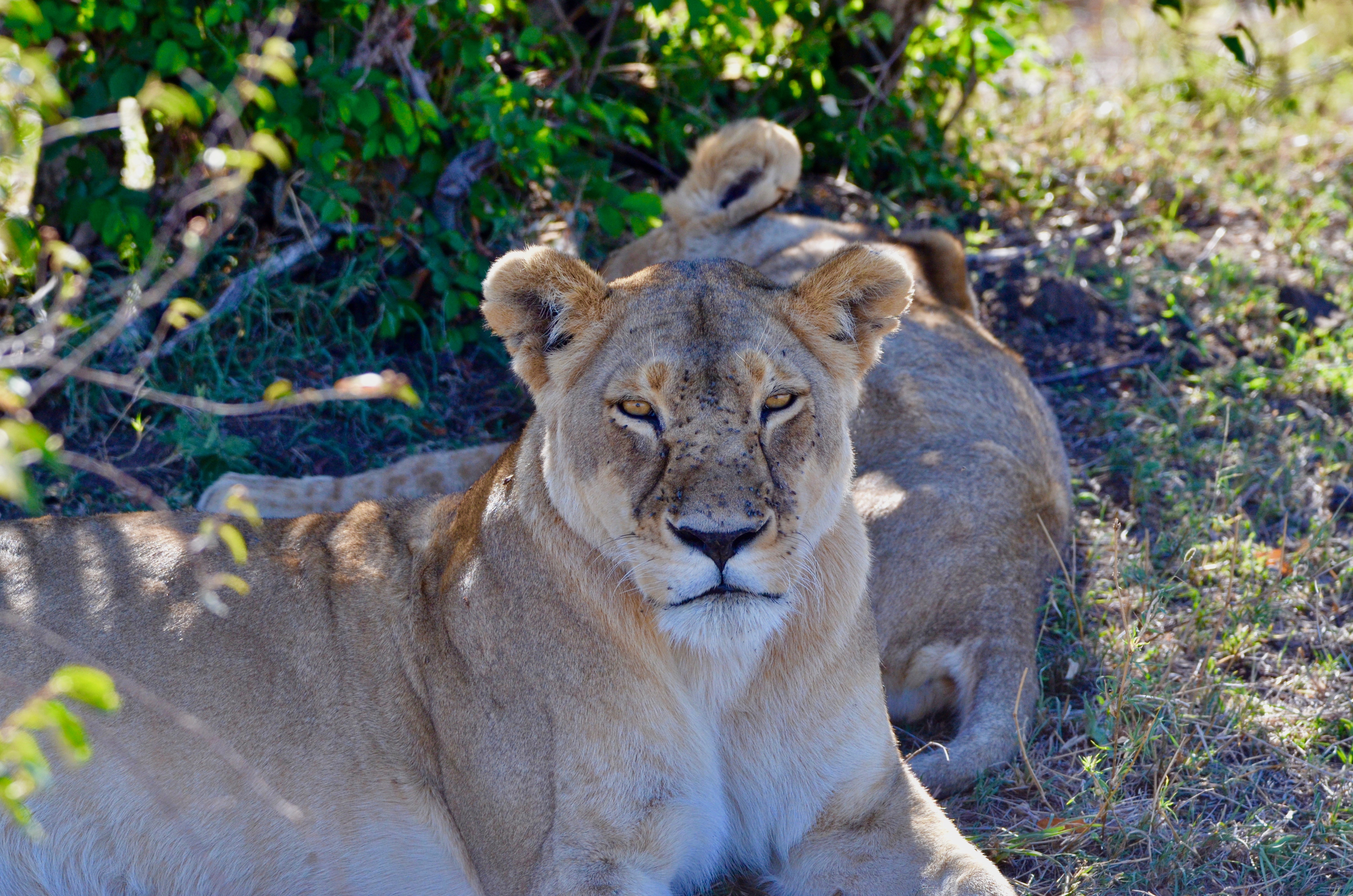
This morning’s game drive brought some new bird species including a red-billed hornbill.
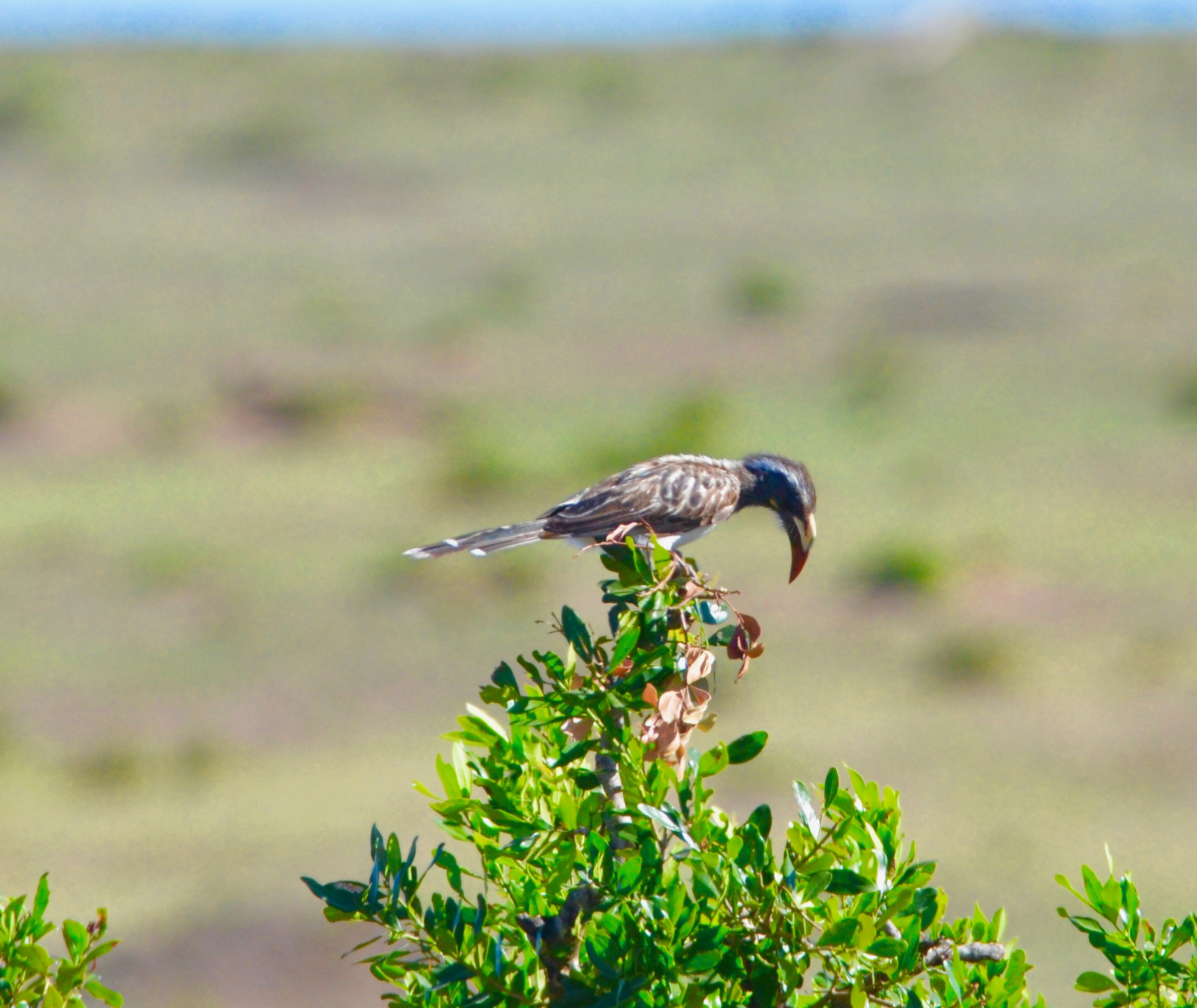
And the state bird of Kenya, the dazzling lilac-breasted roller.
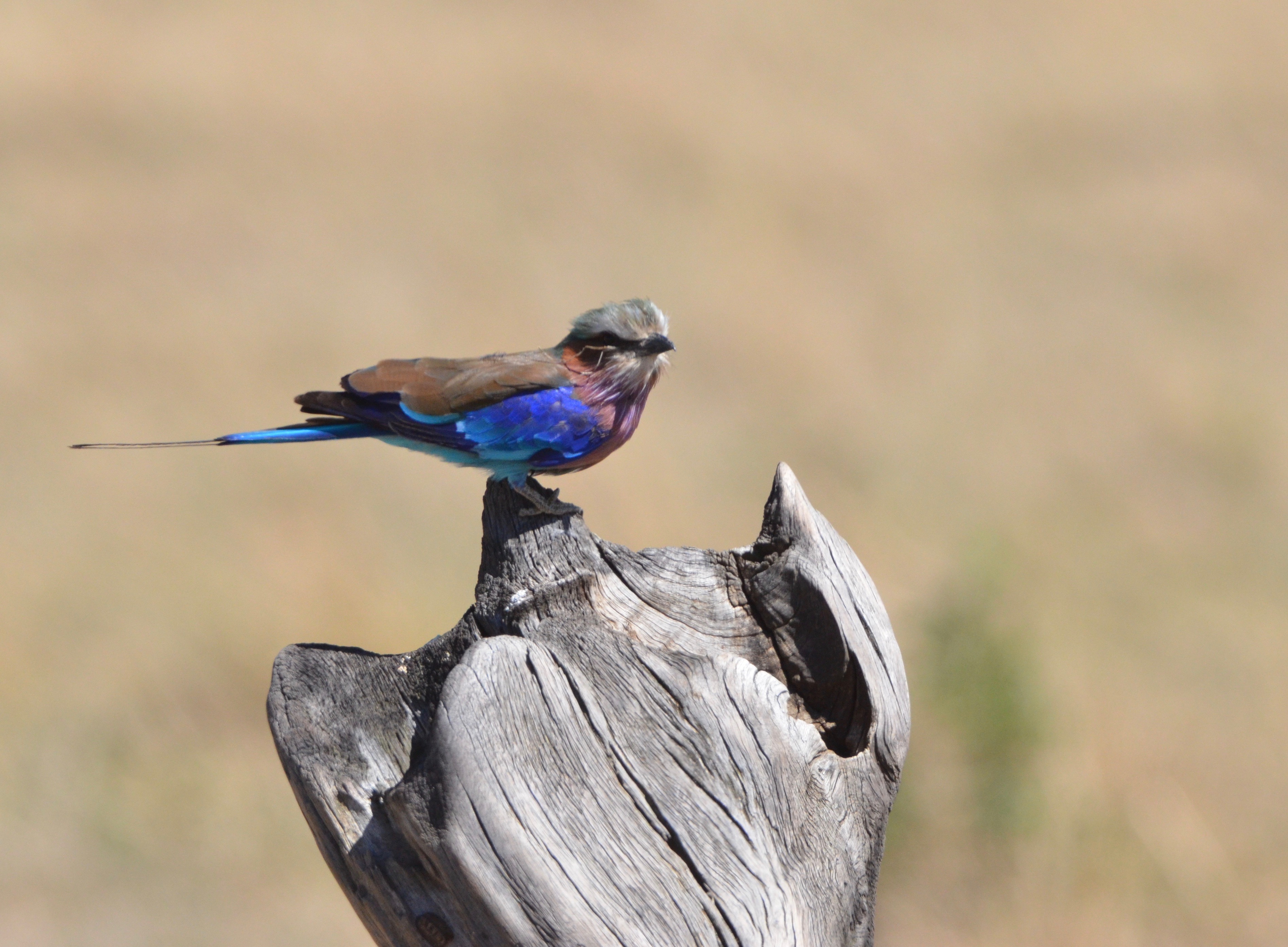
We came across two male lions, probably brothers, lazing in the shade. This is a picture of one of them looking directly at me from not more than 15 feet away. He could have been inside the open vehicle in a flash. For some reason, you know this is not going to happen and the absolute primal fear you would feel upon coming on a lion like this on foot, is not present. If it was, very few people would go on these safaris.
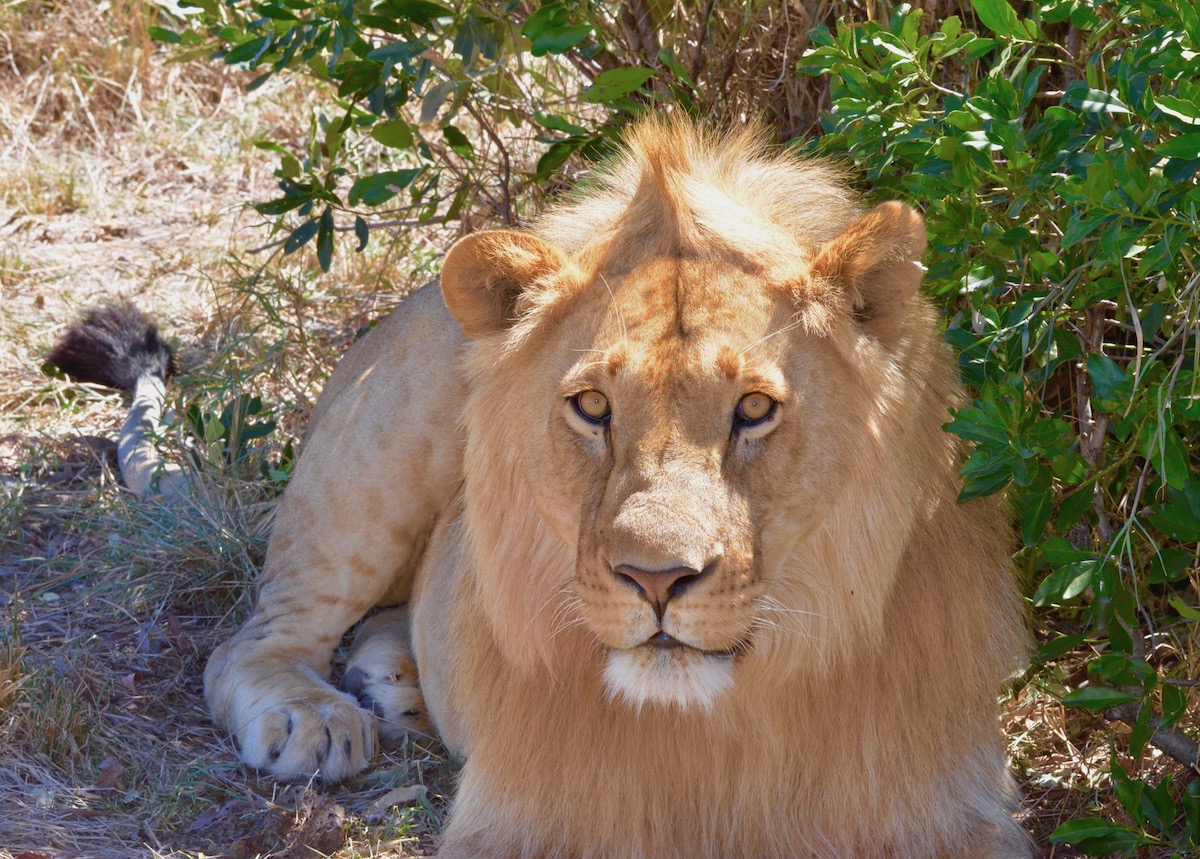
This was the only game drive that we saw a hippo out of the water. Normally their visits to dry land are nocturnal, but this lone giant was well away from the closest water, perhaps migrating from one river to another. Hippos are the most dangerous animal in Africa in terms of the number of people they actually kill. This guy did have a mean persona that definitely radiated, “Stay away!”.
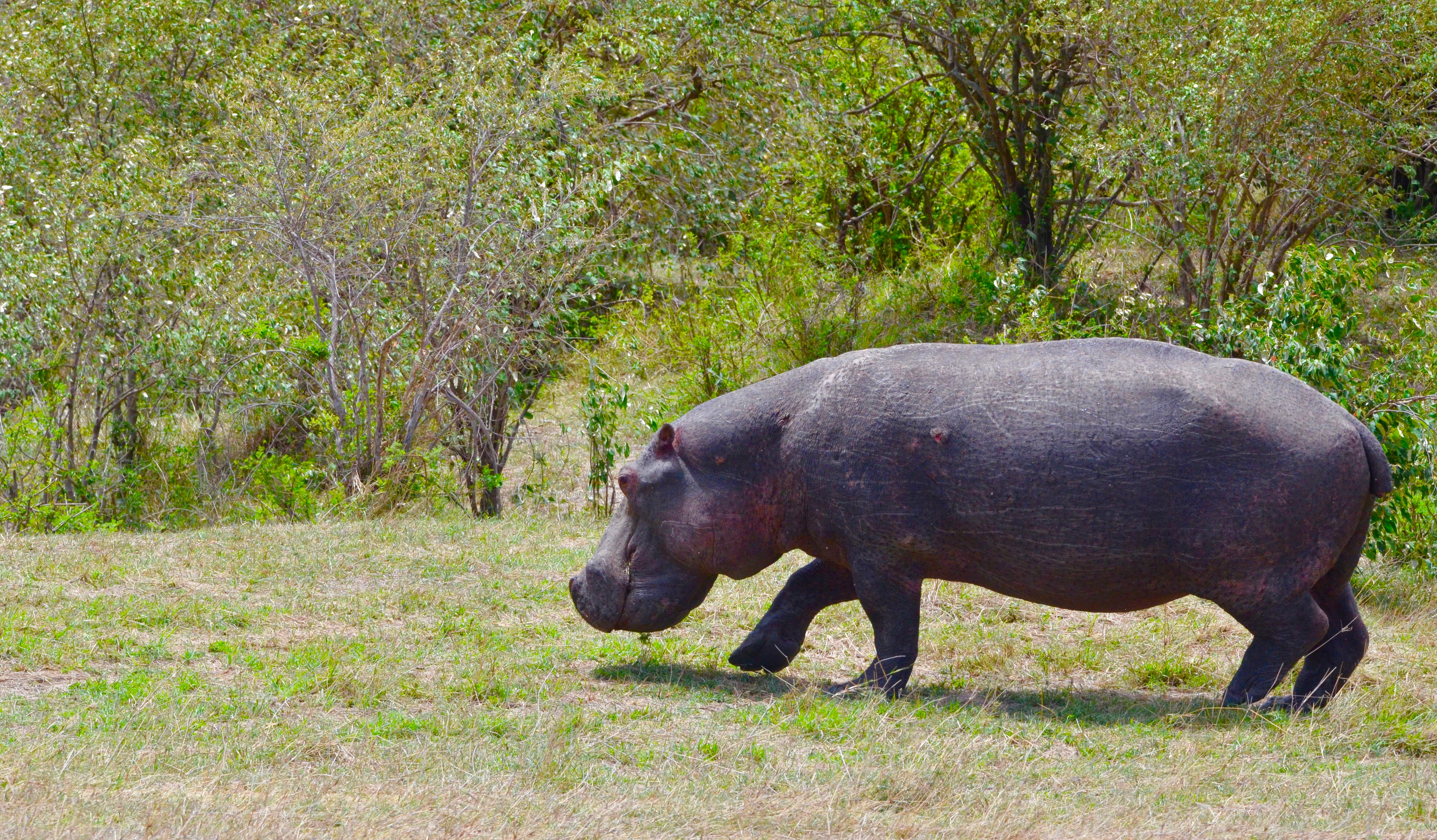
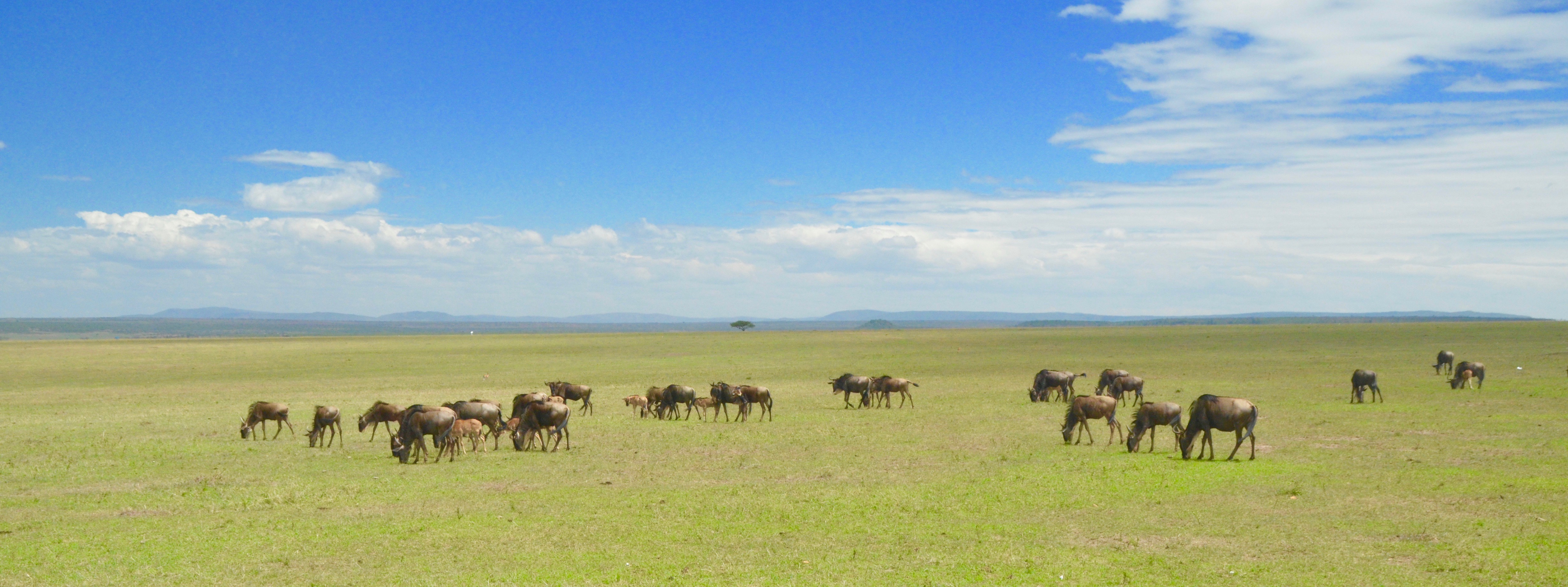
On this game drive we also saw the largest herds of wildebeest on the entire Kenya trip – nothing like during migration, but frankly, unless it’s just the sheer numbers that appeal, these were plenty of wildebeests for me.
I could add many more photos, but this post is already way too long, a tribute, I suppose, to how much there is to see and do in the Masai Mara. However, there is one more attraction I want to highlight and it has nothing to do with the animals.
Visiting a Masai Village
There are over forty distinct tribes in Kenya, maybe as many as seventy according to some authorities. Without doubt the most famous tribe are the Masai who are so culturally different from most of the other tribes that they have become a tourist attraction in and of themselves. There are a lot of myths about the Masai and just as many facts that are equally startling such as their drinking of cattle blood on ceremonial occasions. Have a look at this website created by the Maasai Association for more details on the issues that face the Masai today. The bottom line is that in any visit to the Masai Mara, the Masai people are an important part of the equation, even if they are not actually present in the reserve.
The road to Masai Mara from the nearest town of Narok is long, dusty and bumpy, but very interesting because of the Masai presence. This is a Masai common waterhole where they bring their cattle, sheep and goats to drink.
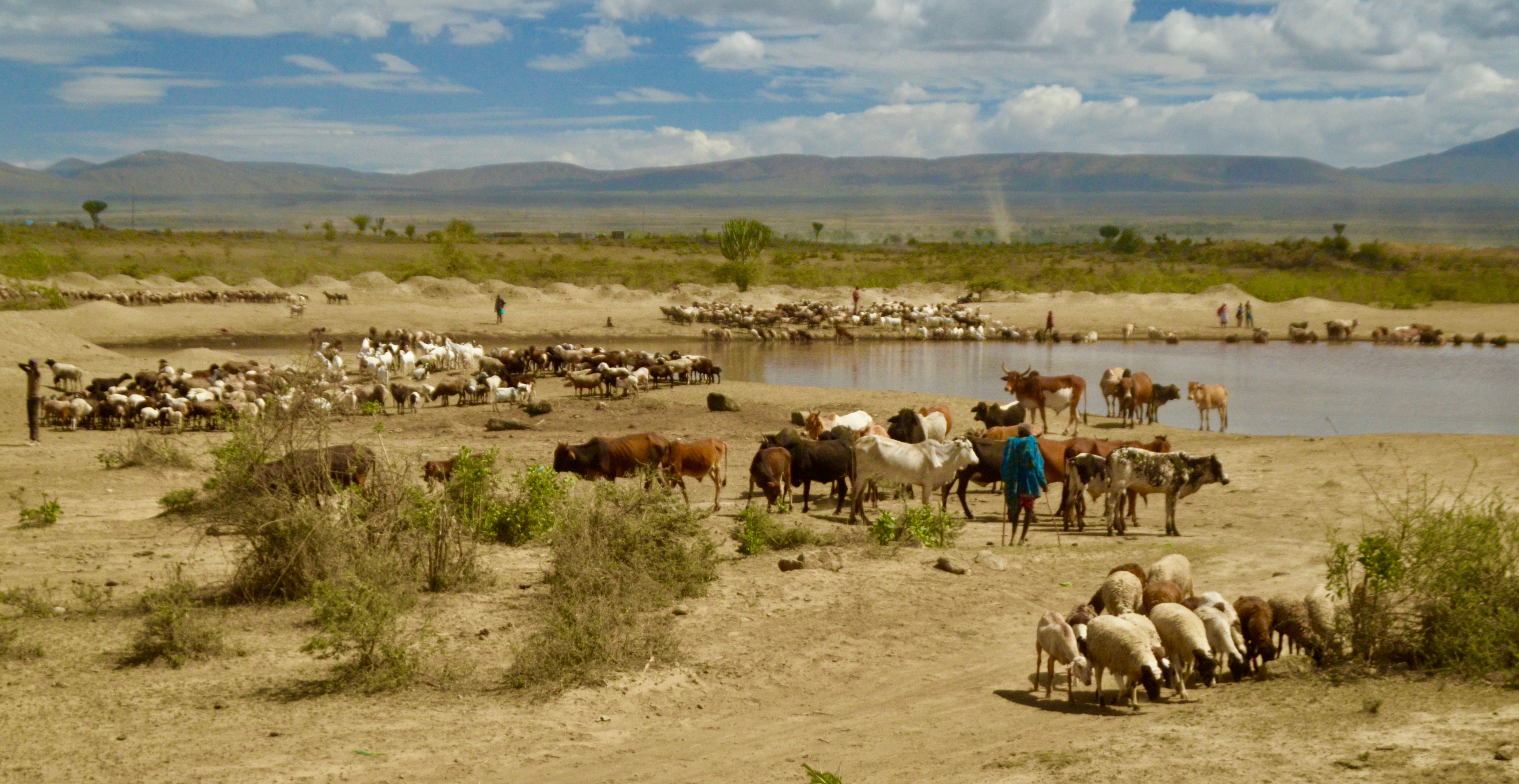
The closer to the reserve you get, the more small villages or kraals you come across and solitary men walking in what seems to be the middle of nowhere.
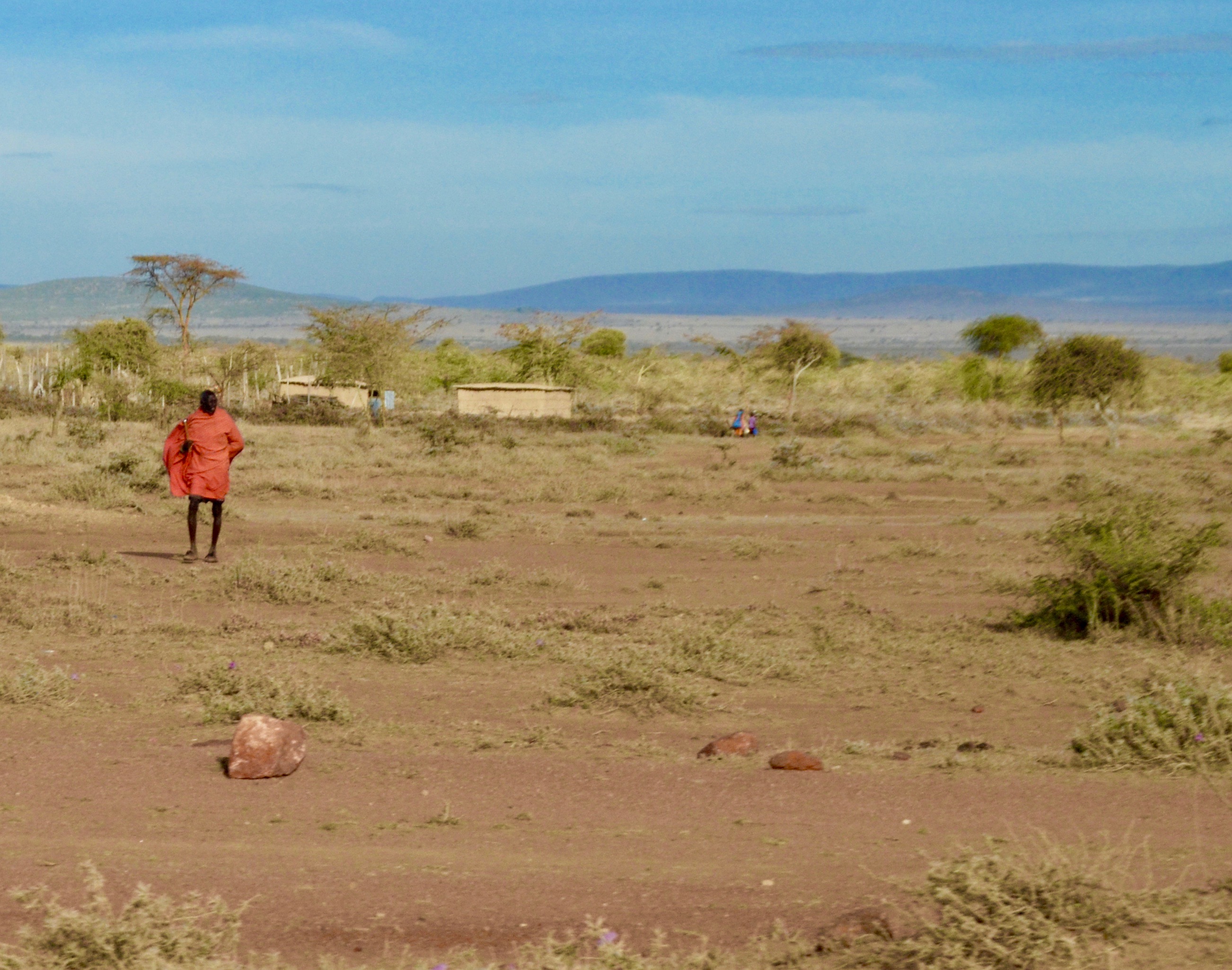
The trip to Masai Mara included a visit to a nearby Masai village and I have a confession to make – I didn’t go. I’m always uncomfortable with the idea of people as tourist attractions in and of themselves; the word exploitative comes to mind. I should have known better. Adventures Abroad is very sensitive to this issue and thankfully Alison did go and these are her pictures. For her it was one of the highlights of the entire trip.
This is the small village on the edge of the reserve. The homes are traditionally built in a circle which since the dawn of history has been a natural protective mode of security for humans and animals alike.
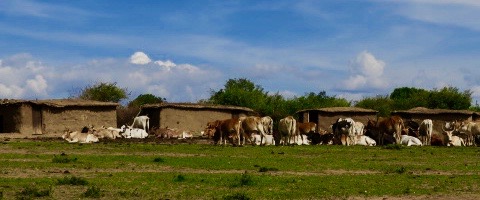
This is the chief’s nephew who acted as guide, and yes the Masai used the word ‘chief’ to describe the head elder. In full traditional regalia, he is a striking figure.
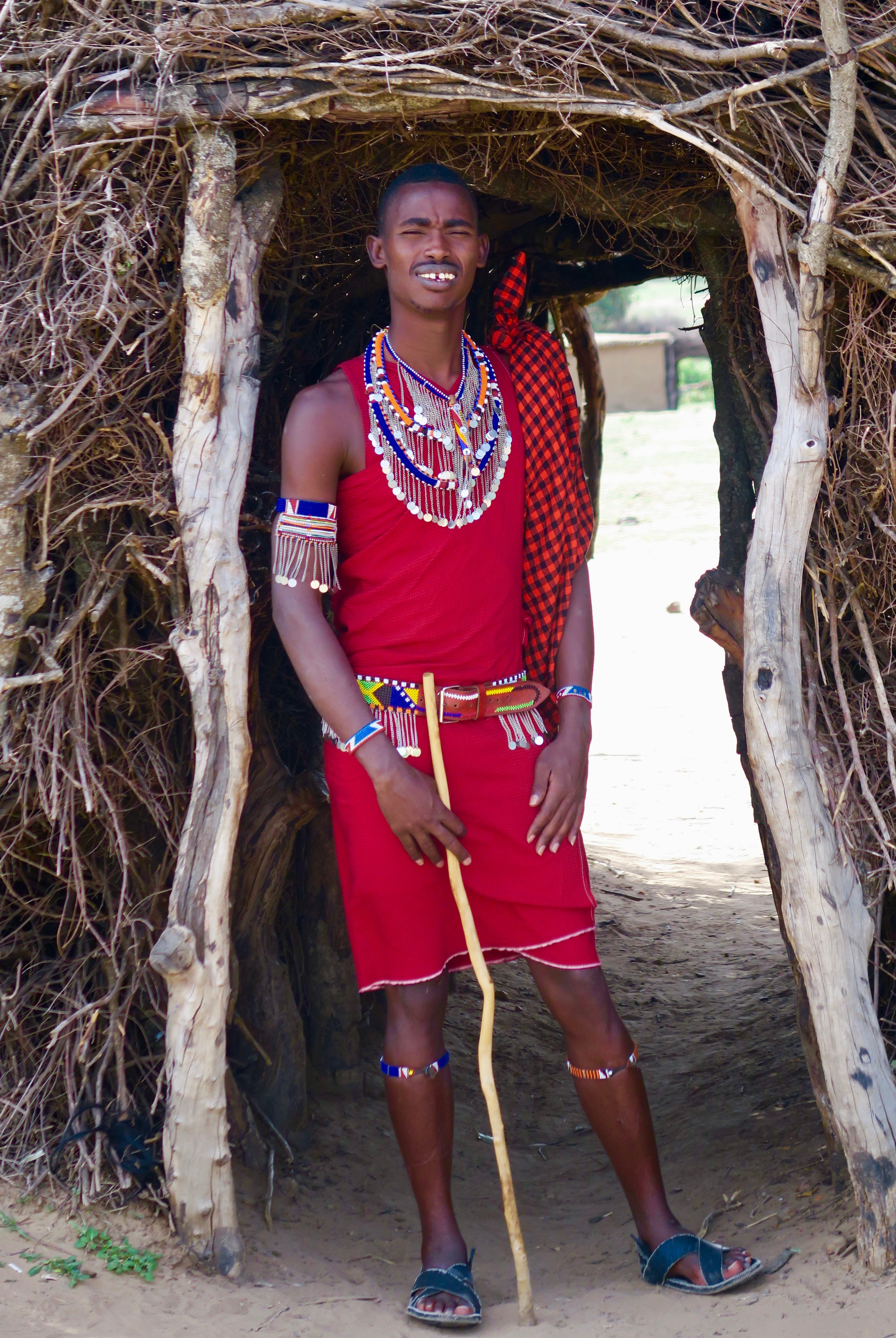
This was the village greeting party. Note that the men almost always carry small bamboo like sticks.

Despite living in what we would describe as poverty, each Masai man and woman has a collection of adornments that are second to none.
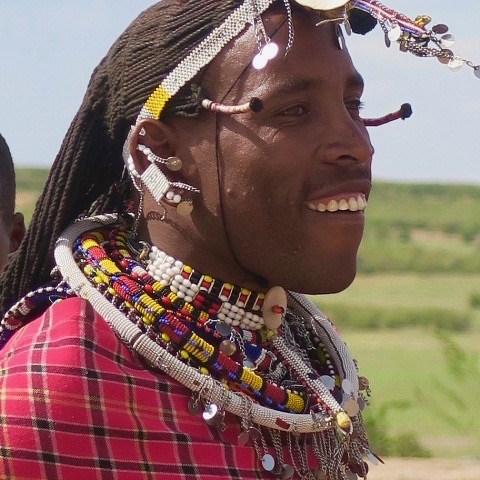
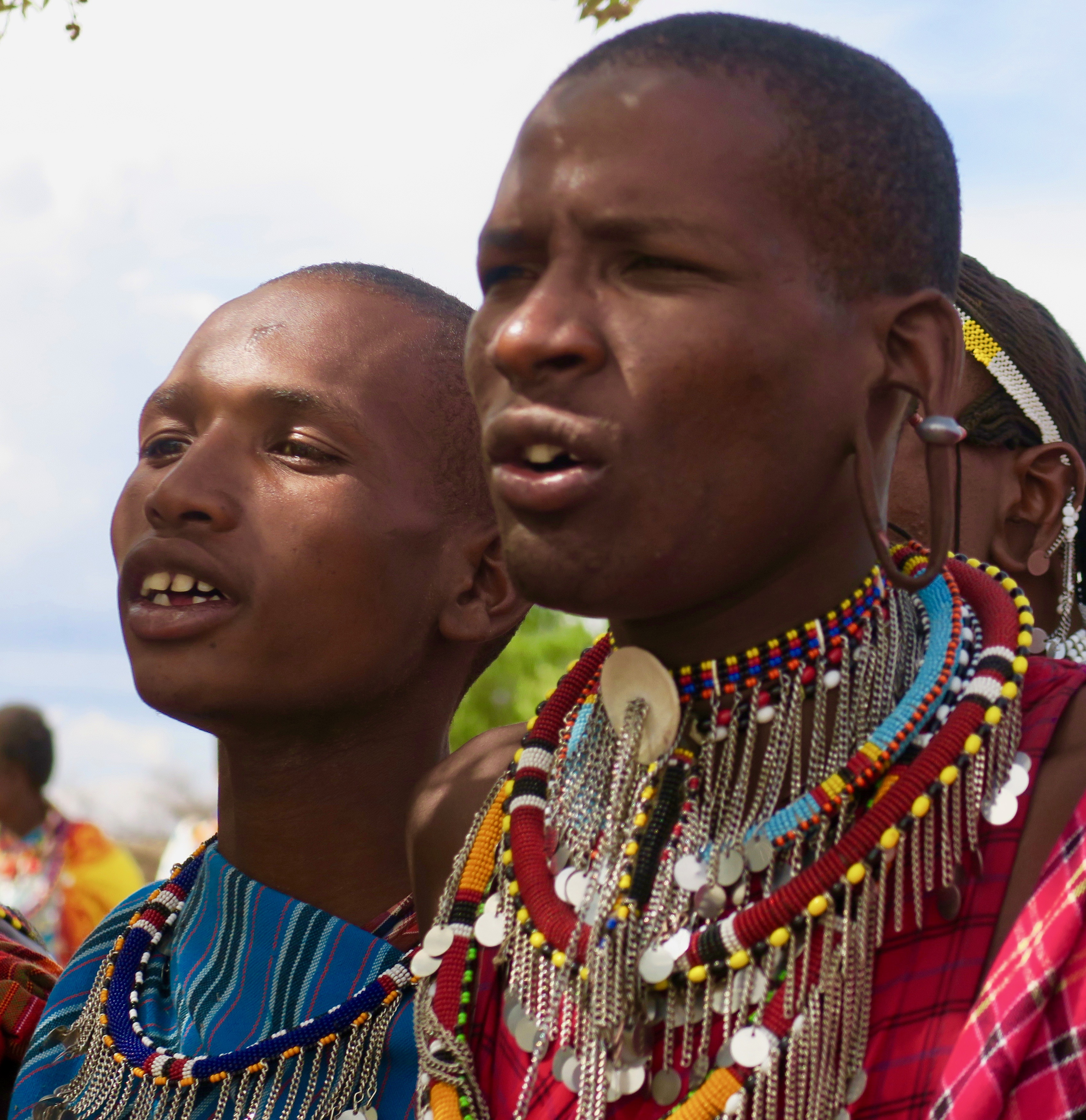
The Masai are perhaps best known for their ceremonial dancing which involves the men jumping higher and higher in a pre-modern version of the pogo. Alison said that the heights some of these guys reached was astonishing. This picture apparently does not do it justice.
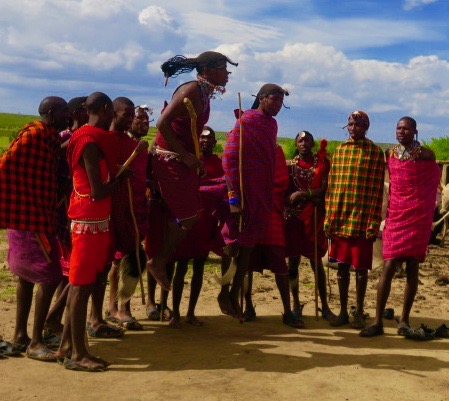
Perhaps a better insight into the Masai way of life are these children. Not dressed ceremonially or part of the ‘attraction’ they look well-nourished and well dressed – a far cry from the fly-specked faces of gaunt infants used to raise money by some questionable charities.
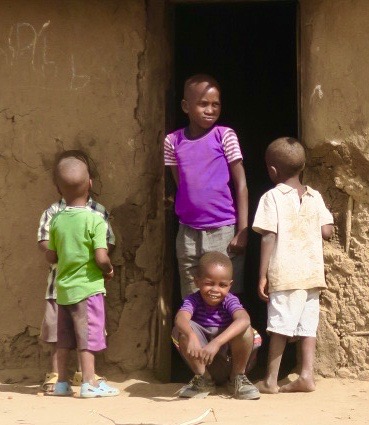
This is Alison with the chief and his nephew. Note the chief’s substantially superior walking stick. The Masai are well paid to host respectful tourists and Adventures Abroad is wise to include it in their Masai Mara itinerary.
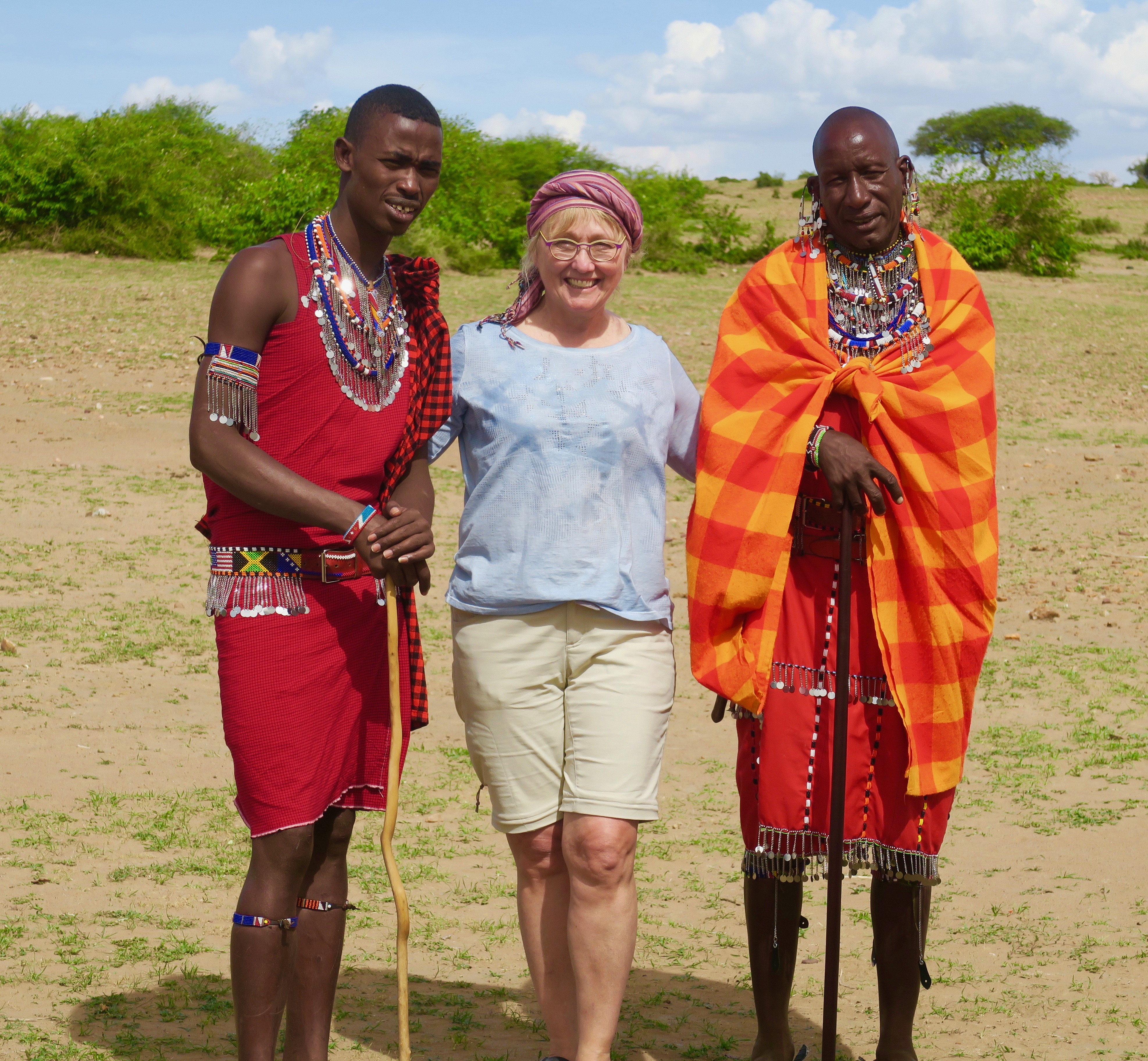
I hope this post has inspired you to put the Masai Mara high on your list of must-see destinations. You won’t regret it.
Here is a link to the Kenya photo gallery.

